Case Management Part 1: Working with Clients - Assessment Workbook 4B
VerifiedAdded on 2023/06/05
|84
|15955
|475
AI Summary
This Assessment Workbook 4B covers Case Management Part 1: Working with Clients for the CHC52015 Diploma of Community Services. It includes information on competency based assessment, assessment principles, reasonable adjustment, and assessment methods. The workbook uses knowledge assessments and case studies as assessment methods.
Contribute Materials
Your contribution can guide someone’s learning journey. Share your
documents today.
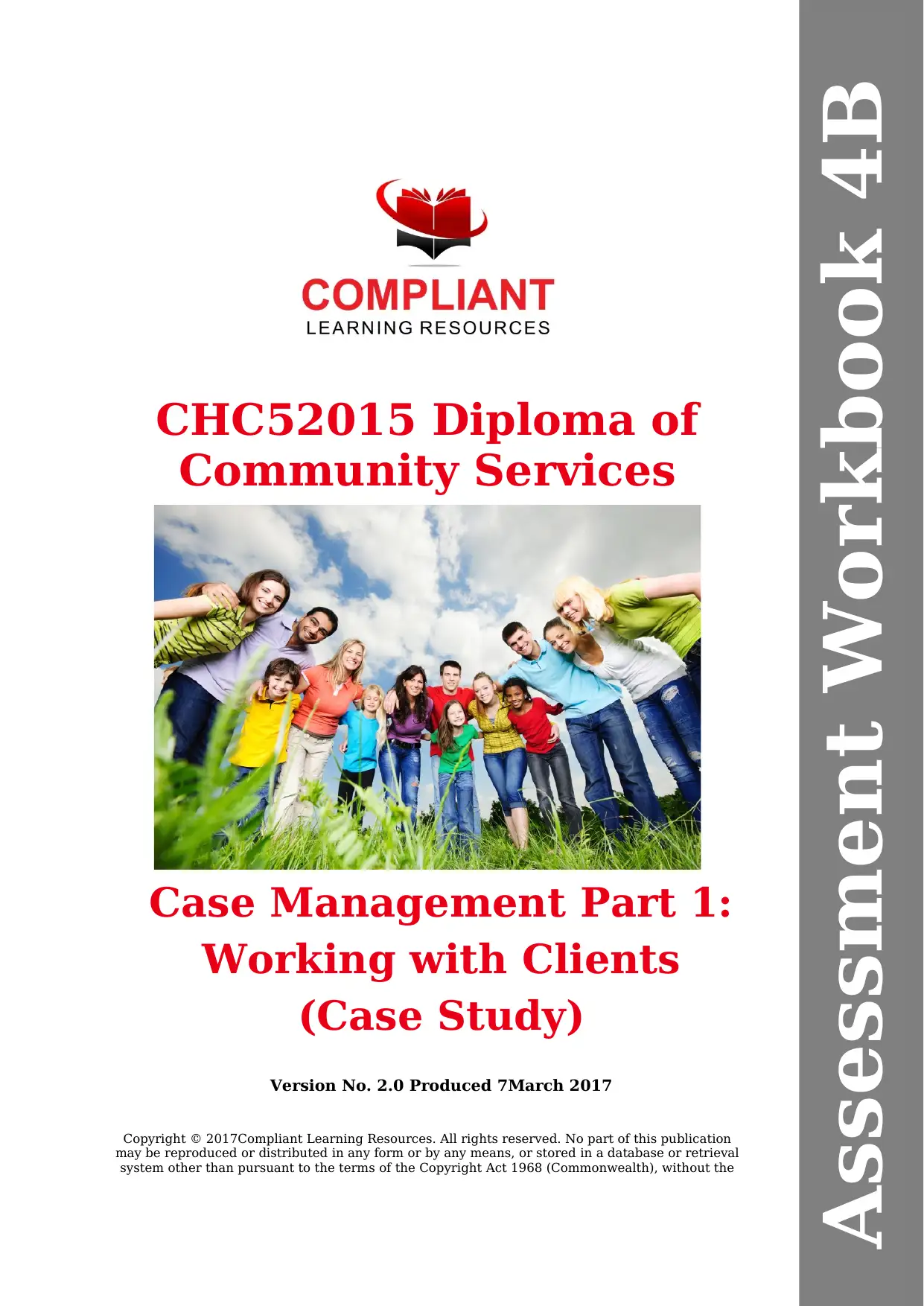
CHC52015 Diploma of
Community Services
Case Management Part 1:
Working with Clients
(Case Study)
Version No. 2.0 Produced 7March 2017
Copyright © 2017Compliant Learning Resources. All rights reserved. No part of this publication
may be reproduced or distributed in any form or by any means, or stored in a database or retrieval
system other than pursuant to the terms of the Copyright Act 1968 (Commonwealth), without the
Assessment Workbook 4B
Community Services
Case Management Part 1:
Working with Clients
(Case Study)
Version No. 2.0 Produced 7March 2017
Copyright © 2017Compliant Learning Resources. All rights reserved. No part of this publication
may be reproduced or distributed in any form or by any means, or stored in a database or retrieval
system other than pursuant to the terms of the Copyright Act 1968 (Commonwealth), without the
Assessment Workbook 4B
Secure Best Marks with AI Grader
Need help grading? Try our AI Grader for instant feedback on your assignments.
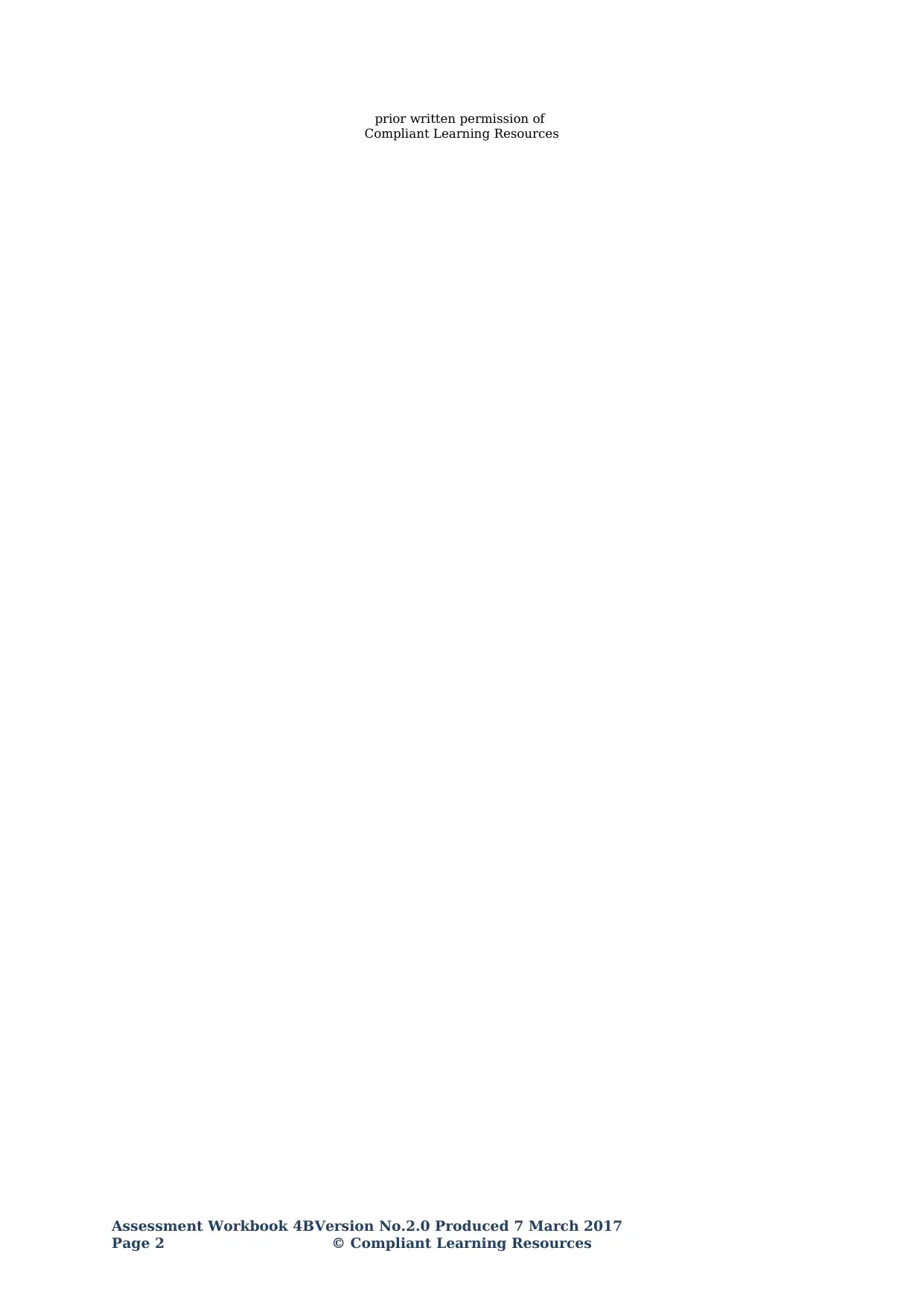
prior written permission of
Compliant Learning Resources
Assessment Workbook 4BVersion No.2.0 Produced 7 March 2017
Page 2 © Compliant Learning Resources
Compliant Learning Resources
Assessment Workbook 4BVersion No.2.0 Produced 7 March 2017
Page 2 © Compliant Learning Resources
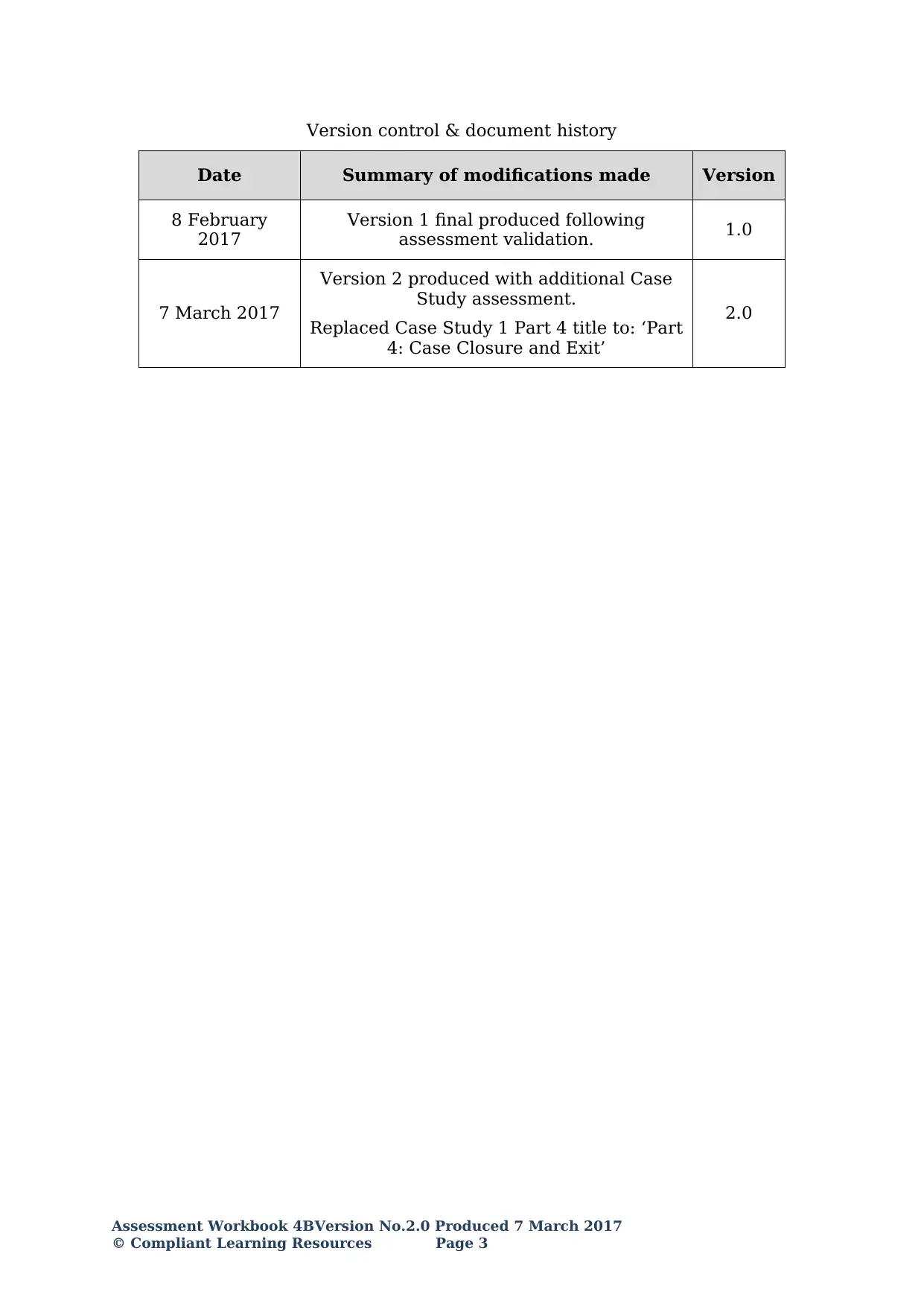
Version control & document history
Date Summary of modifications made Version
8 February
2017
Version 1 final produced following
assessment validation. 1.0
7 March 2017
Version 2 produced with additional Case
Study assessment.
Replaced Case Study 1 Part 4 title to: ‘Part
4: Case Closure and Exit’
2.0
Assessment Workbook 4BVersion No.2.0 Produced 7 March 2017
© Compliant Learning Resources Page 3
Date Summary of modifications made Version
8 February
2017
Version 1 final produced following
assessment validation. 1.0
7 March 2017
Version 2 produced with additional Case
Study assessment.
Replaced Case Study 1 Part 4 title to: ‘Part
4: Case Closure and Exit’
2.0
Assessment Workbook 4BVersion No.2.0 Produced 7 March 2017
© Compliant Learning Resources Page 3
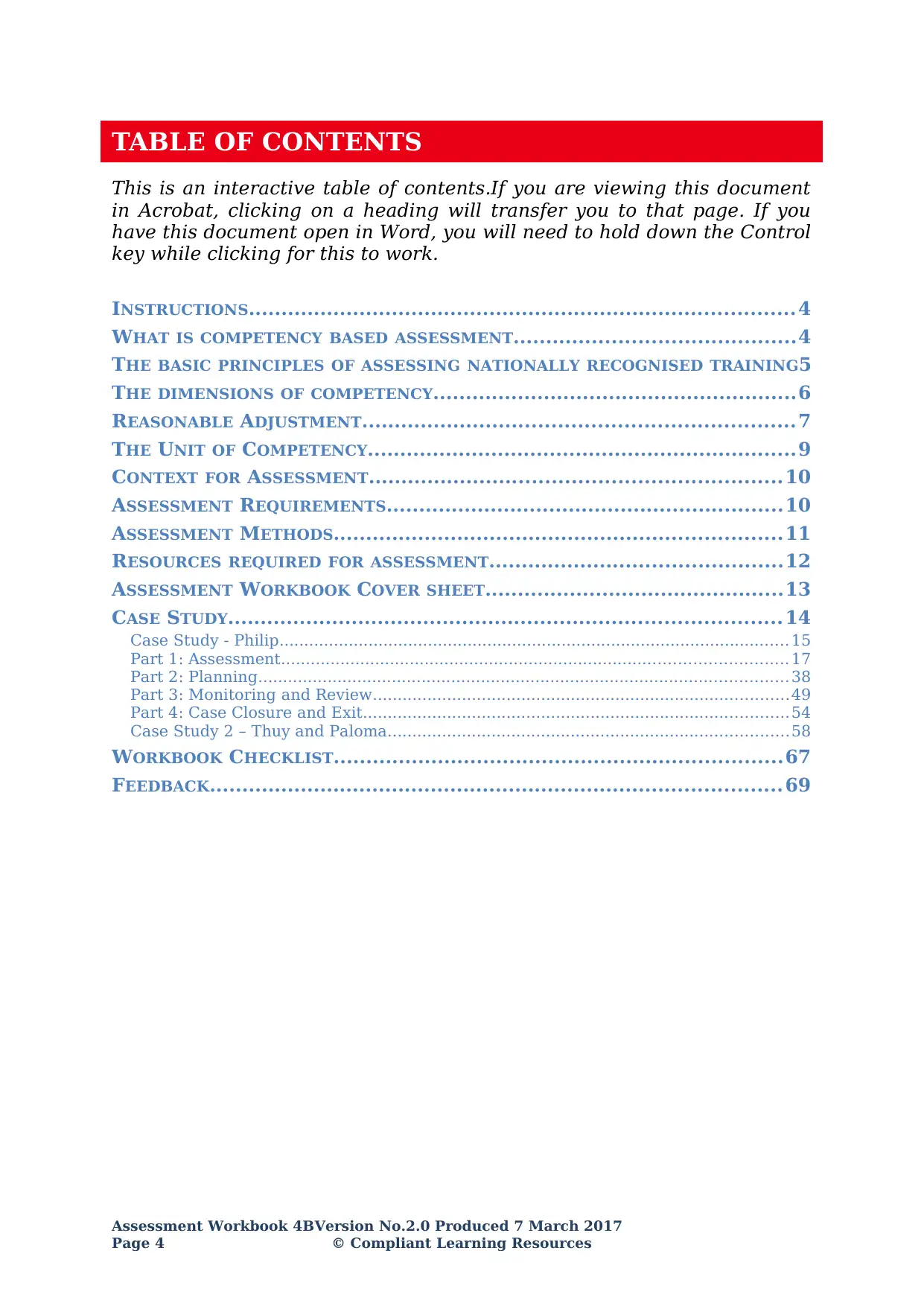
TABLE OF CONTENTS
This is an interactive table of contents.If you are viewing this document
in Acrobat, clicking on a heading will transfer you to that page. If you
have this document open in Word, you will need to hold down the Control
key while clicking for this to work.
INSTRUCTIONS....................................................................................4
WHAT IS COMPETENCY BASED ASSESSMENT...........................................4
THE BASIC PRINCIPLES OF ASSESSING NATIONALLY RECOGNISED TRAINING5
THE DIMENSIONS OF COMPETENCY........................................................6
REASONABLE ADJUSTMENT..................................................................7
THE UNIT OF COMPETENCY..................................................................9
CONTEXT FOR ASSESSMENT...............................................................10
ASSESSMENT REQUIREMENTS.............................................................10
ASSESSMENT METHODS.....................................................................11
RESOURCES REQUIRED FOR ASSESSMENT.............................................12
ASSESSMENT WORKBOOK COVER SHEET..............................................13
CASE STUDY..................................................................................... 14
Case Study - Philip....................................................................................................... 15
Part 1: Assessment...................................................................................................... 17
Part 2: Planning........................................................................................................... 38
Part 3: Monitoring and Review....................................................................................49
Part 4: Case Closure and Exit......................................................................................54
Case Study 2 – Thuy and Paloma.................................................................................58
WORKBOOK CHECKLIST.....................................................................67
FEEDBACK........................................................................................ 69
Assessment Workbook 4BVersion No.2.0 Produced 7 March 2017
Page 4 © Compliant Learning Resources
This is an interactive table of contents.If you are viewing this document
in Acrobat, clicking on a heading will transfer you to that page. If you
have this document open in Word, you will need to hold down the Control
key while clicking for this to work.
INSTRUCTIONS....................................................................................4
WHAT IS COMPETENCY BASED ASSESSMENT...........................................4
THE BASIC PRINCIPLES OF ASSESSING NATIONALLY RECOGNISED TRAINING5
THE DIMENSIONS OF COMPETENCY........................................................6
REASONABLE ADJUSTMENT..................................................................7
THE UNIT OF COMPETENCY..................................................................9
CONTEXT FOR ASSESSMENT...............................................................10
ASSESSMENT REQUIREMENTS.............................................................10
ASSESSMENT METHODS.....................................................................11
RESOURCES REQUIRED FOR ASSESSMENT.............................................12
ASSESSMENT WORKBOOK COVER SHEET..............................................13
CASE STUDY..................................................................................... 14
Case Study - Philip....................................................................................................... 15
Part 1: Assessment...................................................................................................... 17
Part 2: Planning........................................................................................................... 38
Part 3: Monitoring and Review....................................................................................49
Part 4: Case Closure and Exit......................................................................................54
Case Study 2 – Thuy and Paloma.................................................................................58
WORKBOOK CHECKLIST.....................................................................67
FEEDBACK........................................................................................ 69
Assessment Workbook 4BVersion No.2.0 Produced 7 March 2017
Page 4 © Compliant Learning Resources
Secure Best Marks with AI Grader
Need help grading? Try our AI Grader for instant feedback on your assignments.

INSTRUCTIONS
The questions covered in the Case Studies assessment require creative
and analytical thought processes.You must answer all questions using
your own words.However, you may reference your learner guide and
other relevant resources and learning materials to complete this
assessment.
Some questions cover processes you would likely encounter in a
workplace. Ideally, you should be able to answer these questions based
on the processes that are currently in place in your workplace. If this is
not the case, then answer the questions based on processes that should
be implemented in your workplace.
WHAT IS COMPETENCY BASED ASSESSMENT
The features of a competency based assessment system are:
It is focused on what learners can do and whether it meets the
criteria specified by industry as competency standards.
Assessment should mirror the environment the learner will
encounter in the workplace.
Assessment criteria should be clearly stated to the learner at
the beginning of the learning process.
Assessment should be holistic. That is it aims to assess as
many elements and/or units of competency as is feasible at
one time.
In competency assessment a learner receives one of only two
outcomes – competent or not yet competent.
The basis of assessment is in applying knowledge for some
purpose. In a competency system, knowledge for the sake of
knowledge is seen to be ineffectual unless it assists a person
to perform a task to the level required in the workplace.
The emphasis in assessment is on assessable outcomes that
are clearly stated for the trainer and learner. Assessable
outcomes are tied to the relevant industry competency
standards where these exist. Where such competencies do
Assessment Workbook 4BVersion No.2.0 Produced 7 March 2017
© Compliant Learning Resources Page 5
The questions covered in the Case Studies assessment require creative
and analytical thought processes.You must answer all questions using
your own words.However, you may reference your learner guide and
other relevant resources and learning materials to complete this
assessment.
Some questions cover processes you would likely encounter in a
workplace. Ideally, you should be able to answer these questions based
on the processes that are currently in place in your workplace. If this is
not the case, then answer the questions based on processes that should
be implemented in your workplace.
WHAT IS COMPETENCY BASED ASSESSMENT
The features of a competency based assessment system are:
It is focused on what learners can do and whether it meets the
criteria specified by industry as competency standards.
Assessment should mirror the environment the learner will
encounter in the workplace.
Assessment criteria should be clearly stated to the learner at
the beginning of the learning process.
Assessment should be holistic. That is it aims to assess as
many elements and/or units of competency as is feasible at
one time.
In competency assessment a learner receives one of only two
outcomes – competent or not yet competent.
The basis of assessment is in applying knowledge for some
purpose. In a competency system, knowledge for the sake of
knowledge is seen to be ineffectual unless it assists a person
to perform a task to the level required in the workplace.
The emphasis in assessment is on assessable outcomes that
are clearly stated for the trainer and learner. Assessable
outcomes are tied to the relevant industry competency
standards where these exist. Where such competencies do
Assessment Workbook 4BVersion No.2.0 Produced 7 March 2017
© Compliant Learning Resources Page 5

not exist, the outcomes are based upon those identified in a
training needs analysis.
Assessment Workbook 4BVersion No.2.0 Produced 7 March 2017
Page 6 © Compliant Learning Resources
training needs analysis.
Assessment Workbook 4BVersion No.2.0 Produced 7 March 2017
Page 6 © Compliant Learning Resources

Definition of competency
Assessment in this context can be defined as:
The fair, valid, reliable and flexible gathering and recording of
evidence to support judgement on whether competence has
been achieved. Skills and knowledge (developed either in a
structured learning situation, at work, or in some other
context) are assessed against national standards of
competence required by industry, rather than compared with
the skills and knowledge of other learners.
THE BASIC PRINCIPLES OF ASSESSING
NATIONALLY RECOGNISED TRAINING
Developing and conducing assessment, in an Australian vocational
education and training context, is founded on a number of basic
conventions:
The principles of assessment
Assessment must be valid
o Assessment must include the full range of skills and
knowledge needed to demonstrate competency.
o Assessment must include the combination of knowledge
and skills with their practical application.
o Assessment, where possible, must include judgements
based on evidence drawn from a number of occasions and
across a number of contexts.
Assessment must be reliable
o Assessment must be reliable and must be regularly
reviewed to ensure that assessors are making decisions in
a consistent manner.
o Assessors must be trained in national competency
standards for assessors to ensure reliability.
Assessment must be flexible
o Assessment, where possible, must cover both the on and
off-the-job components of training within a course.
Assessment Workbook 4BVersion No.2.0 Produced 7 March 2017
© Compliant Learning Resources Page 7
Assessment in this context can be defined as:
The fair, valid, reliable and flexible gathering and recording of
evidence to support judgement on whether competence has
been achieved. Skills and knowledge (developed either in a
structured learning situation, at work, or in some other
context) are assessed against national standards of
competence required by industry, rather than compared with
the skills and knowledge of other learners.
THE BASIC PRINCIPLES OF ASSESSING
NATIONALLY RECOGNISED TRAINING
Developing and conducing assessment, in an Australian vocational
education and training context, is founded on a number of basic
conventions:
The principles of assessment
Assessment must be valid
o Assessment must include the full range of skills and
knowledge needed to demonstrate competency.
o Assessment must include the combination of knowledge
and skills with their practical application.
o Assessment, where possible, must include judgements
based on evidence drawn from a number of occasions and
across a number of contexts.
Assessment must be reliable
o Assessment must be reliable and must be regularly
reviewed to ensure that assessors are making decisions in
a consistent manner.
o Assessors must be trained in national competency
standards for assessors to ensure reliability.
Assessment must be flexible
o Assessment, where possible, must cover both the on and
off-the-job components of training within a course.
Assessment Workbook 4BVersion No.2.0 Produced 7 March 2017
© Compliant Learning Resources Page 7
Paraphrase This Document
Need a fresh take? Get an instant paraphrase of this document with our AI Paraphraser
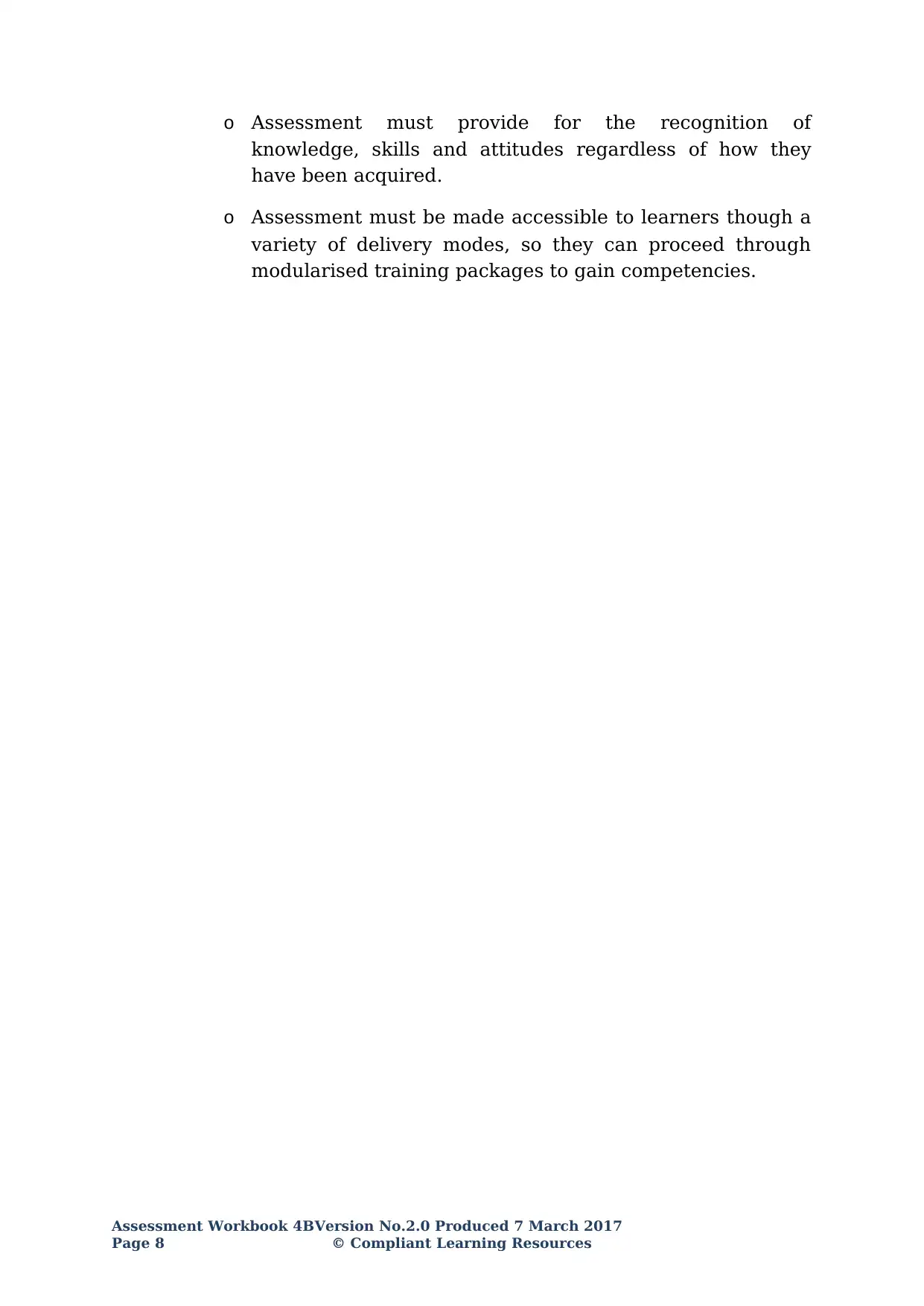
o Assessment must provide for the recognition of
knowledge, skills and attitudes regardless of how they
have been acquired.
o Assessment must be made accessible to learners though a
variety of delivery modes, so they can proceed through
modularised training packages to gain competencies.
Assessment Workbook 4BVersion No.2.0 Produced 7 March 2017
Page 8 © Compliant Learning Resources
knowledge, skills and attitudes regardless of how they
have been acquired.
o Assessment must be made accessible to learners though a
variety of delivery modes, so they can proceed through
modularised training packages to gain competencies.
Assessment Workbook 4BVersion No.2.0 Produced 7 March 2017
Page 8 © Compliant Learning Resources
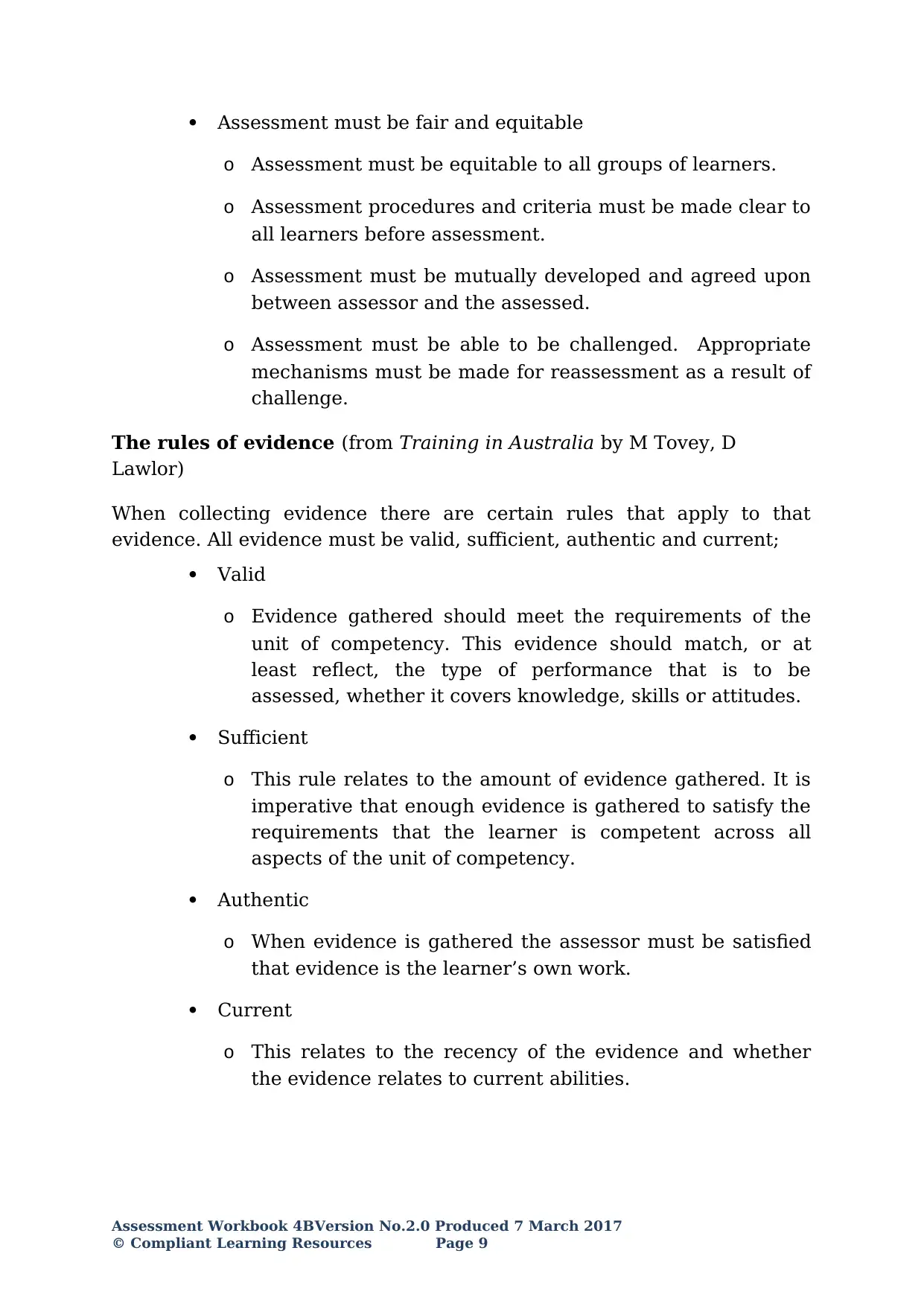
Assessment must be fair and equitable
o Assessment must be equitable to all groups of learners.
o Assessment procedures and criteria must be made clear to
all learners before assessment.
o Assessment must be mutually developed and agreed upon
between assessor and the assessed.
o Assessment must be able to be challenged. Appropriate
mechanisms must be made for reassessment as a result of
challenge.
The rules of evidence (from Training in Australia by M Tovey, D
Lawlor)
When collecting evidence there are certain rules that apply to that
evidence. All evidence must be valid, sufficient, authentic and current;
Valid
o Evidence gathered should meet the requirements of the
unit of competency. This evidence should match, or at
least reflect, the type of performance that is to be
assessed, whether it covers knowledge, skills or attitudes.
Sufficient
o This rule relates to the amount of evidence gathered. It is
imperative that enough evidence is gathered to satisfy the
requirements that the learner is competent across all
aspects of the unit of competency.
Authentic
o When evidence is gathered the assessor must be satisfied
that evidence is the learner’s own work.
Current
o This relates to the recency of the evidence and whether
the evidence relates to current abilities.
Assessment Workbook 4BVersion No.2.0 Produced 7 March 2017
© Compliant Learning Resources Page 9
o Assessment must be equitable to all groups of learners.
o Assessment procedures and criteria must be made clear to
all learners before assessment.
o Assessment must be mutually developed and agreed upon
between assessor and the assessed.
o Assessment must be able to be challenged. Appropriate
mechanisms must be made for reassessment as a result of
challenge.
The rules of evidence (from Training in Australia by M Tovey, D
Lawlor)
When collecting evidence there are certain rules that apply to that
evidence. All evidence must be valid, sufficient, authentic and current;
Valid
o Evidence gathered should meet the requirements of the
unit of competency. This evidence should match, or at
least reflect, the type of performance that is to be
assessed, whether it covers knowledge, skills or attitudes.
Sufficient
o This rule relates to the amount of evidence gathered. It is
imperative that enough evidence is gathered to satisfy the
requirements that the learner is competent across all
aspects of the unit of competency.
Authentic
o When evidence is gathered the assessor must be satisfied
that evidence is the learner’s own work.
Current
o This relates to the recency of the evidence and whether
the evidence relates to current abilities.
Assessment Workbook 4BVersion No.2.0 Produced 7 March 2017
© Compliant Learning Resources Page 9
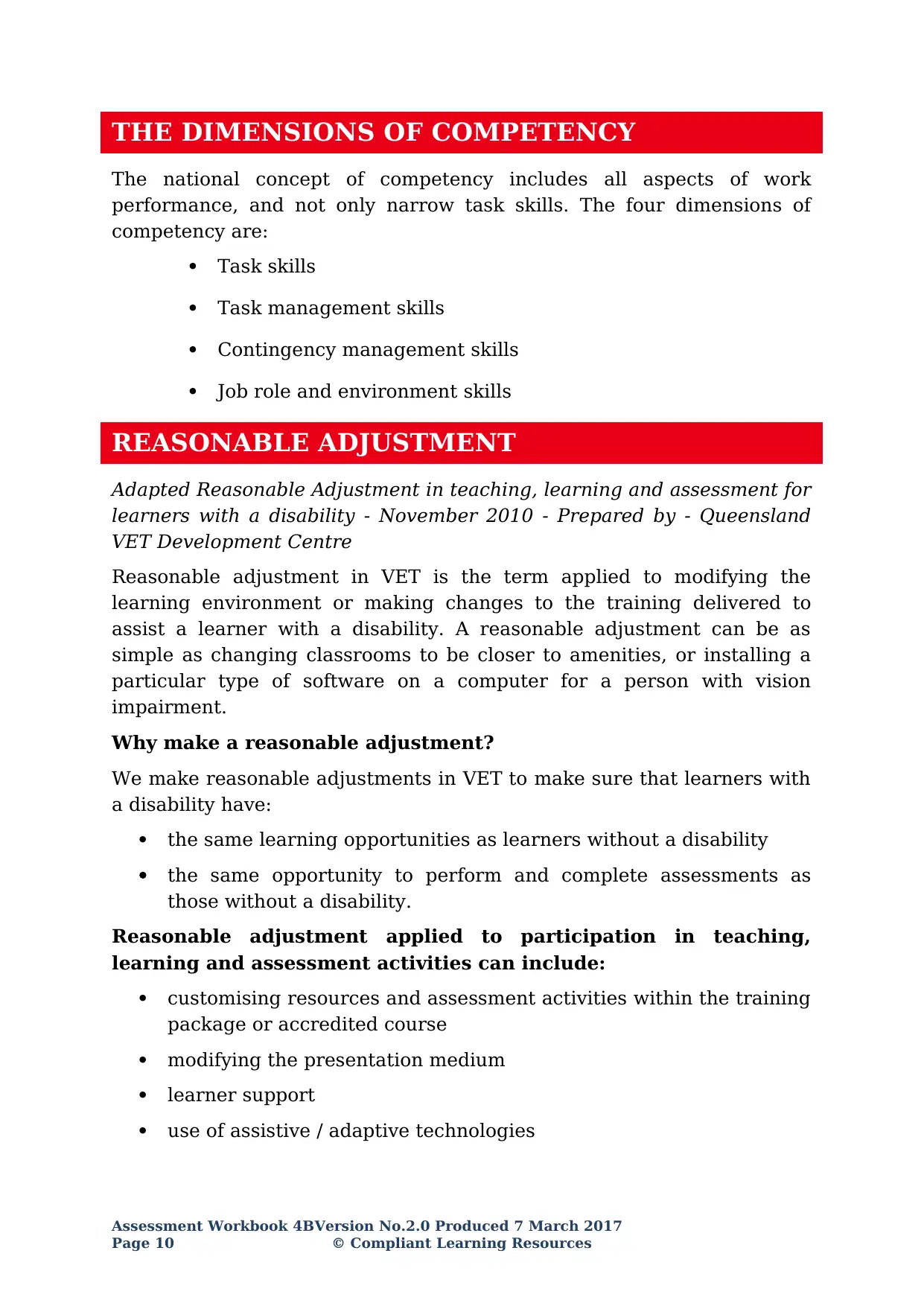
THE DIMENSIONS OF COMPETENCY
The national concept of competency includes all aspects of work
performance, and not only narrow task skills. The four dimensions of
competency are:
Task skills
Task management skills
Contingency management skills
Job role and environment skills
REASONABLE ADJUSTMENT
Adapted Reasonable Adjustment in teaching, learning and assessment for
learners with a disability - November 2010 - Prepared by - Queensland
VET Development Centre
Reasonable adjustment in VET is the term applied to modifying the
learning environment or making changes to the training delivered to
assist a learner with a disability. A reasonable adjustment can be as
simple as changing classrooms to be closer to amenities, or installing a
particular type of software on a computer for a person with vision
impairment.
Why make a reasonable adjustment?
We make reasonable adjustments in VET to make sure that learners with
a disability have:
the same learning opportunities as learners without a disability
the same opportunity to perform and complete assessments as
those without a disability.
Reasonable adjustment applied to participation in teaching,
learning and assessment activities can include:
customising resources and assessment activities within the training
package or accredited course
modifying the presentation medium
learner support
use of assistive / adaptive technologies
Assessment Workbook 4BVersion No.2.0 Produced 7 March 2017
Page 10 © Compliant Learning Resources
The national concept of competency includes all aspects of work
performance, and not only narrow task skills. The four dimensions of
competency are:
Task skills
Task management skills
Contingency management skills
Job role and environment skills
REASONABLE ADJUSTMENT
Adapted Reasonable Adjustment in teaching, learning and assessment for
learners with a disability - November 2010 - Prepared by - Queensland
VET Development Centre
Reasonable adjustment in VET is the term applied to modifying the
learning environment or making changes to the training delivered to
assist a learner with a disability. A reasonable adjustment can be as
simple as changing classrooms to be closer to amenities, or installing a
particular type of software on a computer for a person with vision
impairment.
Why make a reasonable adjustment?
We make reasonable adjustments in VET to make sure that learners with
a disability have:
the same learning opportunities as learners without a disability
the same opportunity to perform and complete assessments as
those without a disability.
Reasonable adjustment applied to participation in teaching,
learning and assessment activities can include:
customising resources and assessment activities within the training
package or accredited course
modifying the presentation medium
learner support
use of assistive / adaptive technologies
Assessment Workbook 4BVersion No.2.0 Produced 7 March 2017
Page 10 © Compliant Learning Resources
Secure Best Marks with AI Grader
Need help grading? Try our AI Grader for instant feedback on your assignments.

making information accessible both prior to enrolment and during
the course
monitoring the adjustments to ensure learner needs continue to be
met.
Assistive / Adaptive Technologies
Assistive / adaptive technology means ‘software or hardware that has
been specifically designed to assist people with disabilities in carrying
out daily activities’ (World Wide Web Consortium - W3C). It includes
screen readers, magnifiers, voice recognition software, alternative
keyboards, devices for grasping, visual alert systems, digital note takers.
IMPORTANT NOTE
Reasonable adjustment made for collecting candidate assessment
evidence must not impact on the standard expected by the workplace, as
expressed by the relevant Unit(s) of Competency. E.g. If the assessment
was gathering evidence of the candidates competency in writing,
allowing the candidate to complete the assessment verbally would not be
a valid assessment method. The method of assessment used by any
reasonable adjustment must still meet the competency requirements.
Assessment Workbook 4BVersion No.2.0 Produced 7 March 2017
© Compliant Learning Resources Page 11
the course
monitoring the adjustments to ensure learner needs continue to be
met.
Assistive / Adaptive Technologies
Assistive / adaptive technology means ‘software or hardware that has
been specifically designed to assist people with disabilities in carrying
out daily activities’ (World Wide Web Consortium - W3C). It includes
screen readers, magnifiers, voice recognition software, alternative
keyboards, devices for grasping, visual alert systems, digital note takers.
IMPORTANT NOTE
Reasonable adjustment made for collecting candidate assessment
evidence must not impact on the standard expected by the workplace, as
expressed by the relevant Unit(s) of Competency. E.g. If the assessment
was gathering evidence of the candidates competency in writing,
allowing the candidate to complete the assessment verbally would not be
a valid assessment method. The method of assessment used by any
reasonable adjustment must still meet the competency requirements.
Assessment Workbook 4BVersion No.2.0 Produced 7 March 2017
© Compliant Learning Resources Page 11
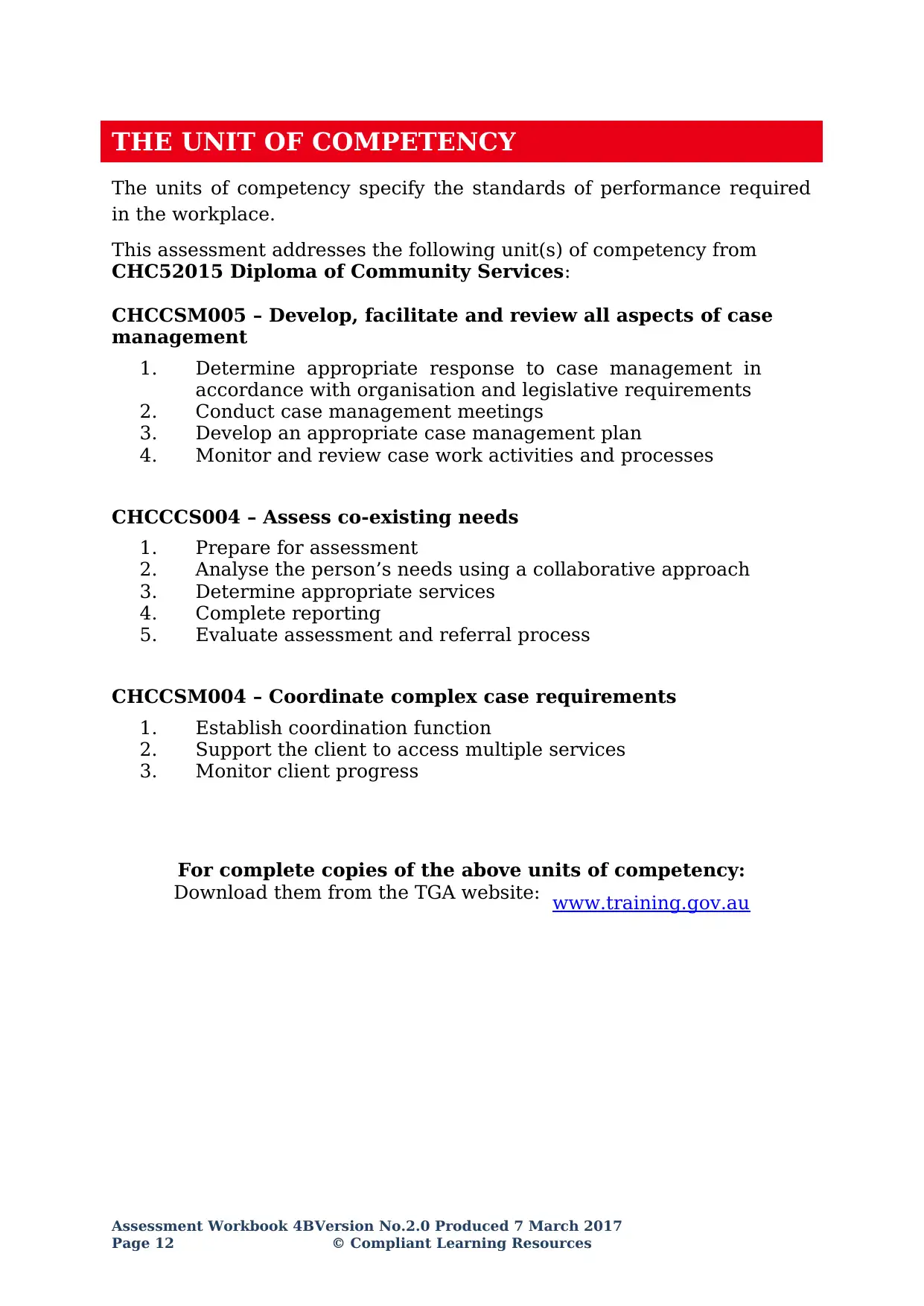
THE UNIT OF COMPETENCY
The units of competency specify the standards of performance required
in the workplace.
This assessment addresses the following unit(s) of competency from
CHC52015 Diploma of Community Services:
CHCCSM005 – Develop, facilitate and review all aspects of case
management
1. Determine appropriate response to case management in
accordance with organisation and legislative requirements
2. Conduct case management meetings
3. Develop an appropriate case management plan
4. Monitor and review case work activities and processes
CHCCCS004 – Assess co-existing needs
1. Prepare for assessment
2. Analyse the person’s needs using a collaborative approach
3. Determine appropriate services
4. Complete reporting
5. Evaluate assessment and referral process
CHCCSM004 – Coordinate complex case requirements
1. Establish coordination function
2. Support the client to access multiple services
3. Monitor client progress
For complete copies of the above units of competency:
Download them from the TGA website: www.training.gov.au
Assessment Workbook 4BVersion No.2.0 Produced 7 March 2017
Page 12 © Compliant Learning Resources
The units of competency specify the standards of performance required
in the workplace.
This assessment addresses the following unit(s) of competency from
CHC52015 Diploma of Community Services:
CHCCSM005 – Develop, facilitate and review all aspects of case
management
1. Determine appropriate response to case management in
accordance with organisation and legislative requirements
2. Conduct case management meetings
3. Develop an appropriate case management plan
4. Monitor and review case work activities and processes
CHCCCS004 – Assess co-existing needs
1. Prepare for assessment
2. Analyse the person’s needs using a collaborative approach
3. Determine appropriate services
4. Complete reporting
5. Evaluate assessment and referral process
CHCCSM004 – Coordinate complex case requirements
1. Establish coordination function
2. Support the client to access multiple services
3. Monitor client progress
For complete copies of the above units of competency:
Download them from the TGA website: www.training.gov.au
Assessment Workbook 4BVersion No.2.0 Produced 7 March 2017
Page 12 © Compliant Learning Resources

CONTEXT FOR ASSESSMENT
To complete the assessments in this workbook, students need to have
access to their learning materials and the internet. The written questions
and project may be completed wholly at the student’s home or chosen
place of study.
ASSESSMENT REQUIREMENTS
The assessment requirements specify the evidence and required
conditions for assessment.
Each unit of competency can be unbundled to reveal three key
assessment components:
1. Performance Evidence
- describes the subtasks that make up the element of the unit
2. Knowledge Evidence
- describes the knowledge that must be applied in understanding
the tasks described in the elements
3. Assessment Condition
- describes the environment and conditions that assessments
must be conducted under
The associated assessment method in this kit covers all of these
components as detailed in the matrix to follow:
Units of
Competency
Assessment Activities
CHCCSM005
CHCCCS004
CHCCSM004
Case study
Assessment Workbook 4BVersion No.2.0 Produced 7 March 2017
© Compliant Learning Resources Page 13
To complete the assessments in this workbook, students need to have
access to their learning materials and the internet. The written questions
and project may be completed wholly at the student’s home or chosen
place of study.
ASSESSMENT REQUIREMENTS
The assessment requirements specify the evidence and required
conditions for assessment.
Each unit of competency can be unbundled to reveal three key
assessment components:
1. Performance Evidence
- describes the subtasks that make up the element of the unit
2. Knowledge Evidence
- describes the knowledge that must be applied in understanding
the tasks described in the elements
3. Assessment Condition
- describes the environment and conditions that assessments
must be conducted under
The associated assessment method in this kit covers all of these
components as detailed in the matrix to follow:
Units of
Competency
Assessment Activities
CHCCSM005
CHCCCS004
CHCCSM004
Case study
Assessment Workbook 4BVersion No.2.0 Produced 7 March 2017
© Compliant Learning Resources Page 13
Paraphrase This Document
Need a fresh take? Get an instant paraphrase of this document with our AI Paraphraser

Assessment Workbook 4BVersion No.2.0 Produced 7 March 2017
Page 14 © Compliant Learning Resources
Page 14 © Compliant Learning Resources
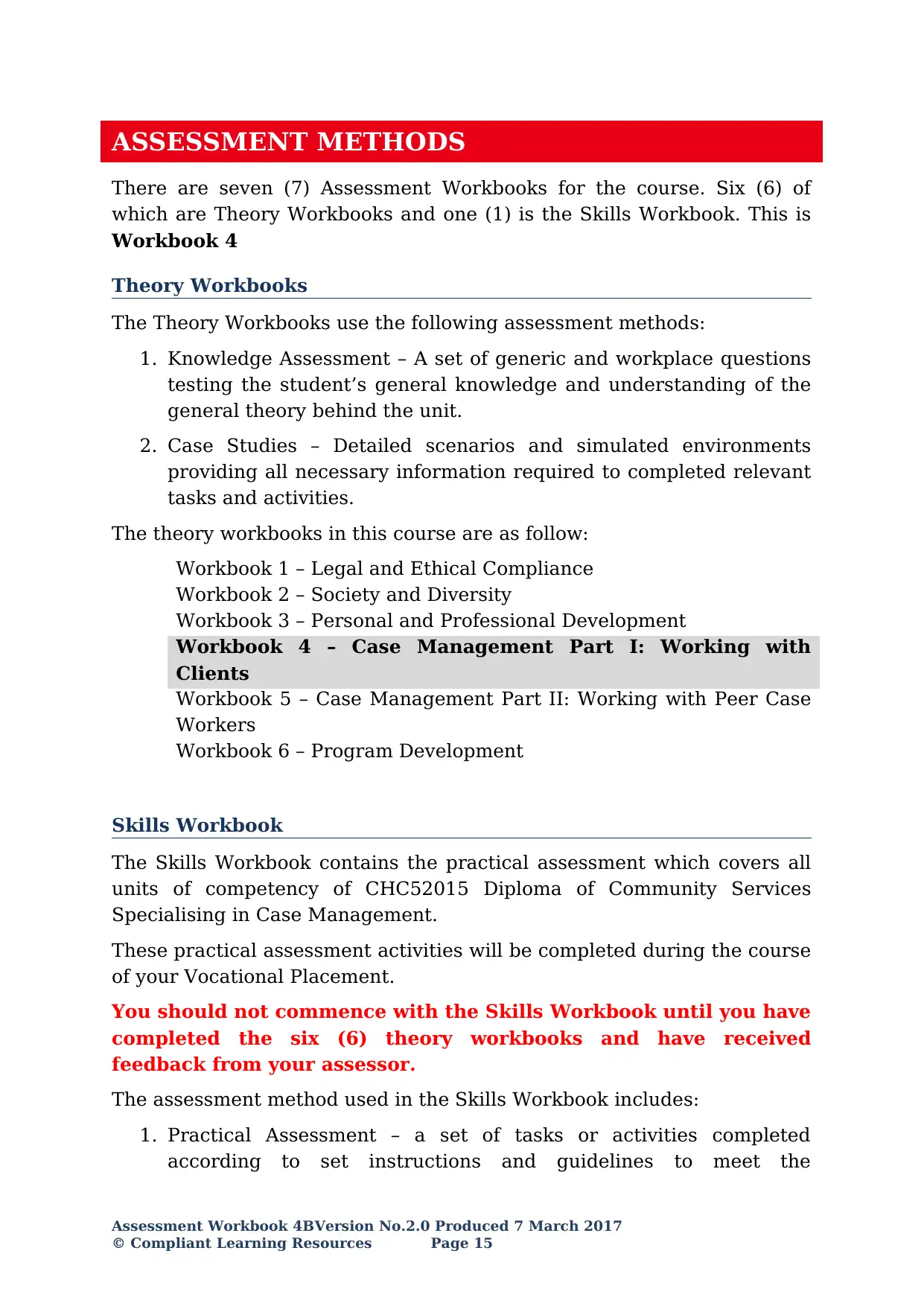
ASSESSMENT METHODS
There are seven (7) Assessment Workbooks for the course. Six (6) of
which are Theory Workbooks and one (1) is the Skills Workbook. This is
Workbook 4
Theory Workbooks
The Theory Workbooks use the following assessment methods:
1. Knowledge Assessment – A set of generic and workplace questions
testing the student’s general knowledge and understanding of the
general theory behind the unit.
2. Case Studies – Detailed scenarios and simulated environments
providing all necessary information required to completed relevant
tasks and activities.
The theory workbooks in this course are as follow:
Workbook 1 – Legal and Ethical Compliance
Workbook 2 – Society and Diversity
Workbook 3 – Personal and Professional Development
Workbook 4 – Case Management Part I: Working with
Clients
Workbook 5 – Case Management Part II: Working with Peer Case
Workers
Workbook 6 – Program Development
Skills Workbook
The Skills Workbook contains the practical assessment which covers all
units of competency of CHC52015 Diploma of Community Services
Specialising in Case Management.
These practical assessment activities will be completed during the course
of your Vocational Placement.
You should not commence with the Skills Workbook until you have
completed the six (6) theory workbooks and have received
feedback from your assessor.
The assessment method used in the Skills Workbook includes:
1. Practical Assessment – a set of tasks or activities completed
according to set instructions and guidelines to meet the
Assessment Workbook 4BVersion No.2.0 Produced 7 March 2017
© Compliant Learning Resources Page 15
There are seven (7) Assessment Workbooks for the course. Six (6) of
which are Theory Workbooks and one (1) is the Skills Workbook. This is
Workbook 4
Theory Workbooks
The Theory Workbooks use the following assessment methods:
1. Knowledge Assessment – A set of generic and workplace questions
testing the student’s general knowledge and understanding of the
general theory behind the unit.
2. Case Studies – Detailed scenarios and simulated environments
providing all necessary information required to completed relevant
tasks and activities.
The theory workbooks in this course are as follow:
Workbook 1 – Legal and Ethical Compliance
Workbook 2 – Society and Diversity
Workbook 3 – Personal and Professional Development
Workbook 4 – Case Management Part I: Working with
Clients
Workbook 5 – Case Management Part II: Working with Peer Case
Workers
Workbook 6 – Program Development
Skills Workbook
The Skills Workbook contains the practical assessment which covers all
units of competency of CHC52015 Diploma of Community Services
Specialising in Case Management.
These practical assessment activities will be completed during the course
of your Vocational Placement.
You should not commence with the Skills Workbook until you have
completed the six (6) theory workbooks and have received
feedback from your assessor.
The assessment method used in the Skills Workbook includes:
1. Practical Assessment – a set of tasks or activities completed
according to set instructions and guidelines to meet the
Assessment Workbook 4BVersion No.2.0 Produced 7 March 2017
© Compliant Learning Resources Page 15

requirements of the relevant units. These tasks and activities
require you to have access to the workplace.
The skills workbook in this course is:
Workbook 7 – Skills Workbook
RESOURCES REQUIRED FOR ASSESSMENT
Assessor to provide:
Case studies and simulations
Information about work activities, as necessary
Policies and procedures
Forms, checklists, and templates
The student to provide:
Computer with internet
Installed software: MS Word, Adobe Acrobat Reader
Access to legislation and protocols relevant to the community
services industry, social work and case management, including
codes of conduct, practice standards, etc.
Video camera or a mobile phone with video and audio recording
capabilities
Three (3) volunteers for the roleplay activities
Assessment Workbook 4BVersion No.2.0 Produced 7 March 2017
Page 16 © Compliant Learning Resources
require you to have access to the workplace.
The skills workbook in this course is:
Workbook 7 – Skills Workbook
RESOURCES REQUIRED FOR ASSESSMENT
Assessor to provide:
Case studies and simulations
Information about work activities, as necessary
Policies and procedures
Forms, checklists, and templates
The student to provide:
Computer with internet
Installed software: MS Word, Adobe Acrobat Reader
Access to legislation and protocols relevant to the community
services industry, social work and case management, including
codes of conduct, practice standards, etc.
Video camera or a mobile phone with video and audio recording
capabilities
Three (3) volunteers for the roleplay activities
Assessment Workbook 4BVersion No.2.0 Produced 7 March 2017
Page 16 © Compliant Learning Resources
Secure Best Marks with AI Grader
Need help grading? Try our AI Grader for instant feedback on your assignments.
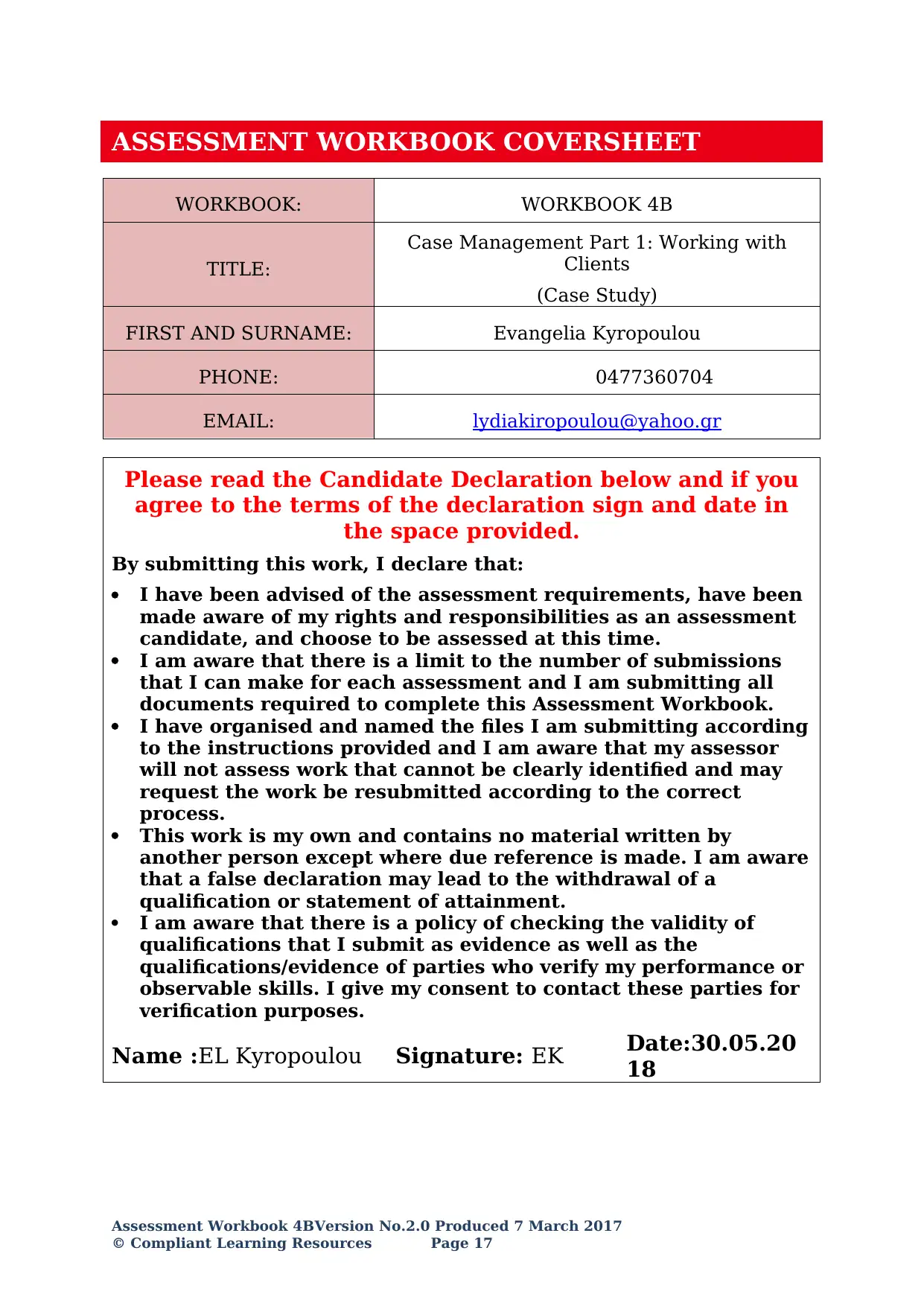
ASSESSMENT WORKBOOK COVERSHEET
WORKBOOK: WORKBOOK 4B
TITLE:
Case Management Part 1: Working with
Clients
(Case Study)
FIRST AND SURNAME: Evangelia Kyropoulou
PHONE: 0477360704
EMAIL: lydiakiropoulou@yahoo.gr
Please read the Candidate Declaration below and if you
agree to the terms of the declaration sign and date in
the space provided.
By submitting this work, I declare that:
I have been advised of the assessment requirements, have been
made aware of my rights and responsibilities as an assessment
candidate, and choose to be assessed at this time.
I am aware that there is a limit to the number of submissions
that I can make for each assessment and I am submitting all
documents required to complete this Assessment Workbook.
I have organised and named the files I am submitting according
to the instructions provided and I am aware that my assessor
will not assess work that cannot be clearly identified and may
request the work be resubmitted according to the correct
process.
This work is my own and contains no material written by
another person except where due reference is made. I am aware
that a false declaration may lead to the withdrawal of a
qualification or statement of attainment.
I am aware that there is a policy of checking the validity of
qualifications that I submit as evidence as well as the
qualifications/evidence of parties who verify my performance or
observable skills. I give my consent to contact these parties for
verification purposes.
Name :EL Kyropoulou Signature: EK Date:30.05.20
18
Assessment Workbook 4BVersion No.2.0 Produced 7 March 2017
© Compliant Learning Resources Page 17
WORKBOOK: WORKBOOK 4B
TITLE:
Case Management Part 1: Working with
Clients
(Case Study)
FIRST AND SURNAME: Evangelia Kyropoulou
PHONE: 0477360704
EMAIL: lydiakiropoulou@yahoo.gr
Please read the Candidate Declaration below and if you
agree to the terms of the declaration sign and date in
the space provided.
By submitting this work, I declare that:
I have been advised of the assessment requirements, have been
made aware of my rights and responsibilities as an assessment
candidate, and choose to be assessed at this time.
I am aware that there is a limit to the number of submissions
that I can make for each assessment and I am submitting all
documents required to complete this Assessment Workbook.
I have organised and named the files I am submitting according
to the instructions provided and I am aware that my assessor
will not assess work that cannot be clearly identified and may
request the work be resubmitted according to the correct
process.
This work is my own and contains no material written by
another person except where due reference is made. I am aware
that a false declaration may lead to the withdrawal of a
qualification or statement of attainment.
I am aware that there is a policy of checking the validity of
qualifications that I submit as evidence as well as the
qualifications/evidence of parties who verify my performance or
observable skills. I give my consent to contact these parties for
verification purposes.
Name :EL Kyropoulou Signature: EK Date:30.05.20
18
Assessment Workbook 4BVersion No.2.0 Produced 7 March 2017
© Compliant Learning Resources Page 17
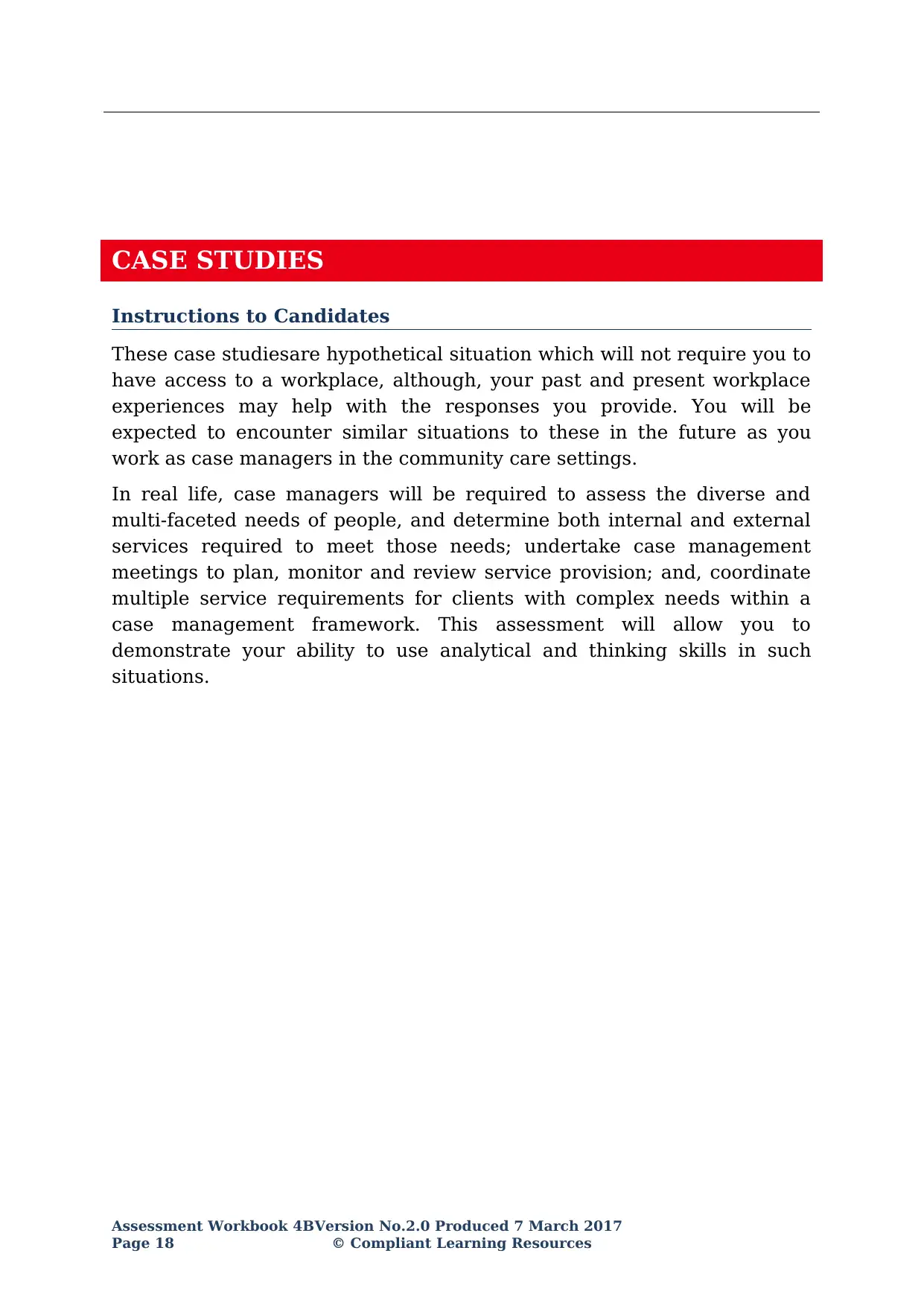
CASE STUDIES
Instructions to Candidates
These case studiesare hypothetical situation which will not require you to
have access to a workplace, although, your past and present workplace
experiences may help with the responses you provide. You will be
expected to encounter similar situations to these in the future as you
work as case managers in the community care settings.
In real life, case managers will be required to assess the diverse and
multi-faceted needs of people, and determine both internal and external
services required to meet those needs; undertake case management
meetings to plan, monitor and review service provision; and, coordinate
multiple service requirements for clients with complex needs within a
case management framework. This assessment will allow you to
demonstrate your ability to use analytical and thinking skills in such
situations.
Assessment Workbook 4BVersion No.2.0 Produced 7 March 2017
Page 18 © Compliant Learning Resources
Instructions to Candidates
These case studiesare hypothetical situation which will not require you to
have access to a workplace, although, your past and present workplace
experiences may help with the responses you provide. You will be
expected to encounter similar situations to these in the future as you
work as case managers in the community care settings.
In real life, case managers will be required to assess the diverse and
multi-faceted needs of people, and determine both internal and external
services required to meet those needs; undertake case management
meetings to plan, monitor and review service provision; and, coordinate
multiple service requirements for clients with complex needs within a
case management framework. This assessment will allow you to
demonstrate your ability to use analytical and thinking skills in such
situations.
Assessment Workbook 4BVersion No.2.0 Produced 7 March 2017
Page 18 © Compliant Learning Resources
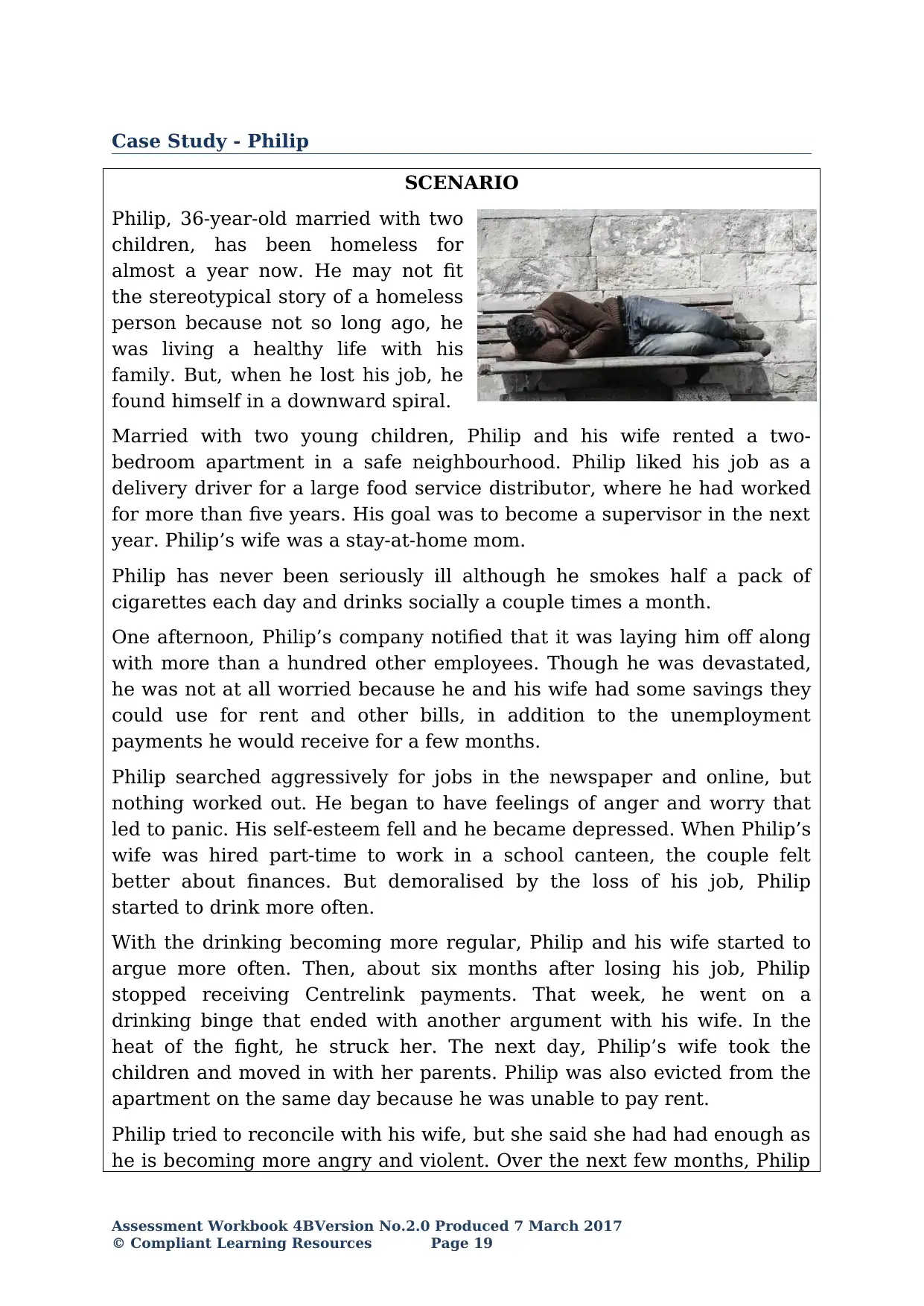
Case Study - Philip
SCENARIO
Philip, 36-year-old married with two
children, has been homeless for
almost a year now. He may not fit
the stereotypical story of a homeless
person because not so long ago, he
was living a healthy life with his
family. But, when he lost his job, he
found himself in a downward spiral.
Married with two young children, Philip and his wife rented a two-
bedroom apartment in a safe neighbourhood. Philip liked his job as a
delivery driver for a large food service distributor, where he had worked
for more than five years. His goal was to become a supervisor in the next
year. Philip’s wife was a stay-at-home mom.
Philip has never been seriously ill although he smokes half a pack of
cigarettes each day and drinks socially a couple times a month.
One afternoon, Philip’s company notified that it was laying him off along
with more than a hundred other employees. Though he was devastated,
he was not at all worried because he and his wife had some savings they
could use for rent and other bills, in addition to the unemployment
payments he would receive for a few months.
Philip searched aggressively for jobs in the newspaper and online, but
nothing worked out. He began to have feelings of anger and worry that
led to panic. His self-esteem fell and he became depressed. When Philip’s
wife was hired part-time to work in a school canteen, the couple felt
better about finances. But demoralised by the loss of his job, Philip
started to drink more often.
With the drinking becoming more regular, Philip and his wife started to
argue more often. Then, about six months after losing his job, Philip
stopped receiving Centrelink payments. That week, he went on a
drinking binge that ended with another argument with his wife. In the
heat of the fight, he struck her. The next day, Philip’s wife took the
children and moved in with her parents. Philip was also evicted from the
apartment on the same day because he was unable to pay rent.
Philip tried to reconcile with his wife, but she said she had had enough as
he is becoming more angry and violent. Over the next few months, Philip
Assessment Workbook 4BVersion No.2.0 Produced 7 March 2017
© Compliant Learning Resources Page 19
SCENARIO
Philip, 36-year-old married with two
children, has been homeless for
almost a year now. He may not fit
the stereotypical story of a homeless
person because not so long ago, he
was living a healthy life with his
family. But, when he lost his job, he
found himself in a downward spiral.
Married with two young children, Philip and his wife rented a two-
bedroom apartment in a safe neighbourhood. Philip liked his job as a
delivery driver for a large food service distributor, where he had worked
for more than five years. His goal was to become a supervisor in the next
year. Philip’s wife was a stay-at-home mom.
Philip has never been seriously ill although he smokes half a pack of
cigarettes each day and drinks socially a couple times a month.
One afternoon, Philip’s company notified that it was laying him off along
with more than a hundred other employees. Though he was devastated,
he was not at all worried because he and his wife had some savings they
could use for rent and other bills, in addition to the unemployment
payments he would receive for a few months.
Philip searched aggressively for jobs in the newspaper and online, but
nothing worked out. He began to have feelings of anger and worry that
led to panic. His self-esteem fell and he became depressed. When Philip’s
wife was hired part-time to work in a school canteen, the couple felt
better about finances. But demoralised by the loss of his job, Philip
started to drink more often.
With the drinking becoming more regular, Philip and his wife started to
argue more often. Then, about six months after losing his job, Philip
stopped receiving Centrelink payments. That week, he went on a
drinking binge that ended with another argument with his wife. In the
heat of the fight, he struck her. The next day, Philip’s wife took the
children and moved in with her parents. Philip was also evicted from the
apartment on the same day because he was unable to pay rent.
Philip tried to reconcile with his wife, but she said she had had enough as
he is becoming more angry and violent. Over the next few months, Philip
Assessment Workbook 4BVersion No.2.0 Produced 7 March 2017
© Compliant Learning Resources Page 19
Paraphrase This Document
Need a fresh take? Get an instant paraphrase of this document with our AI Paraphraser
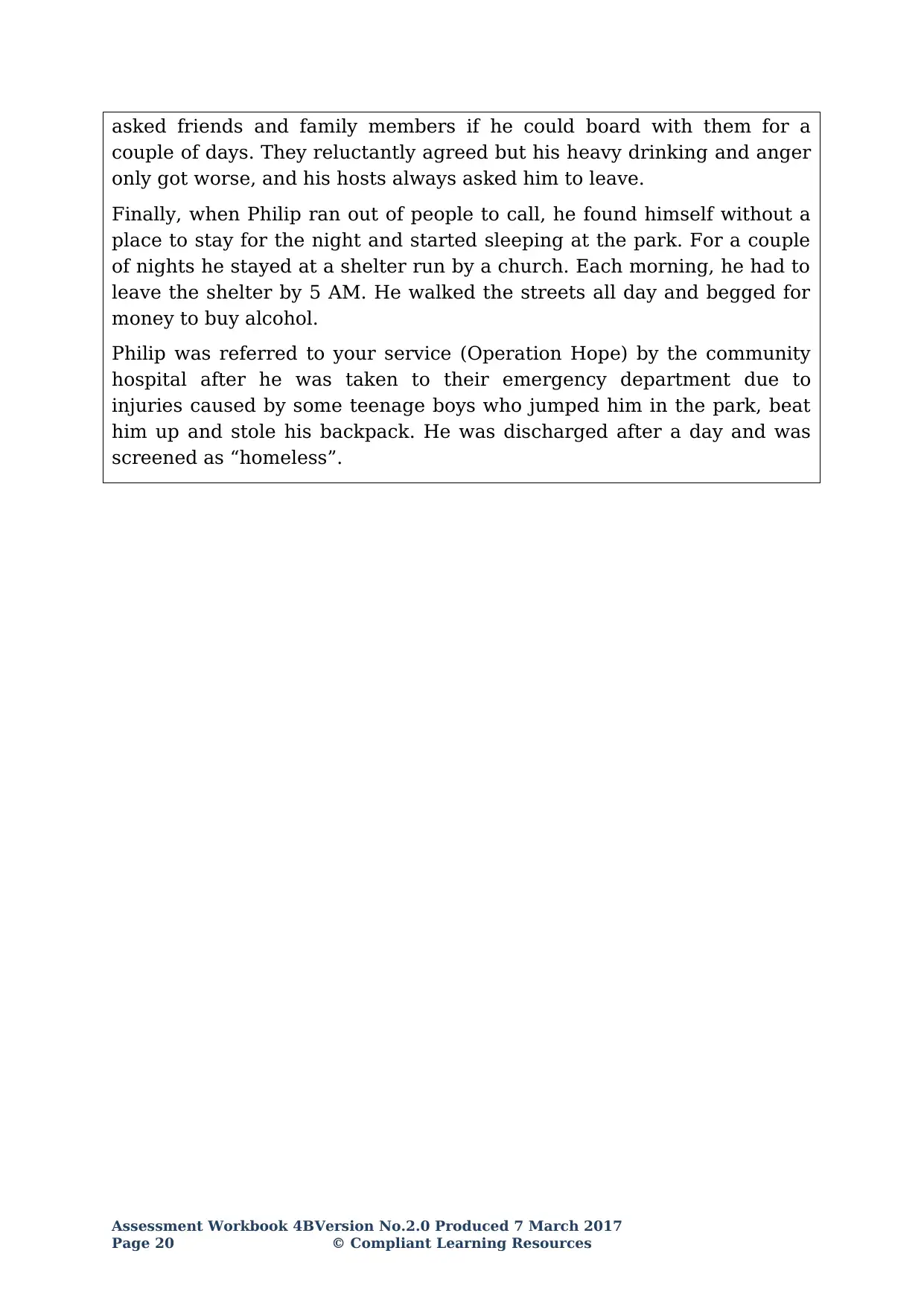
asked friends and family members if he could board with them for a
couple of days. They reluctantly agreed but his heavy drinking and anger
only got worse, and his hosts always asked him to leave.
Finally, when Philip ran out of people to call, he found himself without a
place to stay for the night and started sleeping at the park. For a couple
of nights he stayed at a shelter run by a church. Each morning, he had to
leave the shelter by 5 AM. He walked the streets all day and begged for
money to buy alcohol.
Philip was referred to your service (Operation Hope) by the community
hospital after he was taken to their emergency department due to
injuries caused by some teenage boys who jumped him in the park, beat
him up and stole his backpack. He was discharged after a day and was
screened as “homeless”.
Assessment Workbook 4BVersion No.2.0 Produced 7 March 2017
Page 20 © Compliant Learning Resources
couple of days. They reluctantly agreed but his heavy drinking and anger
only got worse, and his hosts always asked him to leave.
Finally, when Philip ran out of people to call, he found himself without a
place to stay for the night and started sleeping at the park. For a couple
of nights he stayed at a shelter run by a church. Each morning, he had to
leave the shelter by 5 AM. He walked the streets all day and begged for
money to buy alcohol.
Philip was referred to your service (Operation Hope) by the community
hospital after he was taken to their emergency department due to
injuries caused by some teenage boys who jumped him in the park, beat
him up and stole his backpack. He was discharged after a day and was
screened as “homeless”.
Assessment Workbook 4BVersion No.2.0 Produced 7 March 2017
Page 20 © Compliant Learning Resources
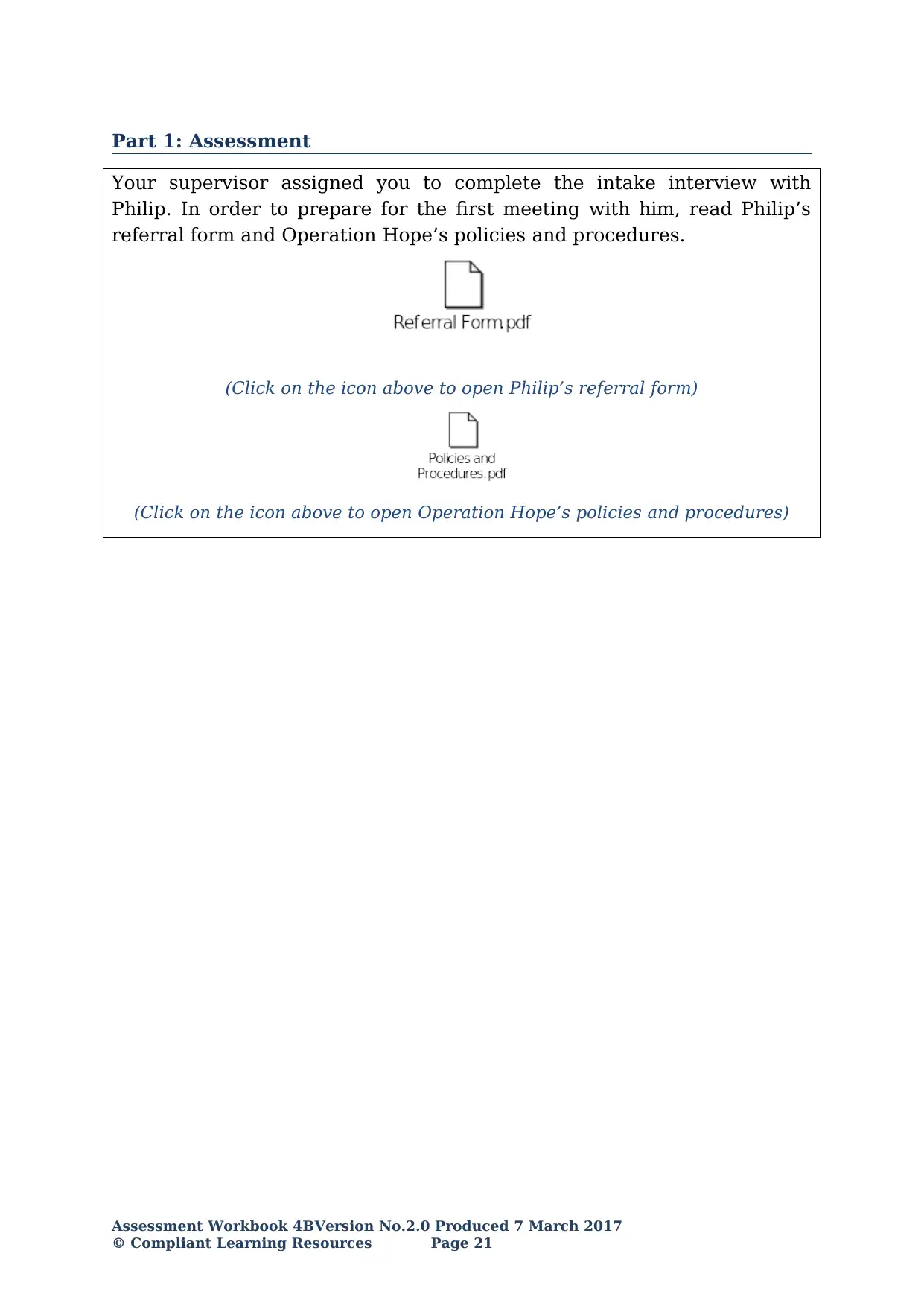
Part 1: Assessment
Your supervisor assigned you to complete the intake interview with
Philip. In order to prepare for the first meeting with him, read Philip’s
referral form and Operation Hope’s policies and procedures.
(Click on the icon above to open Philip’s referral form)
(Click on the icon above to open Operation Hope’s policies and procedures)
Assessment Workbook 4BVersion No.2.0 Produced 7 March 2017
© Compliant Learning Resources Page 21
Your supervisor assigned you to complete the intake interview with
Philip. In order to prepare for the first meeting with him, read Philip’s
referral form and Operation Hope’s policies and procedures.
(Click on the icon above to open Philip’s referral form)
(Click on the icon above to open Operation Hope’s policies and procedures)
Assessment Workbook 4BVersion No.2.0 Produced 7 March 2017
© Compliant Learning Resources Page 21
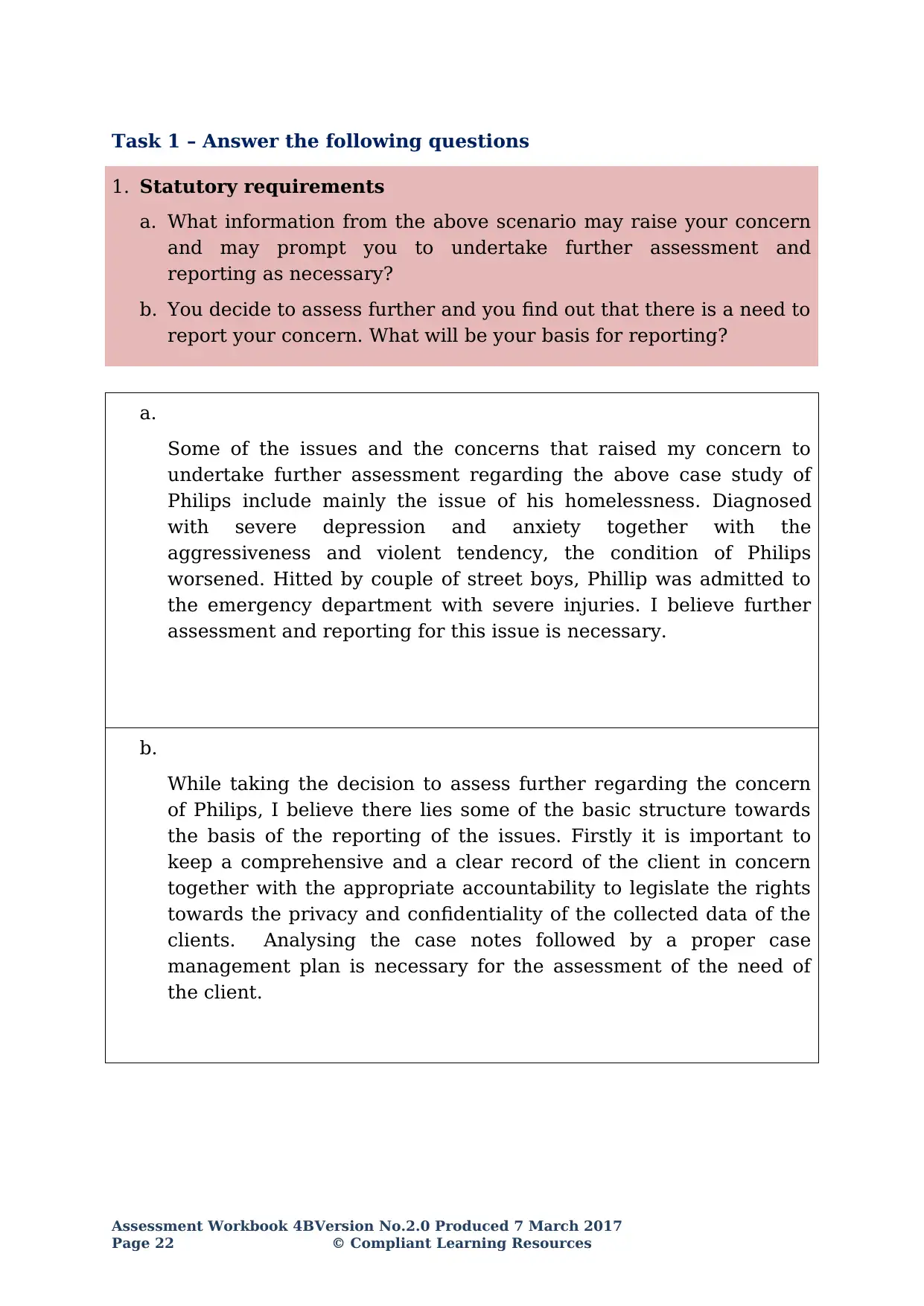
Task 1 – Answer the following questions
1. Statutory requirements
a. What information from the above scenario may raise your concern
and may prompt you to undertake further assessment and
reporting as necessary?
b. You decide to assess further and you find out that there is a need to
report your concern. What will be your basis for reporting?
a.
Some of the issues and the concerns that raised my concern to
undertake further assessment regarding the above case study of
Philips include mainly the issue of his homelessness. Diagnosed
with severe depression and anxiety together with the
aggressiveness and violent tendency, the condition of Philips
worsened. Hitted by couple of street boys, Phillip was admitted to
the emergency department with severe injuries. I believe further
assessment and reporting for this issue is necessary.
b.
While taking the decision to assess further regarding the concern
of Philips, I believe there lies some of the basic structure towards
the basis of the reporting of the issues. Firstly it is important to
keep a comprehensive and a clear record of the client in concern
together with the appropriate accountability to legislate the rights
towards the privacy and confidentiality of the collected data of the
clients. Analysing the case notes followed by a proper case
management plan is necessary for the assessment of the need of
the client.
Assessment Workbook 4BVersion No.2.0 Produced 7 March 2017
Page 22 © Compliant Learning Resources
1. Statutory requirements
a. What information from the above scenario may raise your concern
and may prompt you to undertake further assessment and
reporting as necessary?
b. You decide to assess further and you find out that there is a need to
report your concern. What will be your basis for reporting?
a.
Some of the issues and the concerns that raised my concern to
undertake further assessment regarding the above case study of
Philips include mainly the issue of his homelessness. Diagnosed
with severe depression and anxiety together with the
aggressiveness and violent tendency, the condition of Philips
worsened. Hitted by couple of street boys, Phillip was admitted to
the emergency department with severe injuries. I believe further
assessment and reporting for this issue is necessary.
b.
While taking the decision to assess further regarding the concern
of Philips, I believe there lies some of the basic structure towards
the basis of the reporting of the issues. Firstly it is important to
keep a comprehensive and a clear record of the client in concern
together with the appropriate accountability to legislate the rights
towards the privacy and confidentiality of the collected data of the
clients. Analysing the case notes followed by a proper case
management plan is necessary for the assessment of the need of
the client.
Assessment Workbook 4BVersion No.2.0 Produced 7 March 2017
Page 22 © Compliant Learning Resources
Secure Best Marks with AI Grader
Need help grading? Try our AI Grader for instant feedback on your assignments.
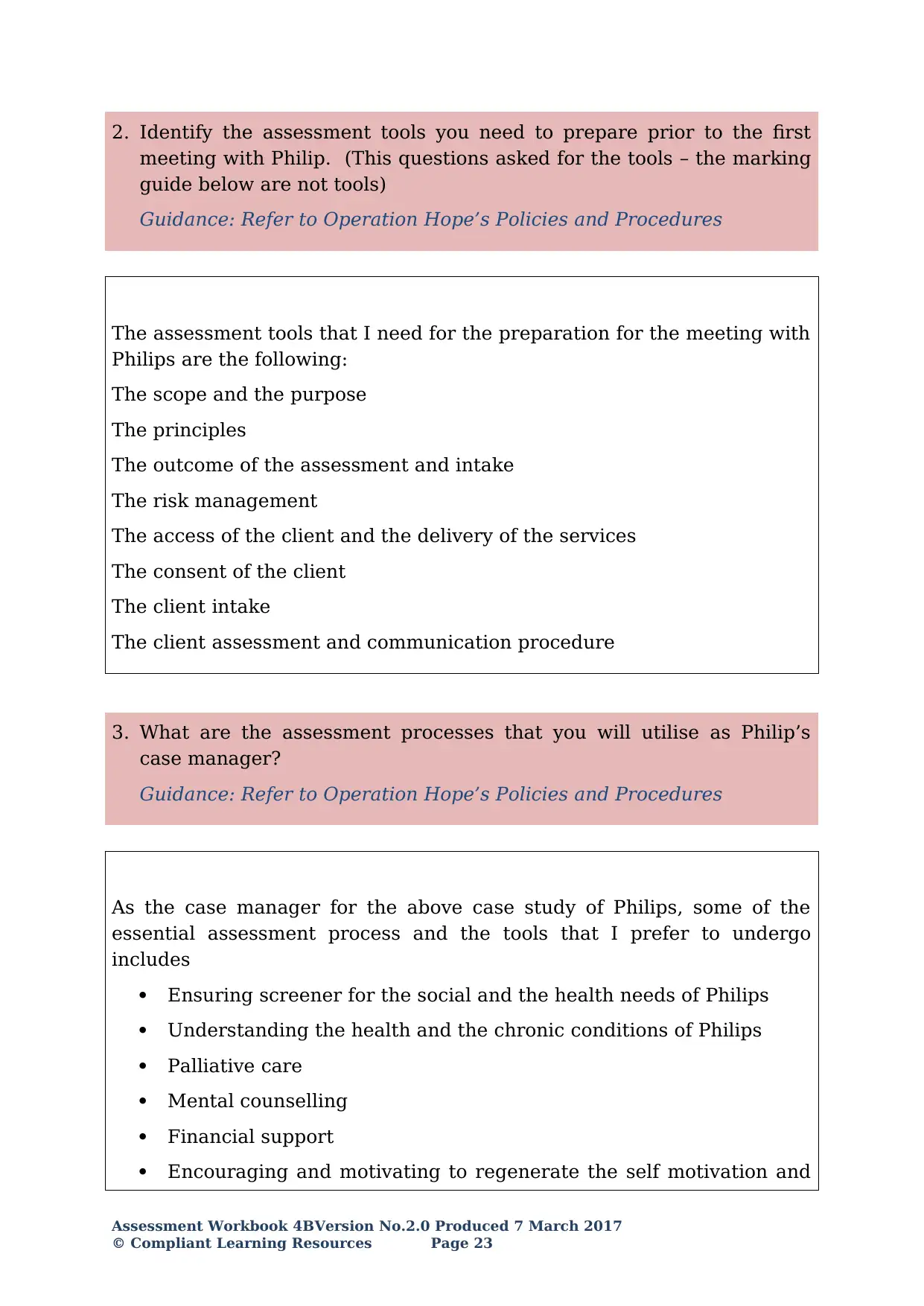
2. Identify the assessment tools you need to prepare prior to the first
meeting with Philip. (This questions asked for the tools – the marking
guide below are not tools)
Guidance: Refer to Operation Hope’s Policies and Procedures
The assessment tools that I need for the preparation for the meeting with
Philips are the following:
The scope and the purpose
The principles
The outcome of the assessment and intake
The risk management
The access of the client and the delivery of the services
The consent of the client
The client intake
The client assessment and communication procedure
3. What are the assessment processes that you will utilise as Philip’s
case manager?
Guidance: Refer to Operation Hope’s Policies and Procedures
As the case manager for the above case study of Philips, some of the
essential assessment process and the tools that I prefer to undergo
includes
Ensuring screener for the social and the health needs of Philips
Understanding the health and the chronic conditions of Philips
Palliative care
Mental counselling
Financial support
Encouraging and motivating to regenerate the self motivation and
Assessment Workbook 4BVersion No.2.0 Produced 7 March 2017
© Compliant Learning Resources Page 23
meeting with Philip. (This questions asked for the tools – the marking
guide below are not tools)
Guidance: Refer to Operation Hope’s Policies and Procedures
The assessment tools that I need for the preparation for the meeting with
Philips are the following:
The scope and the purpose
The principles
The outcome of the assessment and intake
The risk management
The access of the client and the delivery of the services
The consent of the client
The client intake
The client assessment and communication procedure
3. What are the assessment processes that you will utilise as Philip’s
case manager?
Guidance: Refer to Operation Hope’s Policies and Procedures
As the case manager for the above case study of Philips, some of the
essential assessment process and the tools that I prefer to undergo
includes
Ensuring screener for the social and the health needs of Philips
Understanding the health and the chronic conditions of Philips
Palliative care
Mental counselling
Financial support
Encouraging and motivating to regenerate the self motivation and
Assessment Workbook 4BVersion No.2.0 Produced 7 March 2017
© Compliant Learning Resources Page 23
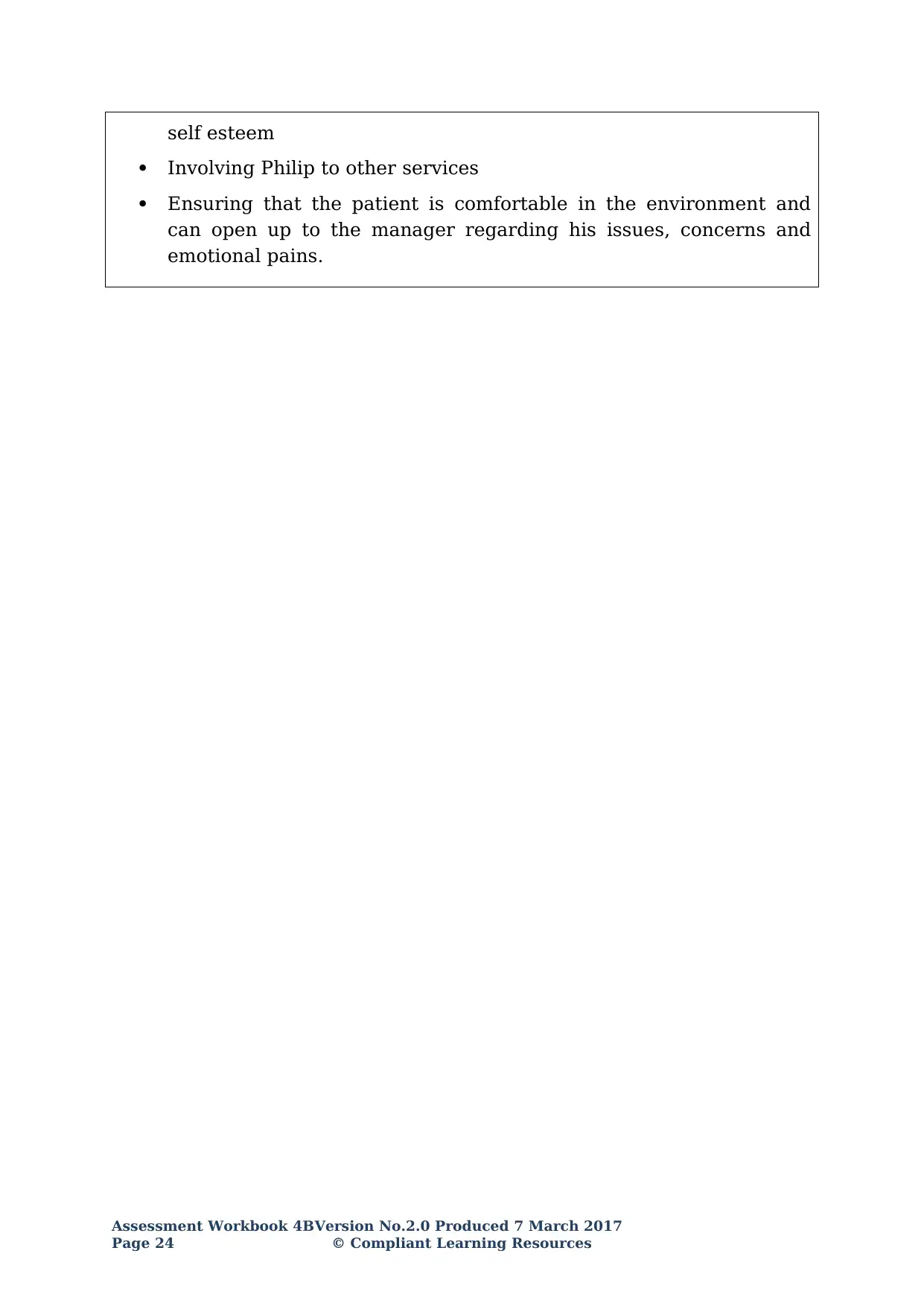
self esteem
Involving Philip to other services
Ensuring that the patient is comfortable in the environment and
can open up to the manager regarding his issues, concerns and
emotional pains.
Assessment Workbook 4BVersion No.2.0 Produced 7 March 2017
Page 24 © Compliant Learning Resources
Involving Philip to other services
Ensuring that the patient is comfortable in the environment and
can open up to the manager regarding his issues, concerns and
emotional pains.
Assessment Workbook 4BVersion No.2.0 Produced 7 March 2017
Page 24 © Compliant Learning Resources
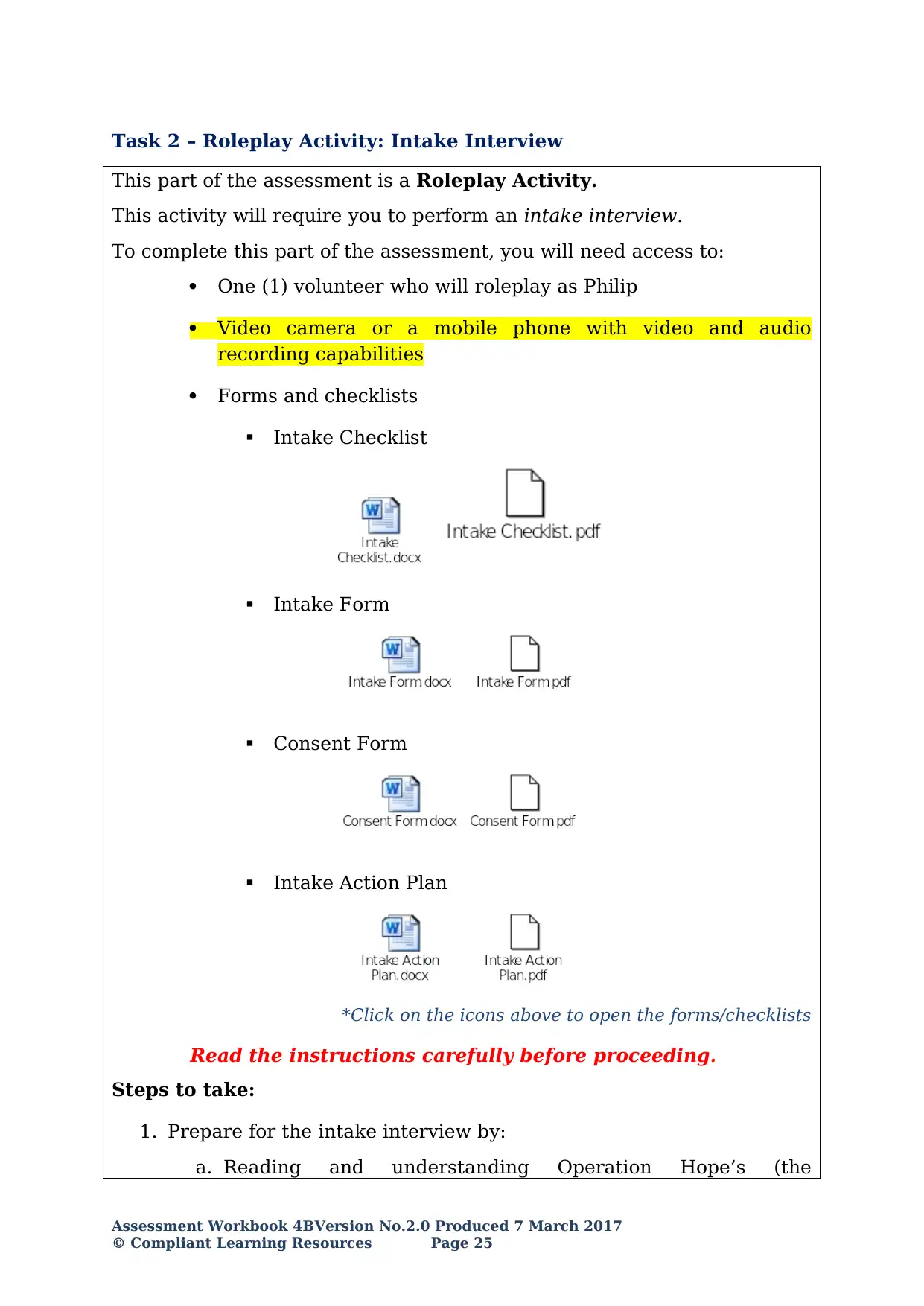
Task 2 – Roleplay Activity: Intake Interview
This part of the assessment is a Roleplay Activity.
This activity will require you to perform an intake interview.
To complete this part of the assessment, you will need access to:
One (1) volunteer who will roleplay as Philip
Video camera or a mobile phone with video and audio
recording capabilities
Forms and checklists
Intake Checklist
Intake Form
Consent Form
Intake Action Plan
*Click on the icons above to open the forms/checklists
Read the instructions carefully before proceeding.
Steps to take:
1. Prepare for the intake interview by:
a. Reading and understanding Operation Hope’s (the
Assessment Workbook 4BVersion No.2.0 Produced 7 March 2017
© Compliant Learning Resources Page 25
This part of the assessment is a Roleplay Activity.
This activity will require you to perform an intake interview.
To complete this part of the assessment, you will need access to:
One (1) volunteer who will roleplay as Philip
Video camera or a mobile phone with video and audio
recording capabilities
Forms and checklists
Intake Checklist
Intake Form
Consent Form
Intake Action Plan
*Click on the icons above to open the forms/checklists
Read the instructions carefully before proceeding.
Steps to take:
1. Prepare for the intake interview by:
a. Reading and understanding Operation Hope’s (the
Assessment Workbook 4BVersion No.2.0 Produced 7 March 2017
© Compliant Learning Resources Page 25
Paraphrase This Document
Need a fresh take? Get an instant paraphrase of this document with our AI Paraphraser
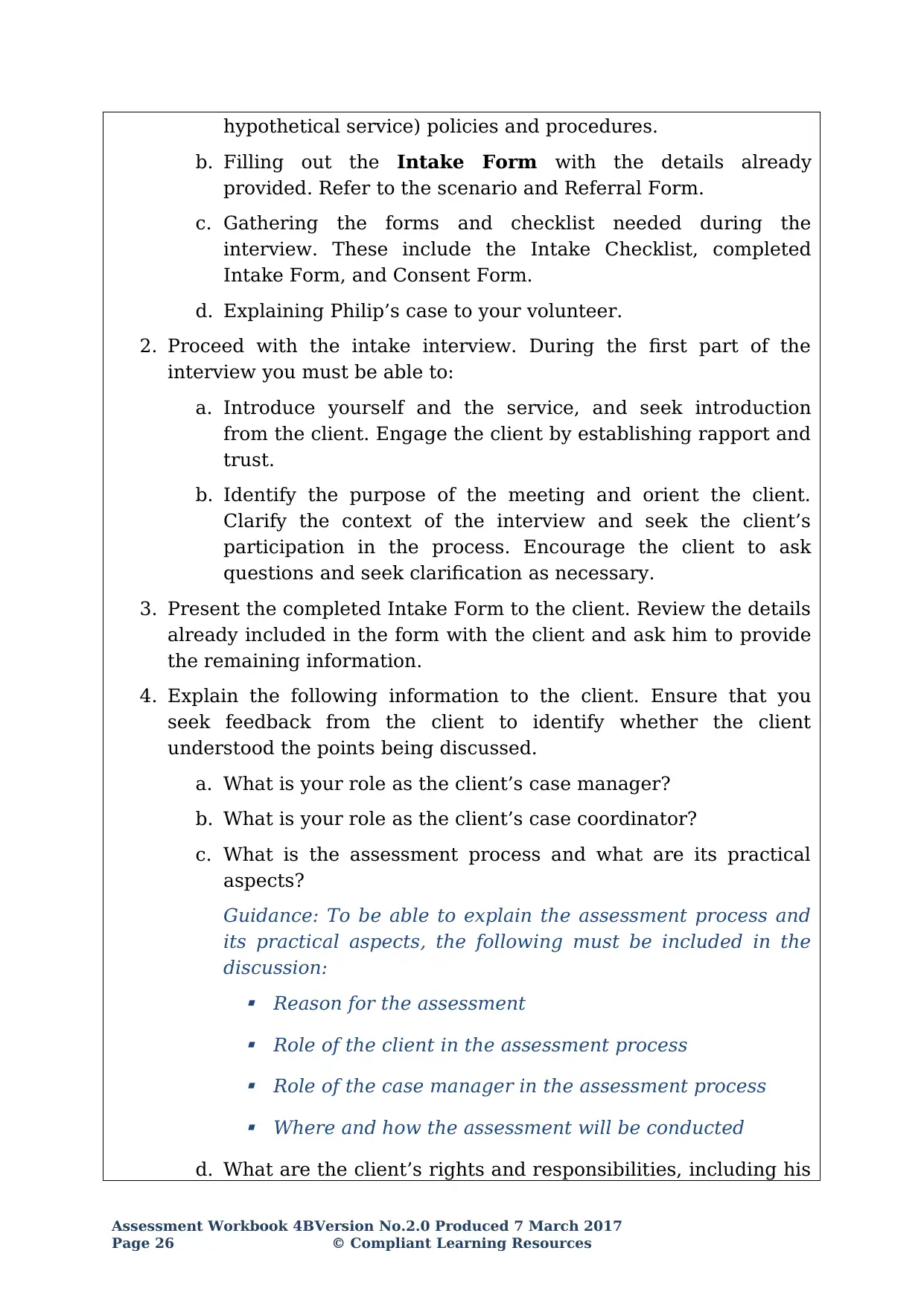
hypothetical service) policies and procedures.
b. Filling out the Intake Form with the details already
provided. Refer to the scenario and Referral Form.
c. Gathering the forms and checklist needed during the
interview. These include the Intake Checklist, completed
Intake Form, and Consent Form.
d. Explaining Philip’s case to your volunteer.
2. Proceed with the intake interview. During the first part of the
interview you must be able to:
a. Introduce yourself and the service, and seek introduction
from the client. Engage the client by establishing rapport and
trust.
b. Identify the purpose of the meeting and orient the client.
Clarify the context of the interview and seek the client’s
participation in the process. Encourage the client to ask
questions and seek clarification as necessary.
3. Present the completed Intake Form to the client. Review the details
already included in the form with the client and ask him to provide
the remaining information.
4. Explain the following information to the client. Ensure that you
seek feedback from the client to identify whether the client
understood the points being discussed.
a. What is your role as the client’s case manager?
b. What is your role as the client’s case coordinator?
c. What is the assessment process and what are its practical
aspects?
Guidance: To be able to explain the assessment process and
its practical aspects, the following must be included in the
discussion:
Reason for the assessment
Role of the client in the assessment process
Role of the case manager in the assessment process
Where and how the assessment will be conducted
d. What are the client’s rights and responsibilities, including his
Assessment Workbook 4BVersion No.2.0 Produced 7 March 2017
Page 26 © Compliant Learning Resources
b. Filling out the Intake Form with the details already
provided. Refer to the scenario and Referral Form.
c. Gathering the forms and checklist needed during the
interview. These include the Intake Checklist, completed
Intake Form, and Consent Form.
d. Explaining Philip’s case to your volunteer.
2. Proceed with the intake interview. During the first part of the
interview you must be able to:
a. Introduce yourself and the service, and seek introduction
from the client. Engage the client by establishing rapport and
trust.
b. Identify the purpose of the meeting and orient the client.
Clarify the context of the interview and seek the client’s
participation in the process. Encourage the client to ask
questions and seek clarification as necessary.
3. Present the completed Intake Form to the client. Review the details
already included in the form with the client and ask him to provide
the remaining information.
4. Explain the following information to the client. Ensure that you
seek feedback from the client to identify whether the client
understood the points being discussed.
a. What is your role as the client’s case manager?
b. What is your role as the client’s case coordinator?
c. What is the assessment process and what are its practical
aspects?
Guidance: To be able to explain the assessment process and
its practical aspects, the following must be included in the
discussion:
Reason for the assessment
Role of the client in the assessment process
Role of the case manager in the assessment process
Where and how the assessment will be conducted
d. What are the client’s rights and responsibilities, including his
Assessment Workbook 4BVersion No.2.0 Produced 7 March 2017
Page 26 © Compliant Learning Resources
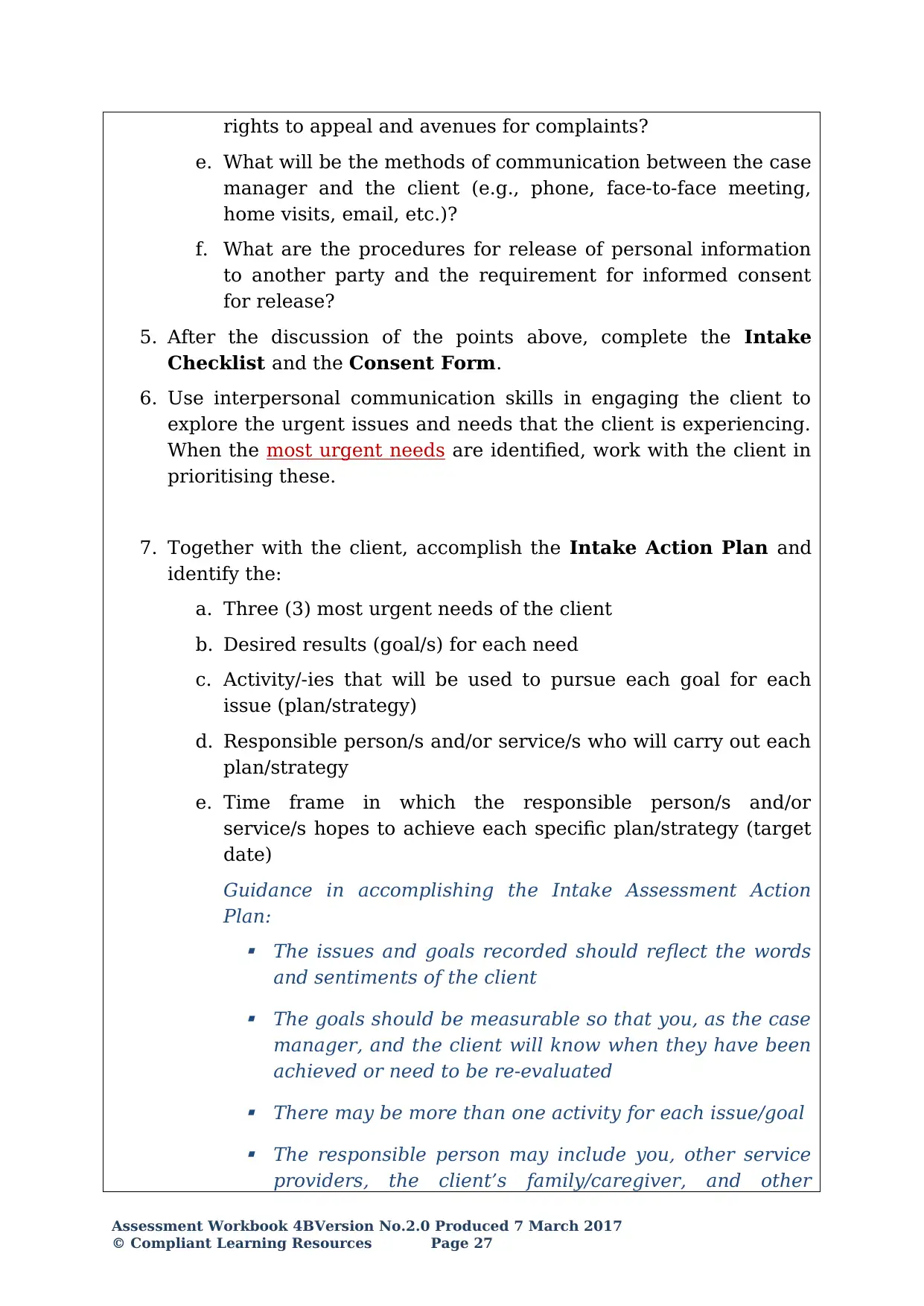
rights to appeal and avenues for complaints?
e. What will be the methods of communication between the case
manager and the client (e.g., phone, face-to-face meeting,
home visits, email, etc.)?
f. What are the procedures for release of personal information
to another party and the requirement for informed consent
for release?
5. After the discussion of the points above, complete the Intake
Checklist and the Consent Form.
6. Use interpersonal communication skills in engaging the client to
explore the urgent issues and needs that the client is experiencing.
When the most urgent needs are identified, work with the client in
prioritising these.
7. Together with the client, accomplish the Intake Action Plan and
identify the:
a. Three (3) most urgent needs of the client
b. Desired results (goal/s) for each need
c. Activity/-ies that will be used to pursue each goal for each
issue (plan/strategy)
d. Responsible person/s and/or service/s who will carry out each
plan/strategy
e. Time frame in which the responsible person/s and/or
service/s hopes to achieve each specific plan/strategy (target
date)
Guidance in accomplishing the Intake Assessment Action
Plan:
The issues and goals recorded should reflect the words
and sentiments of the client
The goals should be measurable so that you, as the case
manager, and the client will know when they have been
achieved or need to be re-evaluated
There may be more than one activity for each issue/goal
The responsible person may include you, other service
providers, the client’s family/caregiver, and other
Assessment Workbook 4BVersion No.2.0 Produced 7 March 2017
© Compliant Learning Resources Page 27
e. What will be the methods of communication between the case
manager and the client (e.g., phone, face-to-face meeting,
home visits, email, etc.)?
f. What are the procedures for release of personal information
to another party and the requirement for informed consent
for release?
5. After the discussion of the points above, complete the Intake
Checklist and the Consent Form.
6. Use interpersonal communication skills in engaging the client to
explore the urgent issues and needs that the client is experiencing.
When the most urgent needs are identified, work with the client in
prioritising these.
7. Together with the client, accomplish the Intake Action Plan and
identify the:
a. Three (3) most urgent needs of the client
b. Desired results (goal/s) for each need
c. Activity/-ies that will be used to pursue each goal for each
issue (plan/strategy)
d. Responsible person/s and/or service/s who will carry out each
plan/strategy
e. Time frame in which the responsible person/s and/or
service/s hopes to achieve each specific plan/strategy (target
date)
Guidance in accomplishing the Intake Assessment Action
Plan:
The issues and goals recorded should reflect the words
and sentiments of the client
The goals should be measurable so that you, as the case
manager, and the client will know when they have been
achieved or need to be re-evaluated
There may be more than one activity for each issue/goal
The responsible person may include you, other service
providers, the client’s family/caregiver, and other
Assessment Workbook 4BVersion No.2.0 Produced 7 March 2017
© Compliant Learning Resources Page 27
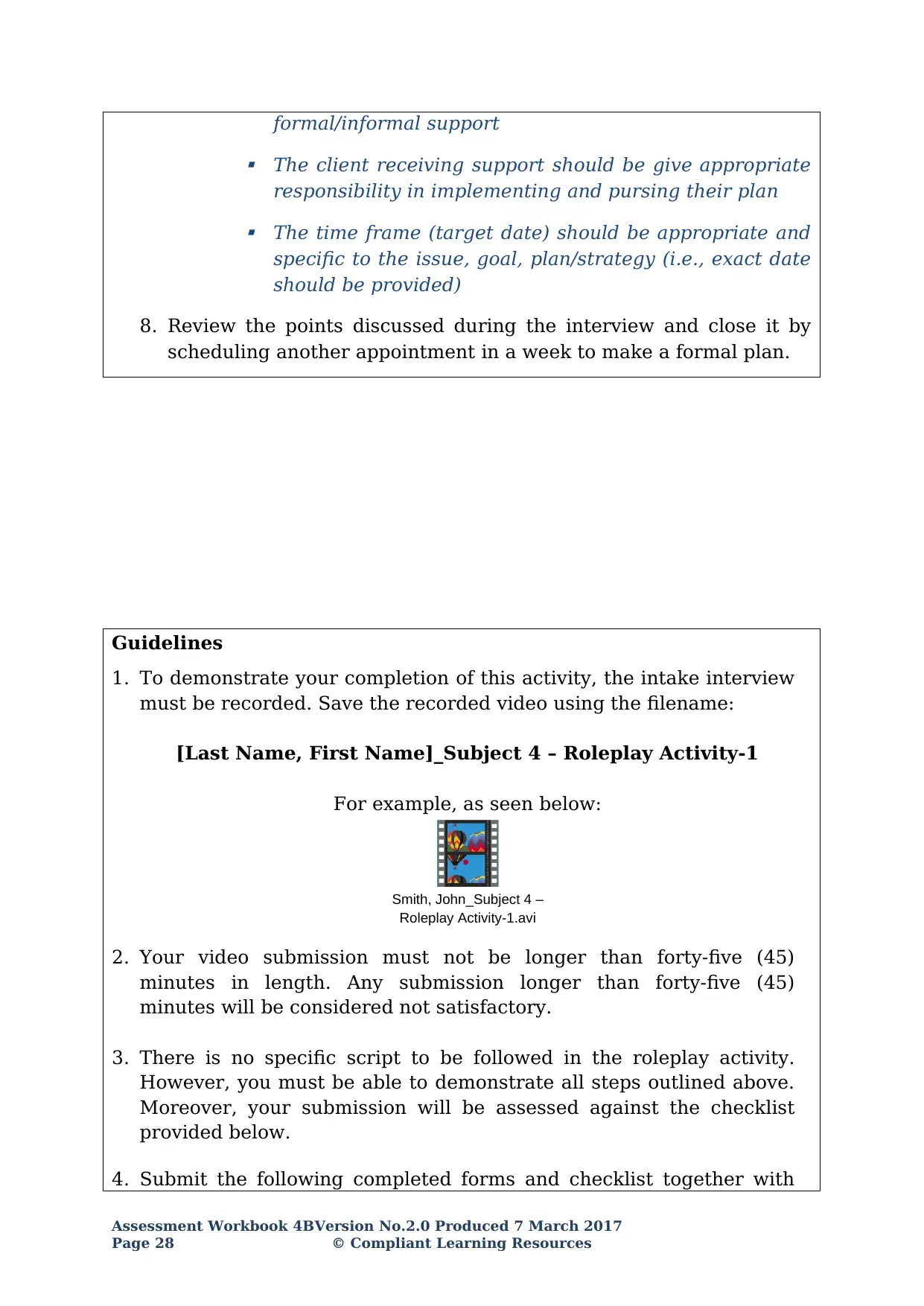
formal/informal support
The client receiving support should be give appropriate
responsibility in implementing and pursing their plan
The time frame (target date) should be appropriate and
specific to the issue, goal, plan/strategy (i.e., exact date
should be provided)
8. Review the points discussed during the interview and close it by
scheduling another appointment in a week to make a formal plan.
Guidelines
1. To demonstrate your completion of this activity, the intake interview
must be recorded. Save the recorded video using the filename:
[Last Name, First Name]_Subject 4 – Roleplay Activity-1
For example, as seen below:
Smith, John_Subject 4 –
Roleplay Activity-1.avi
2. Your video submission must not be longer than forty-five (45)
minutes in length. Any submission longer than forty-five (45)
minutes will be considered not satisfactory.
3. There is no specific script to be followed in the roleplay activity.
However, you must be able to demonstrate all steps outlined above.
Moreover, your submission will be assessed against the checklist
provided below.
4. Submit the following completed forms and checklist together with
Assessment Workbook 4BVersion No.2.0 Produced 7 March 2017
Page 28 © Compliant Learning Resources
The client receiving support should be give appropriate
responsibility in implementing and pursing their plan
The time frame (target date) should be appropriate and
specific to the issue, goal, plan/strategy (i.e., exact date
should be provided)
8. Review the points discussed during the interview and close it by
scheduling another appointment in a week to make a formal plan.
Guidelines
1. To demonstrate your completion of this activity, the intake interview
must be recorded. Save the recorded video using the filename:
[Last Name, First Name]_Subject 4 – Roleplay Activity-1
For example, as seen below:
Smith, John_Subject 4 –
Roleplay Activity-1.avi
2. Your video submission must not be longer than forty-five (45)
minutes in length. Any submission longer than forty-five (45)
minutes will be considered not satisfactory.
3. There is no specific script to be followed in the roleplay activity.
However, you must be able to demonstrate all steps outlined above.
Moreover, your submission will be assessed against the checklist
provided below.
4. Submit the following completed forms and checklist together with
Assessment Workbook 4BVersion No.2.0 Produced 7 March 2017
Page 28 © Compliant Learning Resources
Secure Best Marks with AI Grader
Need help grading? Try our AI Grader for instant feedback on your assignments.
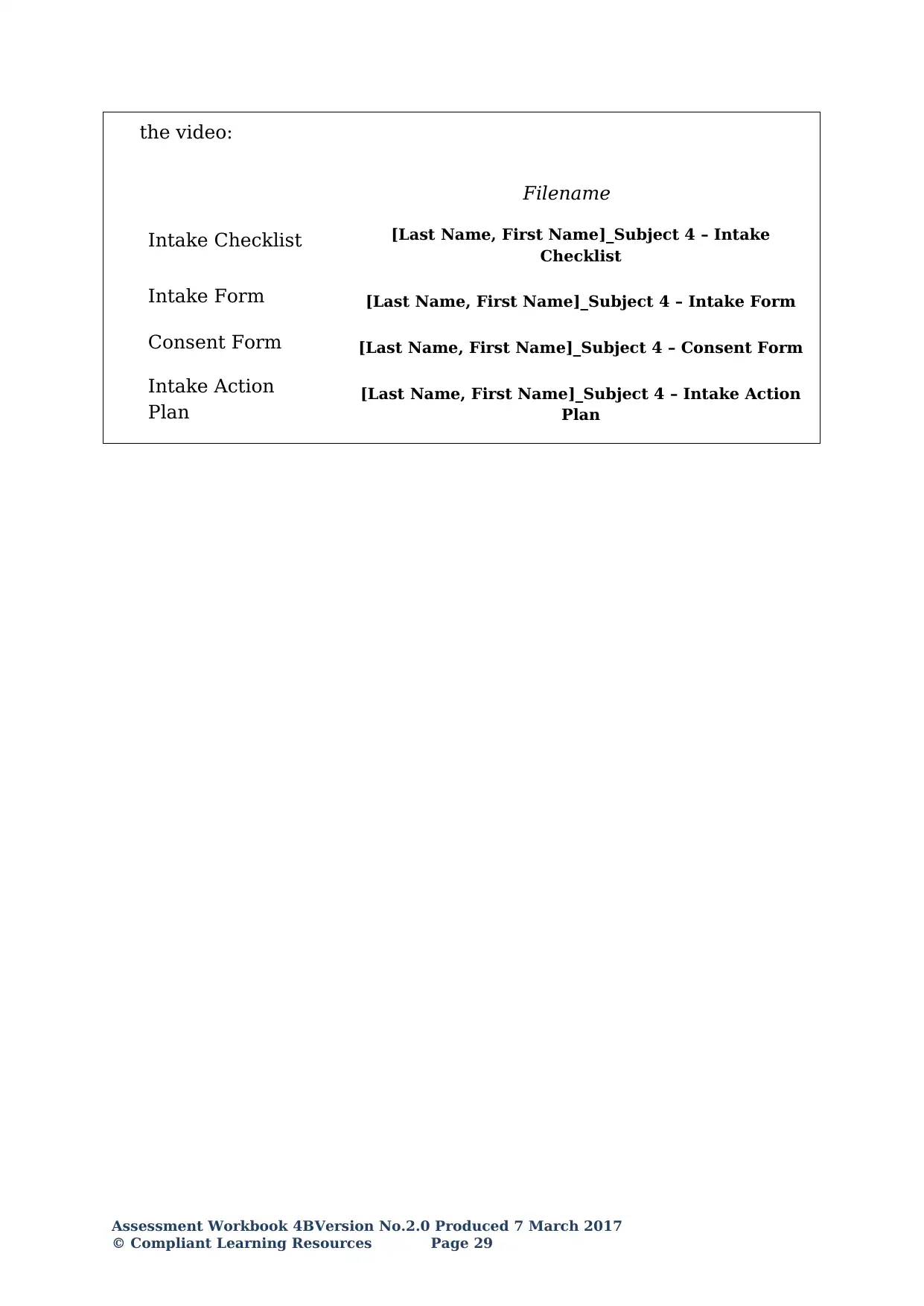
the video:
Filename
Intake Checklist [Last Name, First Name]_Subject 4 – Intake
Checklist
Intake Form [Last Name, First Name]_Subject 4 – Intake Form
Consent Form [Last Name, First Name]_Subject 4 – Consent Form
Intake Action
Plan
[Last Name, First Name]_Subject 4 – Intake Action
Plan
Assessment Workbook 4BVersion No.2.0 Produced 7 March 2017
© Compliant Learning Resources Page 29
Filename
Intake Checklist [Last Name, First Name]_Subject 4 – Intake
Checklist
Intake Form [Last Name, First Name]_Subject 4 – Intake Form
Consent Form [Last Name, First Name]_Subject 4 – Consent Form
Intake Action
Plan
[Last Name, First Name]_Subject 4 – Intake Action
Plan
Assessment Workbook 4BVersion No.2.0 Produced 7 March 2017
© Compliant Learning Resources Page 29
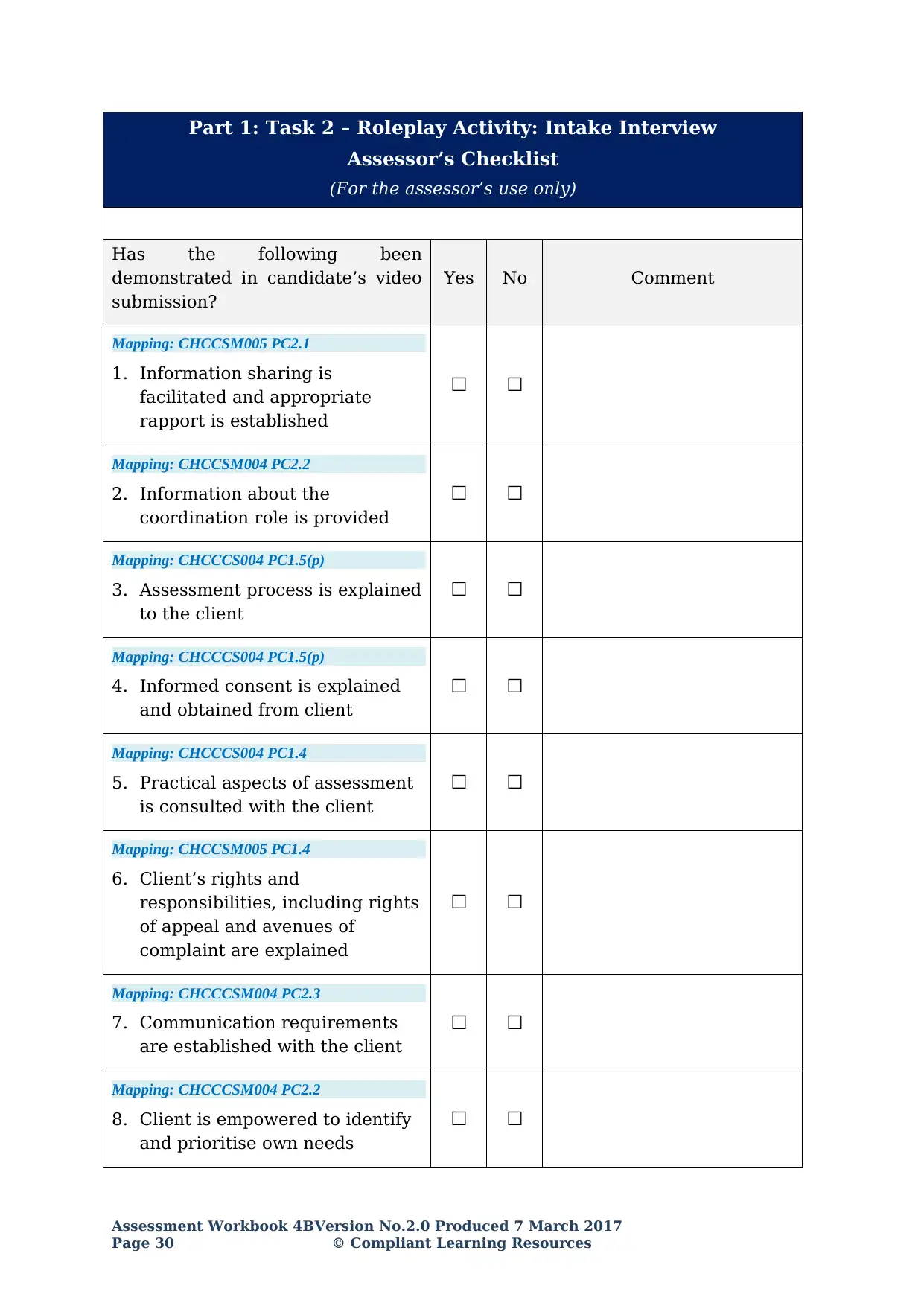
Part 1: Task 2 – Roleplay Activity: Intake Interview
Assessor’s Checklist
(For the assessor’s use only)
Has the following been
demonstrated in candidate’s video
submission?
Yes No Comment
Mapping: CHCCSM005 PC2.1
1. Information sharing is
facilitated and appropriate
rapport is established
☐ ☐
Mapping: CHCCSM004 PC2.2
2. Information about the
coordination role is provided
☐ ☐
Mapping: CHCCCS004 PC1.5(p)
3. Assessment process is explained
to the client
☐ ☐
Mapping: CHCCCS004 PC1.5(p)
4. Informed consent is explained
and obtained from client
☐ ☐
Mapping: CHCCCS004 PC1.4
5. Practical aspects of assessment
is consulted with the client
☐ ☐
Mapping: CHCCSM005 PC1.4
6. Client’s rights and
responsibilities, including rights
of appeal and avenues of
complaint are explained
☐ ☐
Mapping: CHCCCSM004 PC2.3
7. Communication requirements
are established with the client
☐ ☐
Mapping: CHCCCSM004 PC2.2
8. Client is empowered to identify
and prioritise own needs
☐ ☐
Assessment Workbook 4BVersion No.2.0 Produced 7 March 2017
Page 30 © Compliant Learning Resources
Assessor’s Checklist
(For the assessor’s use only)
Has the following been
demonstrated in candidate’s video
submission?
Yes No Comment
Mapping: CHCCSM005 PC2.1
1. Information sharing is
facilitated and appropriate
rapport is established
☐ ☐
Mapping: CHCCSM004 PC2.2
2. Information about the
coordination role is provided
☐ ☐
Mapping: CHCCCS004 PC1.5(p)
3. Assessment process is explained
to the client
☐ ☐
Mapping: CHCCCS004 PC1.5(p)
4. Informed consent is explained
and obtained from client
☐ ☐
Mapping: CHCCCS004 PC1.4
5. Practical aspects of assessment
is consulted with the client
☐ ☐
Mapping: CHCCSM005 PC1.4
6. Client’s rights and
responsibilities, including rights
of appeal and avenues of
complaint are explained
☐ ☐
Mapping: CHCCCSM004 PC2.3
7. Communication requirements
are established with the client
☐ ☐
Mapping: CHCCCSM004 PC2.2
8. Client is empowered to identify
and prioritise own needs
☐ ☐
Assessment Workbook 4BVersion No.2.0 Produced 7 March 2017
Page 30 © Compliant Learning Resources

Assessment Workbook 4BVersion No.2.0 Produced 7 March 2017
© Compliant Learning Resources Page 31
© Compliant Learning Resources Page 31
Paraphrase This Document
Need a fresh take? Get an instant paraphrase of this document with our AI Paraphraser
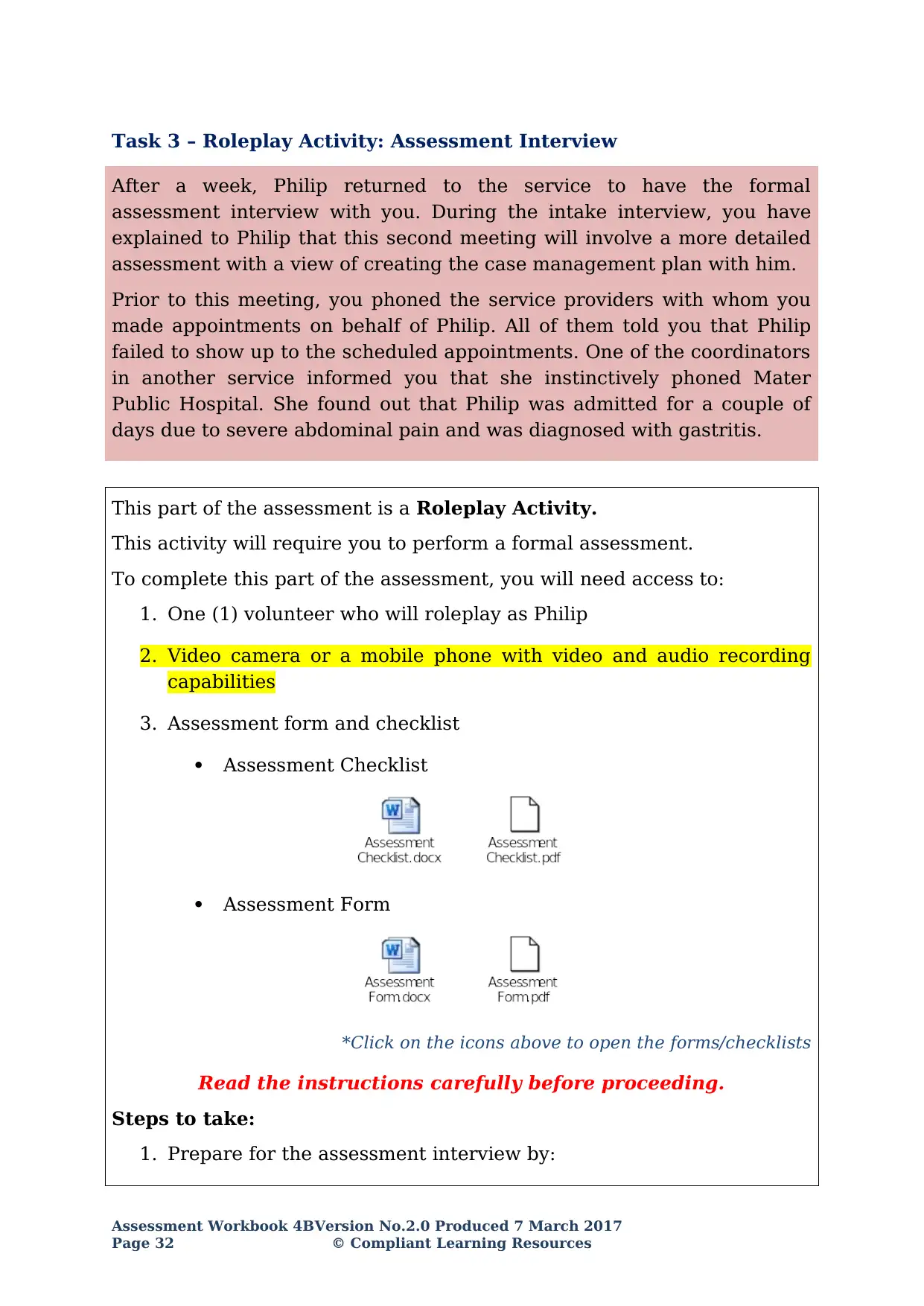
Task 3 – Roleplay Activity: Assessment Interview
After a week, Philip returned to the service to have the formal
assessment interview with you. During the intake interview, you have
explained to Philip that this second meeting will involve a more detailed
assessment with a view of creating the case management plan with him.
Prior to this meeting, you phoned the service providers with whom you
made appointments on behalf of Philip. All of them told you that Philip
failed to show up to the scheduled appointments. One of the coordinators
in another service informed you that she instinctively phoned Mater
Public Hospital. She found out that Philip was admitted for a couple of
days due to severe abdominal pain and was diagnosed with gastritis.
This part of the assessment is a Roleplay Activity.
This activity will require you to perform a formal assessment.
To complete this part of the assessment, you will need access to:
1. One (1) volunteer who will roleplay as Philip
2. Video camera or a mobile phone with video and audio recording
capabilities
3. Assessment form and checklist
Assessment Checklist
Assessment Form
*Click on the icons above to open the forms/checklists
Read the instructions carefully before proceeding.
Steps to take:
1. Prepare for the assessment interview by:
Assessment Workbook 4BVersion No.2.0 Produced 7 March 2017
Page 32 © Compliant Learning Resources
After a week, Philip returned to the service to have the formal
assessment interview with you. During the intake interview, you have
explained to Philip that this second meeting will involve a more detailed
assessment with a view of creating the case management plan with him.
Prior to this meeting, you phoned the service providers with whom you
made appointments on behalf of Philip. All of them told you that Philip
failed to show up to the scheduled appointments. One of the coordinators
in another service informed you that she instinctively phoned Mater
Public Hospital. She found out that Philip was admitted for a couple of
days due to severe abdominal pain and was diagnosed with gastritis.
This part of the assessment is a Roleplay Activity.
This activity will require you to perform a formal assessment.
To complete this part of the assessment, you will need access to:
1. One (1) volunteer who will roleplay as Philip
2. Video camera or a mobile phone with video and audio recording
capabilities
3. Assessment form and checklist
Assessment Checklist
Assessment Form
*Click on the icons above to open the forms/checklists
Read the instructions carefully before proceeding.
Steps to take:
1. Prepare for the assessment interview by:
Assessment Workbook 4BVersion No.2.0 Produced 7 March 2017
Page 32 © Compliant Learning Resources
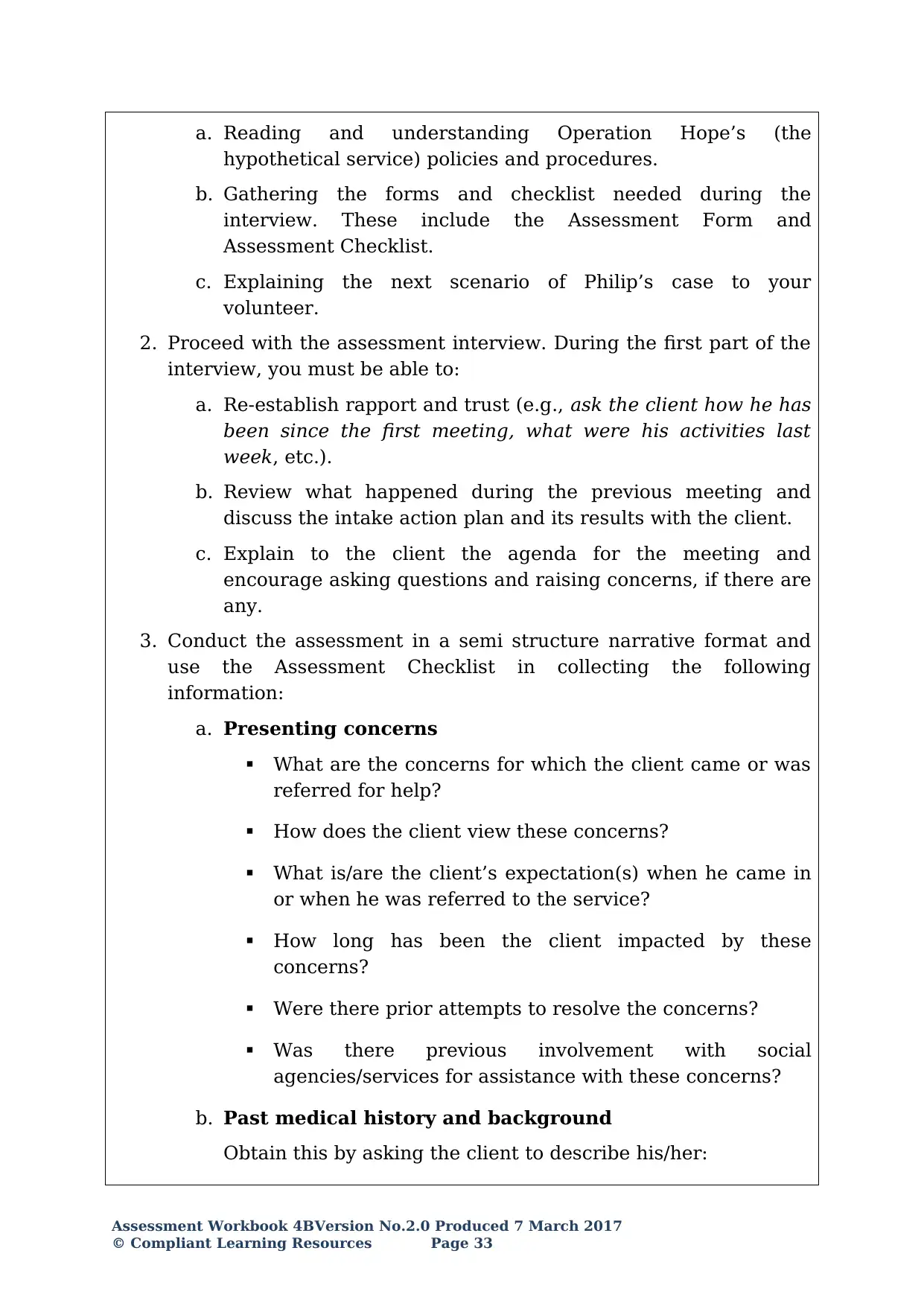
a. Reading and understanding Operation Hope’s (the
hypothetical service) policies and procedures.
b. Gathering the forms and checklist needed during the
interview. These include the Assessment Form and
Assessment Checklist.
c. Explaining the next scenario of Philip’s case to your
volunteer.
2. Proceed with the assessment interview. During the first part of the
interview, you must be able to:
a. Re-establish rapport and trust (e.g., ask the client how he has
been since the first meeting, what were his activities last
week, etc.).
b. Review what happened during the previous meeting and
discuss the intake action plan and its results with the client.
c. Explain to the client the agenda for the meeting and
encourage asking questions and raising concerns, if there are
any.
3. Conduct the assessment in a semi structure narrative format and
use the Assessment Checklist in collecting the following
information:
a. Presenting concerns
What are the concerns for which the client came or was
referred for help?
How does the client view these concerns?
What is/are the client’s expectation(s) when he came in
or when he was referred to the service?
How long has been the client impacted by these
concerns?
Were there prior attempts to resolve the concerns?
Was there previous involvement with social
agencies/services for assistance with these concerns?
b. Past medical history and background
Obtain this by asking the client to describe his/her:
Assessment Workbook 4BVersion No.2.0 Produced 7 March 2017
© Compliant Learning Resources Page 33
hypothetical service) policies and procedures.
b. Gathering the forms and checklist needed during the
interview. These include the Assessment Form and
Assessment Checklist.
c. Explaining the next scenario of Philip’s case to your
volunteer.
2. Proceed with the assessment interview. During the first part of the
interview, you must be able to:
a. Re-establish rapport and trust (e.g., ask the client how he has
been since the first meeting, what were his activities last
week, etc.).
b. Review what happened during the previous meeting and
discuss the intake action plan and its results with the client.
c. Explain to the client the agenda for the meeting and
encourage asking questions and raising concerns, if there are
any.
3. Conduct the assessment in a semi structure narrative format and
use the Assessment Checklist in collecting the following
information:
a. Presenting concerns
What are the concerns for which the client came or was
referred for help?
How does the client view these concerns?
What is/are the client’s expectation(s) when he came in
or when he was referred to the service?
How long has been the client impacted by these
concerns?
Were there prior attempts to resolve the concerns?
Was there previous involvement with social
agencies/services for assistance with these concerns?
b. Past medical history and background
Obtain this by asking the client to describe his/her:
Assessment Workbook 4BVersion No.2.0 Produced 7 March 2017
© Compliant Learning Resources Page 33

Family history – include any health information (i.e.,
conditions and illnesses that run in the family) about the
client’s close relatives from three generations
Past illnesses and conditions – include childhood
illnesses and diagnosed conditions the client has had
previously
Hospitalisations – include the primary reason for
admission
Surgeries and procedures – include any past surgeries
or other major medical procedures
Significant injuries – include all types of injuries that
resulted in disability or altered activity
Medications – include prescription, over-the-counter and
supplementary medicines that the client has taken in
the past
History of mental concerns
c. Previous agency involvements
Has the client asked for assistance or was referred to
any social agencies/services prior? If yes, list all the
names and include the services that the client received
previously.
d. Psychosocial and behavioural health
Ask the client the following questions to be able to
gather data about his level of psychosocial and
behavioural well-being:
- How do you feel about the things going on with
your life at the moment?
- What is it that troubles you most about the
situation?
- How are you handling this/these thing(s) that
trouble you?
Observe the attitude, appearance, behaviour, thought
process and insight of the client all throughout the
Assessment Workbook 4BVersion No.2.0 Produced 7 March 2017
Page 34 © Compliant Learning Resources
conditions and illnesses that run in the family) about the
client’s close relatives from three generations
Past illnesses and conditions – include childhood
illnesses and diagnosed conditions the client has had
previously
Hospitalisations – include the primary reason for
admission
Surgeries and procedures – include any past surgeries
or other major medical procedures
Significant injuries – include all types of injuries that
resulted in disability or altered activity
Medications – include prescription, over-the-counter and
supplementary medicines that the client has taken in
the past
History of mental concerns
c. Previous agency involvements
Has the client asked for assistance or was referred to
any social agencies/services prior? If yes, list all the
names and include the services that the client received
previously.
d. Psychosocial and behavioural health
Ask the client the following questions to be able to
gather data about his level of psychosocial and
behavioural well-being:
- How do you feel about the things going on with
your life at the moment?
- What is it that troubles you most about the
situation?
- How are you handling this/these thing(s) that
trouble you?
Observe the attitude, appearance, behaviour, thought
process and insight of the client all throughout the
Assessment Workbook 4BVersion No.2.0 Produced 7 March 2017
Page 34 © Compliant Learning Resources
Secure Best Marks with AI Grader
Need help grading? Try our AI Grader for instant feedback on your assignments.
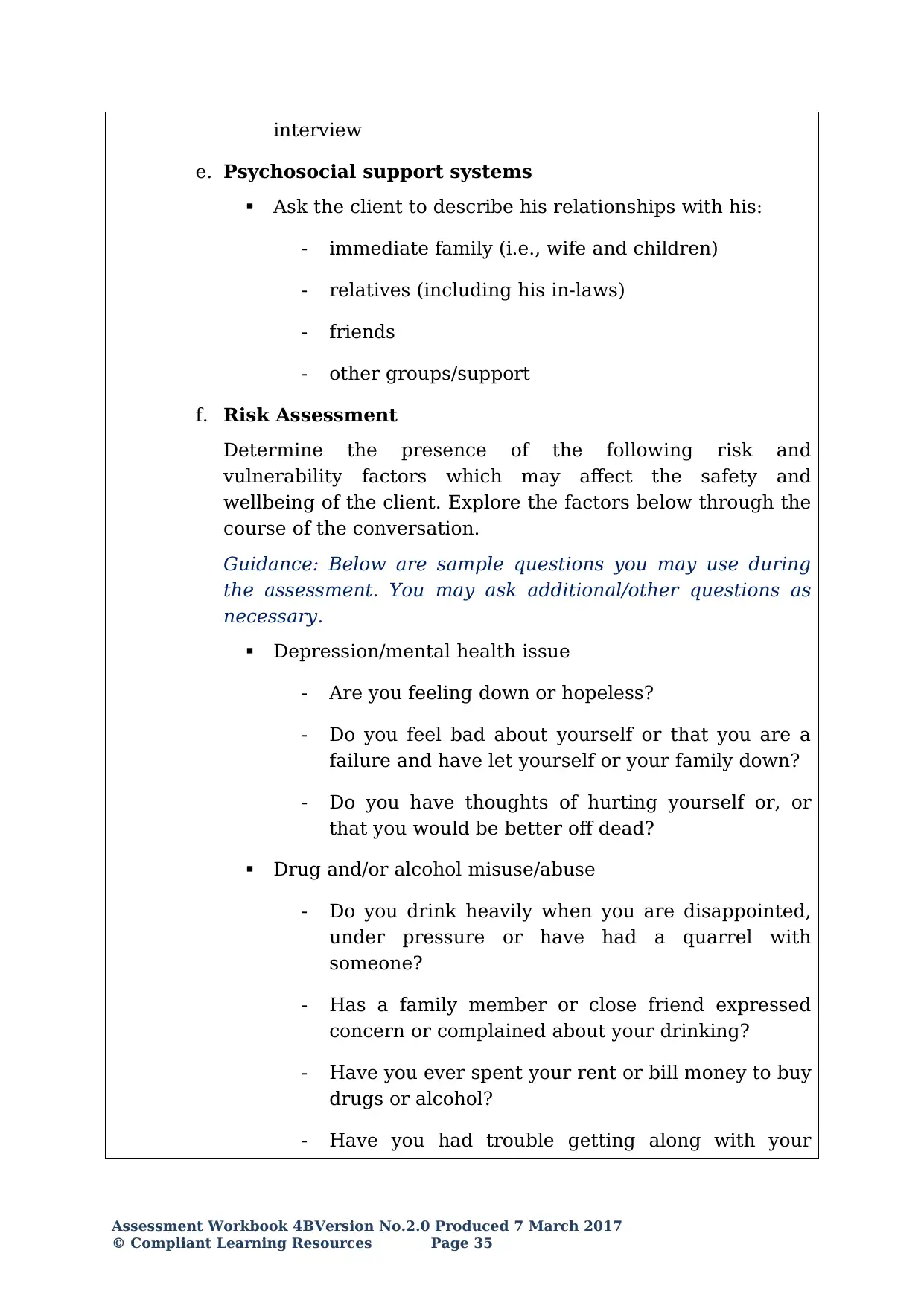
interview
e. Psychosocial support systems
Ask the client to describe his relationships with his:
- immediate family (i.e., wife and children)
- relatives (including his in-laws)
- friends
- other groups/support
f. Risk Assessment
Determine the presence of the following risk and
vulnerability factors which may affect the safety and
wellbeing of the client. Explore the factors below through the
course of the conversation.
Guidance: Below are sample questions you may use during
the assessment. You may ask additional/other questions as
necessary.
Depression/mental health issue
- Are you feeling down or hopeless?
- Do you feel bad about yourself or that you are a
failure and have let yourself or your family down?
- Do you have thoughts of hurting yourself or, or
that you would be better off dead?
Drug and/or alcohol misuse/abuse
- Do you drink heavily when you are disappointed,
under pressure or have had a quarrel with
someone?
- Has a family member or close friend expressed
concern or complained about your drinking?
- Have you ever spent your rent or bill money to buy
drugs or alcohol?
- Have you had trouble getting along with your
Assessment Workbook 4BVersion No.2.0 Produced 7 March 2017
© Compliant Learning Resources Page 35
e. Psychosocial support systems
Ask the client to describe his relationships with his:
- immediate family (i.e., wife and children)
- relatives (including his in-laws)
- friends
- other groups/support
f. Risk Assessment
Determine the presence of the following risk and
vulnerability factors which may affect the safety and
wellbeing of the client. Explore the factors below through the
course of the conversation.
Guidance: Below are sample questions you may use during
the assessment. You may ask additional/other questions as
necessary.
Depression/mental health issue
- Are you feeling down or hopeless?
- Do you feel bad about yourself or that you are a
failure and have let yourself or your family down?
- Do you have thoughts of hurting yourself or, or
that you would be better off dead?
Drug and/or alcohol misuse/abuse
- Do you drink heavily when you are disappointed,
under pressure or have had a quarrel with
someone?
- Has a family member or close friend expressed
concern or complained about your drinking?
- Have you ever spent your rent or bill money to buy
drugs or alcohol?
- Have you had trouble getting along with your
Assessment Workbook 4BVersion No.2.0 Produced 7 March 2017
© Compliant Learning Resources Page 35
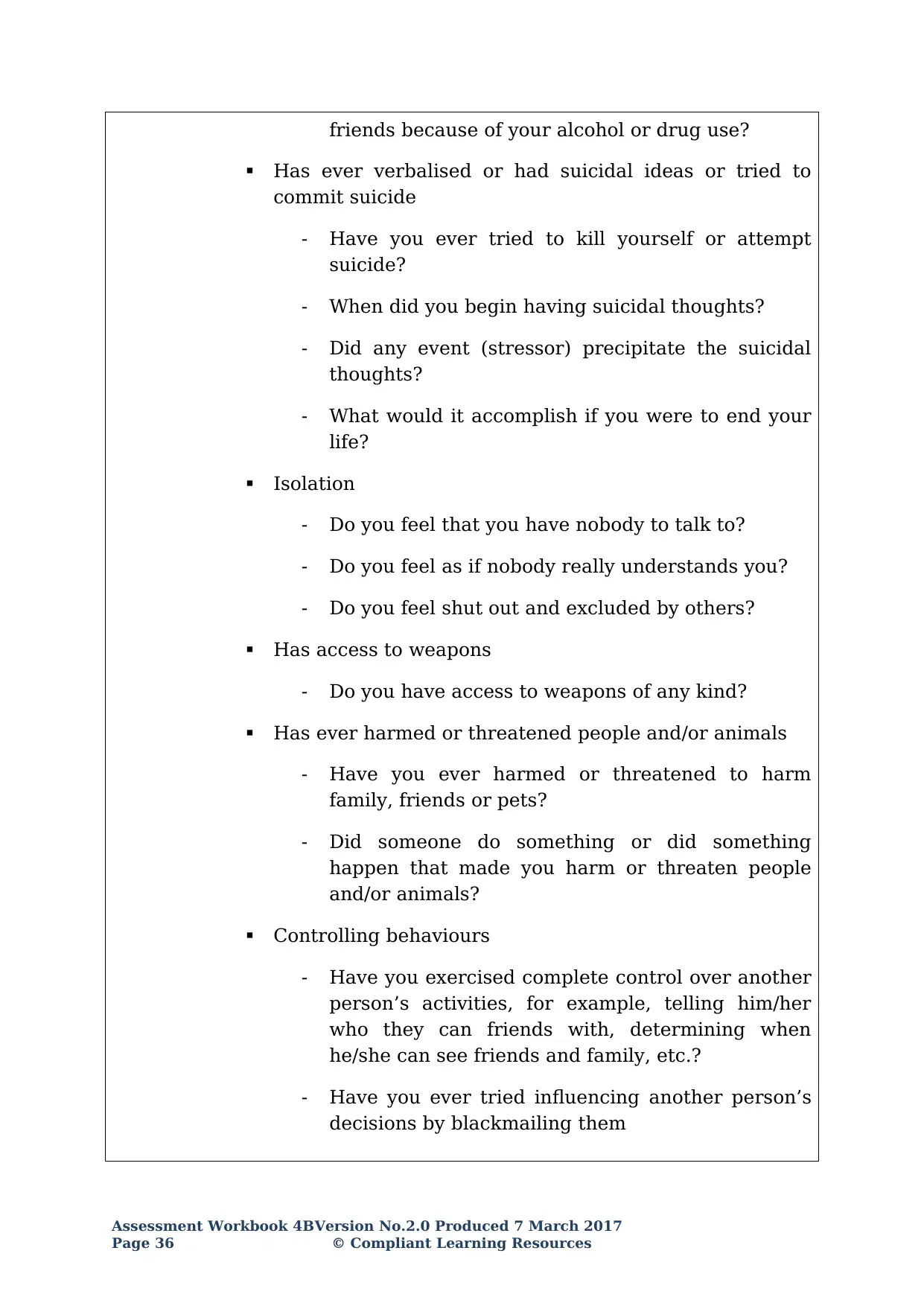
friends because of your alcohol or drug use?
Has ever verbalised or had suicidal ideas or tried to
commit suicide
- Have you ever tried to kill yourself or attempt
suicide?
- When did you begin having suicidal thoughts?
- Did any event (stressor) precipitate the suicidal
thoughts?
- What would it accomplish if you were to end your
life?
Isolation
- Do you feel that you have nobody to talk to?
- Do you feel as if nobody really understands you?
- Do you feel shut out and excluded by others?
Has access to weapons
- Do you have access to weapons of any kind?
Has ever harmed or threatened people and/or animals
- Have you ever harmed or threatened to harm
family, friends or pets?
- Did someone do something or did something
happen that made you harm or threaten people
and/or animals?
Controlling behaviours
- Have you exercised complete control over another
person’s activities, for example, telling him/her
who they can friends with, determining when
he/she can see friends and family, etc.?
- Have you ever tried influencing another person’s
decisions by blackmailing them
Assessment Workbook 4BVersion No.2.0 Produced 7 March 2017
Page 36 © Compliant Learning Resources
Has ever verbalised or had suicidal ideas or tried to
commit suicide
- Have you ever tried to kill yourself or attempt
suicide?
- When did you begin having suicidal thoughts?
- Did any event (stressor) precipitate the suicidal
thoughts?
- What would it accomplish if you were to end your
life?
Isolation
- Do you feel that you have nobody to talk to?
- Do you feel as if nobody really understands you?
- Do you feel shut out and excluded by others?
Has access to weapons
- Do you have access to weapons of any kind?
Has ever harmed or threatened people and/or animals
- Have you ever harmed or threatened to harm
family, friends or pets?
- Did someone do something or did something
happen that made you harm or threaten people
and/or animals?
Controlling behaviours
- Have you exercised complete control over another
person’s activities, for example, telling him/her
who they can friends with, determining when
he/she can see friends and family, etc.?
- Have you ever tried influencing another person’s
decisions by blackmailing them
Assessment Workbook 4BVersion No.2.0 Produced 7 March 2017
Page 36 © Compliant Learning Resources
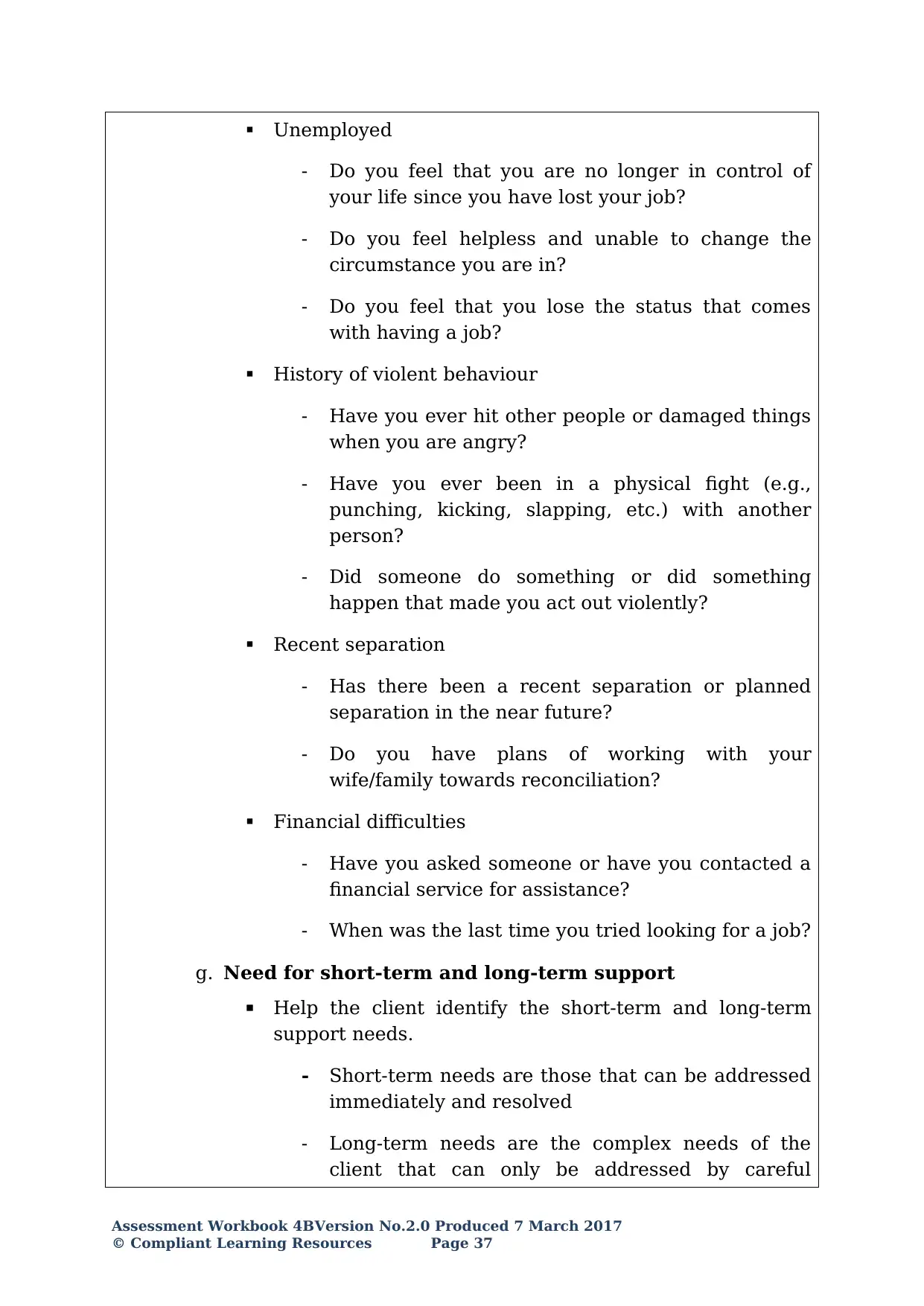
Unemployed
- Do you feel that you are no longer in control of
your life since you have lost your job?
- Do you feel helpless and unable to change the
circumstance you are in?
- Do you feel that you lose the status that comes
with having a job?
History of violent behaviour
- Have you ever hit other people or damaged things
when you are angry?
- Have you ever been in a physical fight (e.g.,
punching, kicking, slapping, etc.) with another
person?
- Did someone do something or did something
happen that made you act out violently?
Recent separation
- Has there been a recent separation or planned
separation in the near future?
- Do you have plans of working with your
wife/family towards reconciliation?
Financial difficulties
- Have you asked someone or have you contacted a
financial service for assistance?
- When was the last time you tried looking for a job?
g. Need for short-term and long-term support
Help the client identify the short-term and long-term
support needs.
- Short-term needs are those that can be addressed
immediately and resolved
- Long-term needs are the complex needs of the
client that can only be addressed by careful
Assessment Workbook 4BVersion No.2.0 Produced 7 March 2017
© Compliant Learning Resources Page 37
- Do you feel that you are no longer in control of
your life since you have lost your job?
- Do you feel helpless and unable to change the
circumstance you are in?
- Do you feel that you lose the status that comes
with having a job?
History of violent behaviour
- Have you ever hit other people or damaged things
when you are angry?
- Have you ever been in a physical fight (e.g.,
punching, kicking, slapping, etc.) with another
person?
- Did someone do something or did something
happen that made you act out violently?
Recent separation
- Has there been a recent separation or planned
separation in the near future?
- Do you have plans of working with your
wife/family towards reconciliation?
Financial difficulties
- Have you asked someone or have you contacted a
financial service for assistance?
- When was the last time you tried looking for a job?
g. Need for short-term and long-term support
Help the client identify the short-term and long-term
support needs.
- Short-term needs are those that can be addressed
immediately and resolved
- Long-term needs are the complex needs of the
client that can only be addressed by careful
Assessment Workbook 4BVersion No.2.0 Produced 7 March 2017
© Compliant Learning Resources Page 37
Paraphrase This Document
Need a fresh take? Get an instant paraphrase of this document with our AI Paraphraser

planning and coordination with other
support/services
h. Strengths, weaknesses, goals
Assist the client in identifying his strengths, weaknesses, and
goals. The following questions may assist the client:
What are your personal attributes?
What are your talents and skills?
What are your environmental strengths (e.g., personal
relations, physical resources, opportunities, etc.)?
What are your interests, aspirations and goals?
What are the barriers that may have negative effect to
achieving your goals?
i. Additional information
Additional questions you may ask the client include the
following:
What is/are the expectation(s) of the client?
Is there any person the client does not want to see
and/or have contact with?
Is there any information that the client does not wish to
be disclosed?
Does the client have any special request that they would
like the service to assist them with?
Does the client have any additional information that
they would like you to know about in order to offer them
support?
4. Review the points discussed during the interview, inform the client
that the information collected will be used to create a case
management plan, and close it by scheduling another appointment
in a week for the case conference.
Guidelines
1. To demonstrate your completion of this activity, the intake interview
Assessment Workbook 4BVersion No.2.0 Produced 7 March 2017
Page 38 © Compliant Learning Resources
support/services
h. Strengths, weaknesses, goals
Assist the client in identifying his strengths, weaknesses, and
goals. The following questions may assist the client:
What are your personal attributes?
What are your talents and skills?
What are your environmental strengths (e.g., personal
relations, physical resources, opportunities, etc.)?
What are your interests, aspirations and goals?
What are the barriers that may have negative effect to
achieving your goals?
i. Additional information
Additional questions you may ask the client include the
following:
What is/are the expectation(s) of the client?
Is there any person the client does not want to see
and/or have contact with?
Is there any information that the client does not wish to
be disclosed?
Does the client have any special request that they would
like the service to assist them with?
Does the client have any additional information that
they would like you to know about in order to offer them
support?
4. Review the points discussed during the interview, inform the client
that the information collected will be used to create a case
management plan, and close it by scheduling another appointment
in a week for the case conference.
Guidelines
1. To demonstrate your completion of this activity, the intake interview
Assessment Workbook 4BVersion No.2.0 Produced 7 March 2017
Page 38 © Compliant Learning Resources

must be recorded. Save the recorded video using the filename:
[Last Name, First Name]_Subject 4 – Roleplay Activity-2
For example, as seen below:
Smith, John_Subject 4 –
Roleplay Activity-2.avi
2. Your video submission must not be longer than forty-five (45)
minutes in length. Any submission longer than forty-five (45)
minutes will be considered not satisfactory.
3. There is no specific script to be followed in the roleplay activity.
However, you must be able to demonstrate all steps outlined above.
Moreover, your submission will be assessed against the checklist
provided below.
Assessment Workbook 4BVersion No.2.0 Produced 7 March 2017
© Compliant Learning Resources Page 39
[Last Name, First Name]_Subject 4 – Roleplay Activity-2
For example, as seen below:
Smith, John_Subject 4 –
Roleplay Activity-2.avi
2. Your video submission must not be longer than forty-five (45)
minutes in length. Any submission longer than forty-five (45)
minutes will be considered not satisfactory.
3. There is no specific script to be followed in the roleplay activity.
However, you must be able to demonstrate all steps outlined above.
Moreover, your submission will be assessed against the checklist
provided below.
Assessment Workbook 4BVersion No.2.0 Produced 7 March 2017
© Compliant Learning Resources Page 39
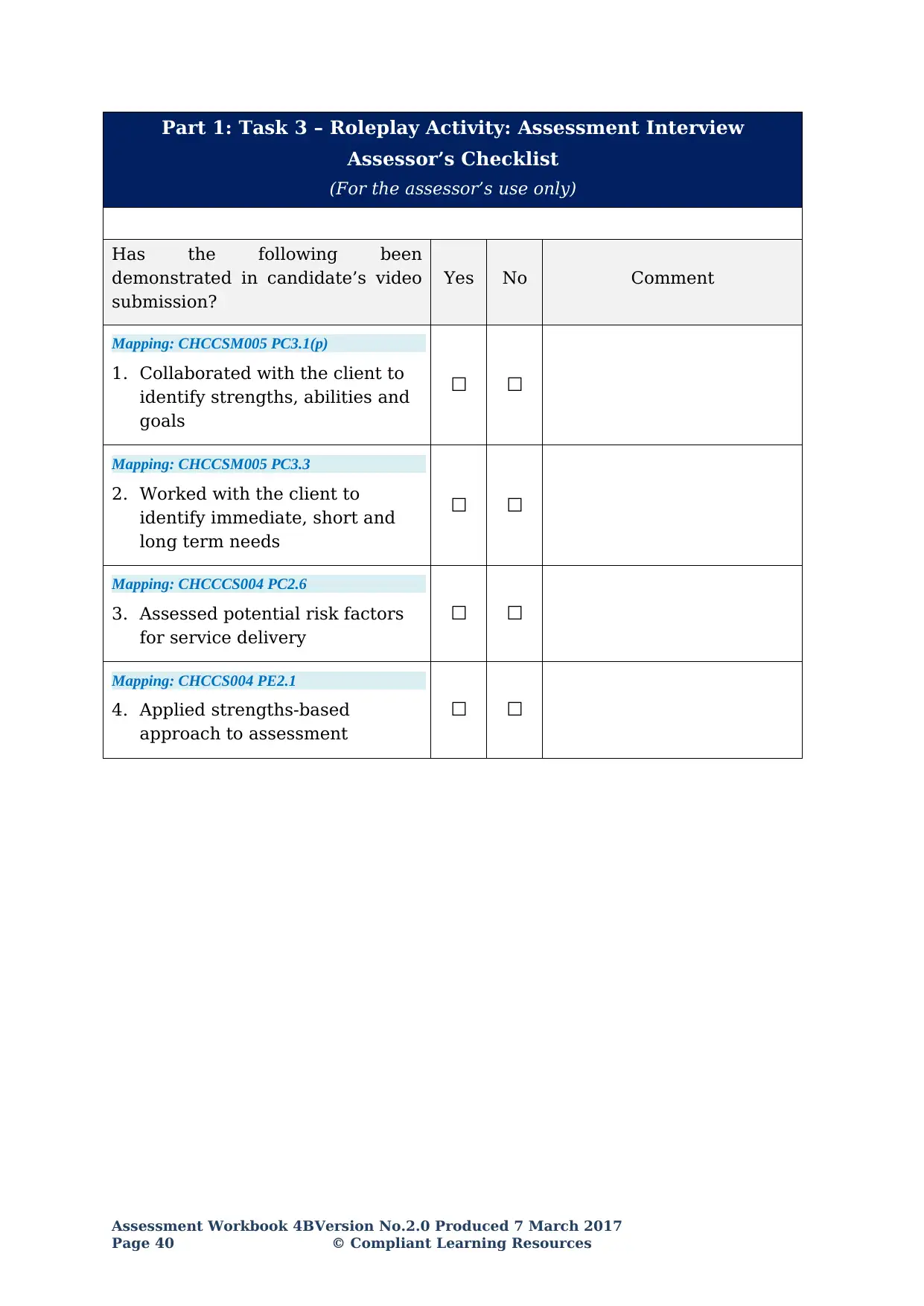
Part 1: Task 3 – Roleplay Activity: Assessment Interview
Assessor’s Checklist
(For the assessor’s use only)
Has the following been
demonstrated in candidate’s video
submission?
Yes No Comment
Mapping: CHCCSM005 PC3.1(p)
1. Collaborated with the client to
identify strengths, abilities and
goals
☐ ☐
Mapping: CHCCSM005 PC3.3
2. Worked with the client to
identify immediate, short and
long term needs
☐ ☐
Mapping: CHCCCS004 PC2.6
3. Assessed potential risk factors
for service delivery
☐ ☐
Mapping: CHCCS004 PE2.1
4. Applied strengths-based
approach to assessment
☐ ☐
Assessment Workbook 4BVersion No.2.0 Produced 7 March 2017
Page 40 © Compliant Learning Resources
Assessor’s Checklist
(For the assessor’s use only)
Has the following been
demonstrated in candidate’s video
submission?
Yes No Comment
Mapping: CHCCSM005 PC3.1(p)
1. Collaborated with the client to
identify strengths, abilities and
goals
☐ ☐
Mapping: CHCCSM005 PC3.3
2. Worked with the client to
identify immediate, short and
long term needs
☐ ☐
Mapping: CHCCCS004 PC2.6
3. Assessed potential risk factors
for service delivery
☐ ☐
Mapping: CHCCS004 PE2.1
4. Applied strengths-based
approach to assessment
☐ ☐
Assessment Workbook 4BVersion No.2.0 Produced 7 March 2017
Page 40 © Compliant Learning Resources
Secure Best Marks with AI Grader
Need help grading? Try our AI Grader for instant feedback on your assignments.

Task 4 – Document the Outcome of the Assessment Interview
This part of the assessment will require you to document the outcome of
the assessment interview using the Assessment Form.
*Click on the icons above to open the forms
Read the instructions carefully before proceeding.
Steps to take:
1. Transcribe the information collected from the Assessment
Interview using the Assessment Form.
2. Summarise each item listed in the Assessment Checklist.
Bullet points may be used in lieu of a narrative/essay format.
Paraphrasing may be used to convey the general idea of what
is being said.
Record the client’s exact words using quotations marks if
there is a need to highlight his/her statement(s).
3. Follow these guidelines in documenting the assessment interview:
Use simple but appropriate language. Slangs may only be
used if the client’s exact words are being recorded.
Write objectively, concisely in the active voice, and include
only necessary information.
4. Submit the completed Assessment Form and Checklist using the
following naming convention:
Filename
Assessmen
t Checklist
[Last Name, First Name]_Subject 4 – Assessment
Checklist
Assessmen
t Form [Last Name, First Name]_Subject 4 – Assessment Form
Assessment Workbook 4BVersion No.2.0 Produced 7 March 2017
© Compliant Learning Resources Page 41
This part of the assessment will require you to document the outcome of
the assessment interview using the Assessment Form.
*Click on the icons above to open the forms
Read the instructions carefully before proceeding.
Steps to take:
1. Transcribe the information collected from the Assessment
Interview using the Assessment Form.
2. Summarise each item listed in the Assessment Checklist.
Bullet points may be used in lieu of a narrative/essay format.
Paraphrasing may be used to convey the general idea of what
is being said.
Record the client’s exact words using quotations marks if
there is a need to highlight his/her statement(s).
3. Follow these guidelines in documenting the assessment interview:
Use simple but appropriate language. Slangs may only be
used if the client’s exact words are being recorded.
Write objectively, concisely in the active voice, and include
only necessary information.
4. Submit the completed Assessment Form and Checklist using the
following naming convention:
Filename
Assessmen
t Checklist
[Last Name, First Name]_Subject 4 – Assessment
Checklist
Assessmen
t Form [Last Name, First Name]_Subject 4 – Assessment Form
Assessment Workbook 4BVersion No.2.0 Produced 7 March 2017
© Compliant Learning Resources Page 41
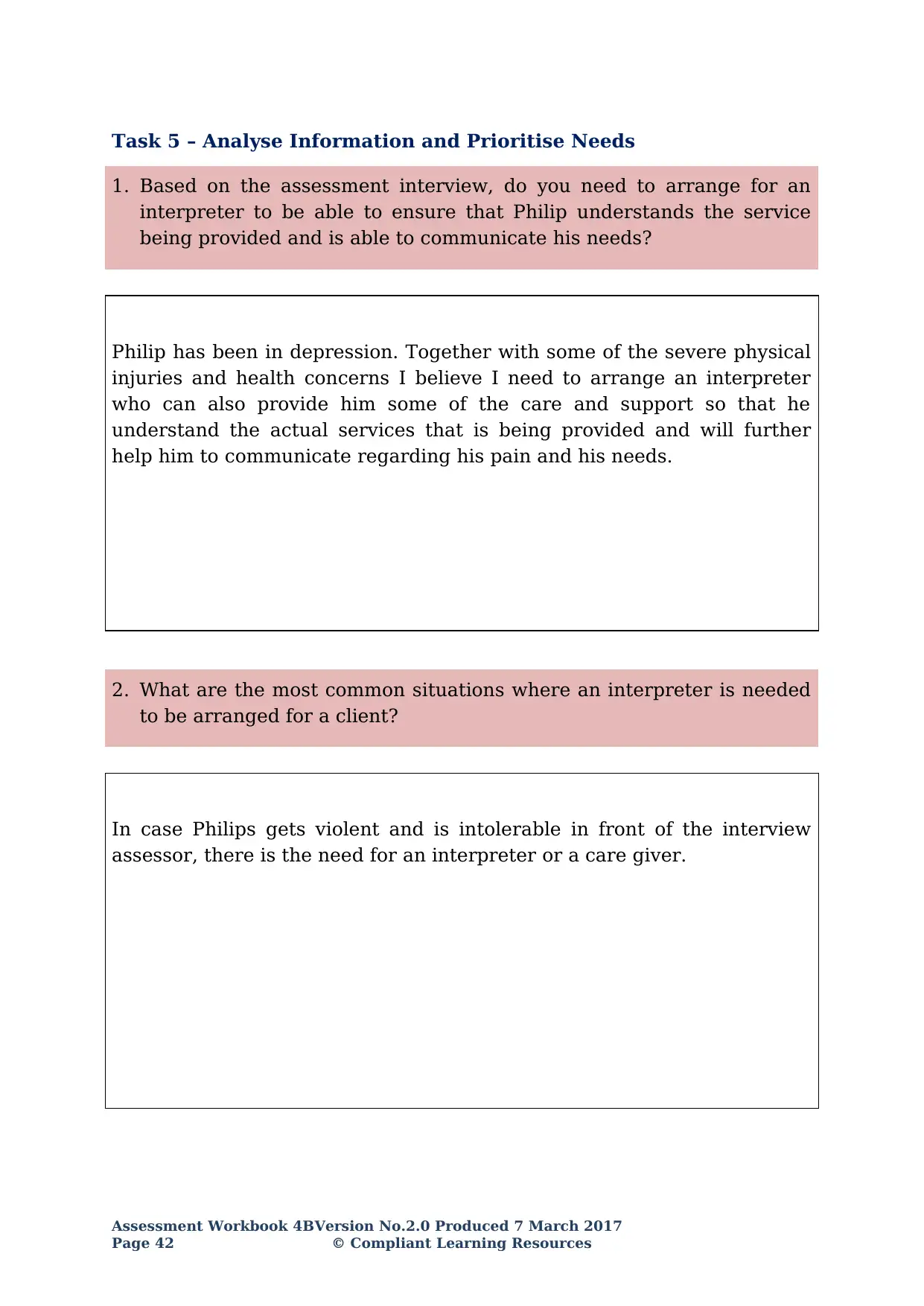
Task 5 – Analyse Information and Prioritise Needs
1. Based on the assessment interview, do you need to arrange for an
interpreter to be able to ensure that Philip understands the service
being provided and is able to communicate his needs?
Philip has been in depression. Together with some of the severe physical
injuries and health concerns I believe I need to arrange an interpreter
who can also provide him some of the care and support so that he
understand the actual services that is being provided and will further
help him to communicate regarding his pain and his needs.
2. What are the most common situations where an interpreter is needed
to be arranged for a client?
In case Philips gets violent and is intolerable in front of the interview
assessor, there is the need for an interpreter or a care giver.
Assessment Workbook 4BVersion No.2.0 Produced 7 March 2017
Page 42 © Compliant Learning Resources
1. Based on the assessment interview, do you need to arrange for an
interpreter to be able to ensure that Philip understands the service
being provided and is able to communicate his needs?
Philip has been in depression. Together with some of the severe physical
injuries and health concerns I believe I need to arrange an interpreter
who can also provide him some of the care and support so that he
understand the actual services that is being provided and will further
help him to communicate regarding his pain and his needs.
2. What are the most common situations where an interpreter is needed
to be arranged for a client?
In case Philips gets violent and is intolerable in front of the interview
assessor, there is the need for an interpreter or a care giver.
Assessment Workbook 4BVersion No.2.0 Produced 7 March 2017
Page 42 © Compliant Learning Resources

3. Find out about using interpreter services that are available through
your workplace or in your area by:
Locating and printing a copy of your workplace guidelines
and/or procedures regarding the use of interpreters. Submit
the copy together with this workbook.
Locating and printing a copy of the interpreter request form
use by your workplace. Submit the copy of the request form
together with this workbook.
Collecting at least two (2) examples, such as brochures or
instructions describing workplace or community interpreting
services. Scan the brochures/instructions and submit it
together with this workbook. Identify at least two (2) links to online information that
could help.
Guidance: From the options provided, choose and accomplish one (1).
Filename of guidelines/procedures, request form or
brochures/instructions:
OR
Links to online information:
https://www.ncbi.nlm.nih.gov/pmc/articles/PMC5837128/
https://academic.oup.com/heapro/article/30/1/29/2805761
Assessment Workbook 4BVersion No.2.0 Produced 7 March 2017
© Compliant Learning Resources Page 43
your workplace or in your area by:
Locating and printing a copy of your workplace guidelines
and/or procedures regarding the use of interpreters. Submit
the copy together with this workbook.
Locating and printing a copy of the interpreter request form
use by your workplace. Submit the copy of the request form
together with this workbook.
Collecting at least two (2) examples, such as brochures or
instructions describing workplace or community interpreting
services. Scan the brochures/instructions and submit it
together with this workbook. Identify at least two (2) links to online information that
could help.
Guidance: From the options provided, choose and accomplish one (1).
Filename of guidelines/procedures, request form or
brochures/instructions:
OR
Links to online information:
https://www.ncbi.nlm.nih.gov/pmc/articles/PMC5837128/
https://academic.oup.com/heapro/article/30/1/29/2805761
Assessment Workbook 4BVersion No.2.0 Produced 7 March 2017
© Compliant Learning Resources Page 43
Paraphrase This Document
Need a fresh take? Get an instant paraphrase of this document with our AI Paraphraser
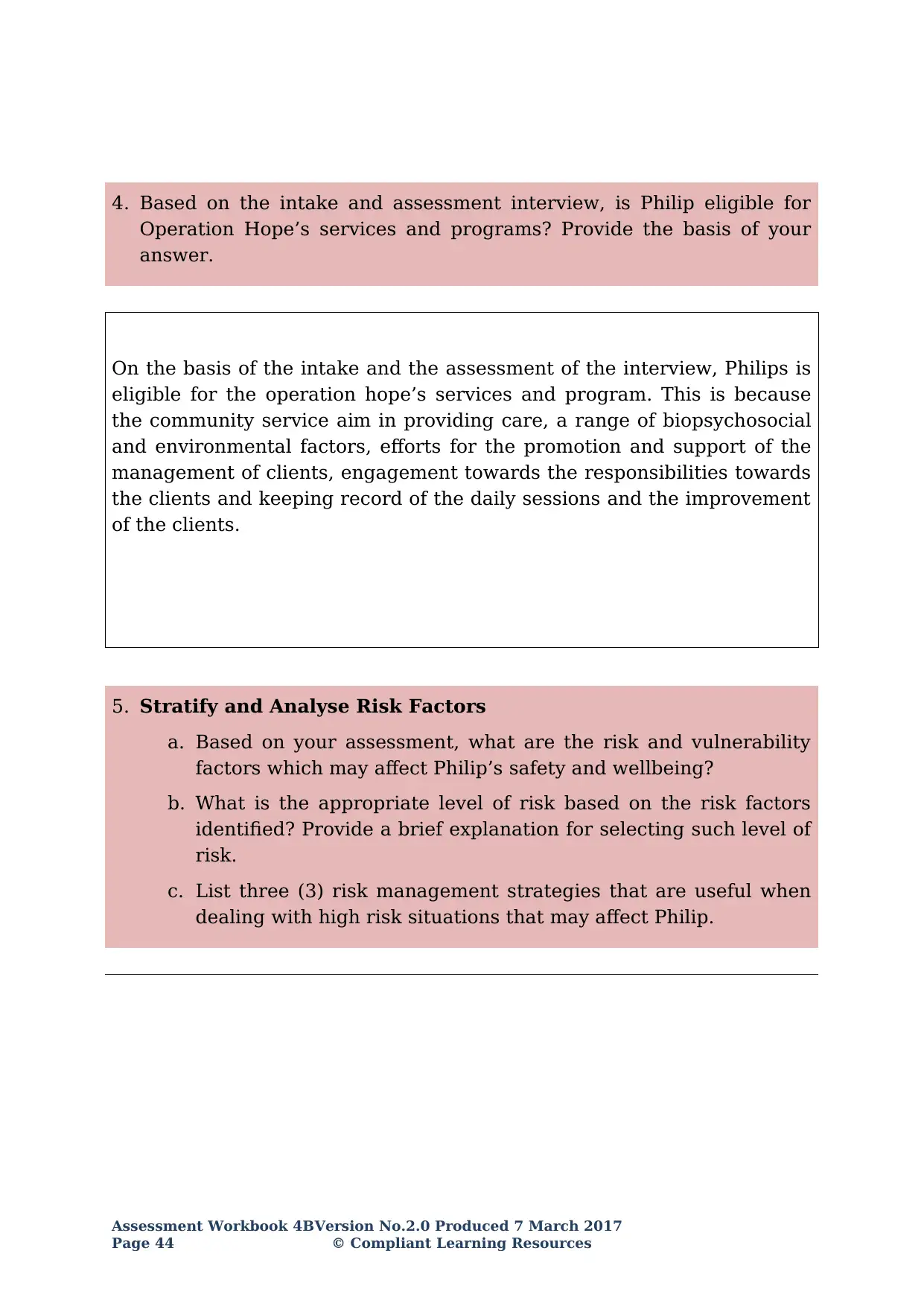
4. Based on the intake and assessment interview, is Philip eligible for
Operation Hope’s services and programs? Provide the basis of your
answer.
On the basis of the intake and the assessment of the interview, Philips is
eligible for the operation hope’s services and program. This is because
the community service aim in providing care, a range of biopsychosocial
and environmental factors, efforts for the promotion and support of the
management of clients, engagement towards the responsibilities towards
the clients and keeping record of the daily sessions and the improvement
of the clients.
5. Stratify and Analyse Risk Factors
a. Based on your assessment, what are the risk and vulnerability
factors which may affect Philip’s safety and wellbeing?
b. What is the appropriate level of risk based on the risk factors
identified? Provide a brief explanation for selecting such level of
risk.
c. List three (3) risk management strategies that are useful when
dealing with high risk situations that may affect Philip.
Assessment Workbook 4BVersion No.2.0 Produced 7 March 2017
Page 44 © Compliant Learning Resources
Operation Hope’s services and programs? Provide the basis of your
answer.
On the basis of the intake and the assessment of the interview, Philips is
eligible for the operation hope’s services and program. This is because
the community service aim in providing care, a range of biopsychosocial
and environmental factors, efforts for the promotion and support of the
management of clients, engagement towards the responsibilities towards
the clients and keeping record of the daily sessions and the improvement
of the clients.
5. Stratify and Analyse Risk Factors
a. Based on your assessment, what are the risk and vulnerability
factors which may affect Philip’s safety and wellbeing?
b. What is the appropriate level of risk based on the risk factors
identified? Provide a brief explanation for selecting such level of
risk.
c. List three (3) risk management strategies that are useful when
dealing with high risk situations that may affect Philip.
Assessment Workbook 4BVersion No.2.0 Produced 7 March 2017
Page 44 © Compliant Learning Resources
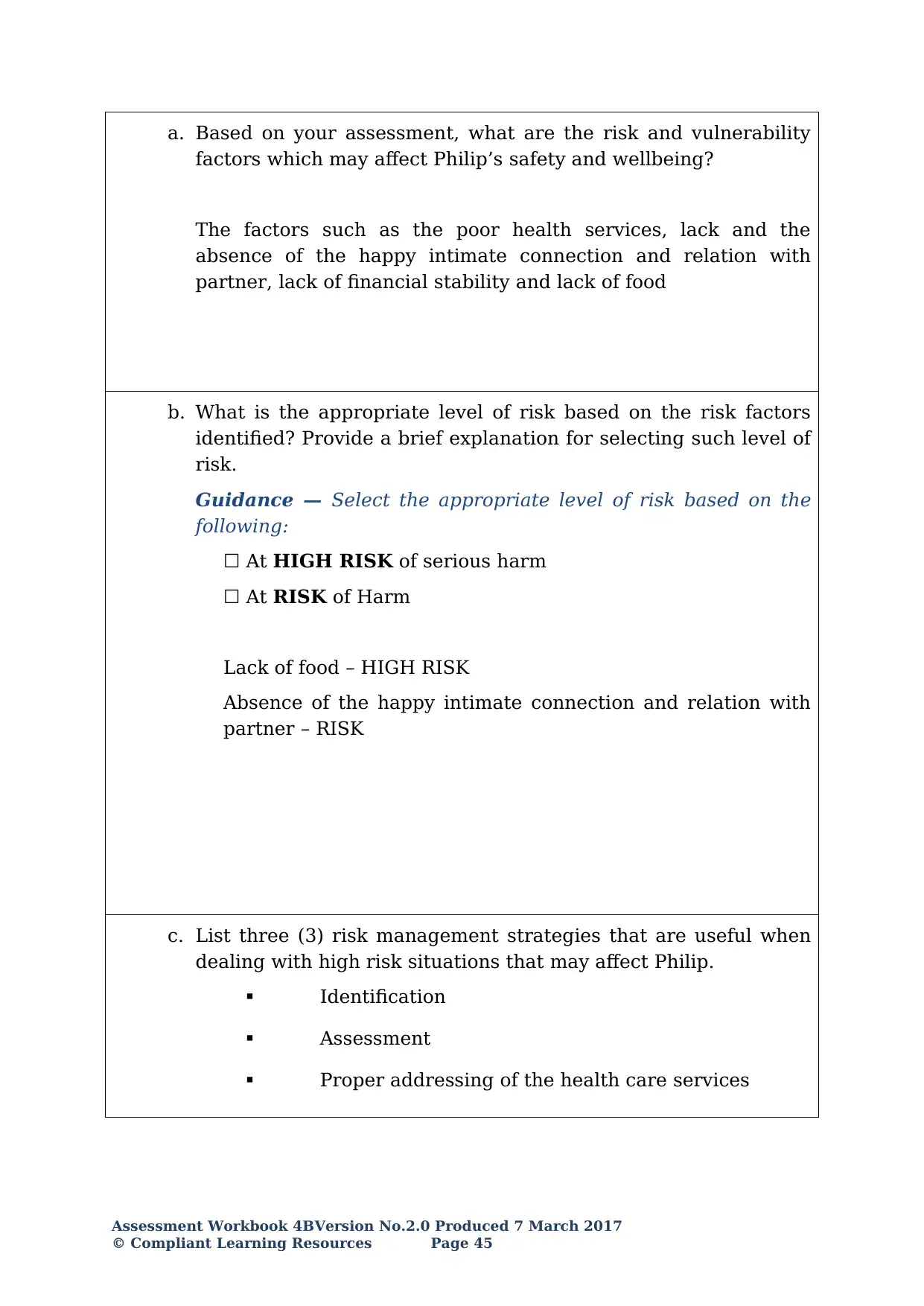
a. Based on your assessment, what are the risk and vulnerability
factors which may affect Philip’s safety and wellbeing?
The factors such as the poor health services, lack and the
absence of the happy intimate connection and relation with
partner, lack of financial stability and lack of food
b. What is the appropriate level of risk based on the risk factors
identified? Provide a brief explanation for selecting such level of
risk.
Guidance — Select the appropriate level of risk based on the
following:
☐ At HIGH RISK of serious harm
☐ At RISK of Harm
Lack of food – HIGH RISK
Absence of the happy intimate connection and relation with
partner – RISK
c. List three (3) risk management strategies that are useful when
dealing with high risk situations that may affect Philip.
Identification
Assessment
Proper addressing of the health care services
Assessment Workbook 4BVersion No.2.0 Produced 7 March 2017
© Compliant Learning Resources Page 45
factors which may affect Philip’s safety and wellbeing?
The factors such as the poor health services, lack and the
absence of the happy intimate connection and relation with
partner, lack of financial stability and lack of food
b. What is the appropriate level of risk based on the risk factors
identified? Provide a brief explanation for selecting such level of
risk.
Guidance — Select the appropriate level of risk based on the
following:
☐ At HIGH RISK of serious harm
☐ At RISK of Harm
Lack of food – HIGH RISK
Absence of the happy intimate connection and relation with
partner – RISK
c. List three (3) risk management strategies that are useful when
dealing with high risk situations that may affect Philip.
Identification
Assessment
Proper addressing of the health care services
Assessment Workbook 4BVersion No.2.0 Produced 7 March 2017
© Compliant Learning Resources Page 45
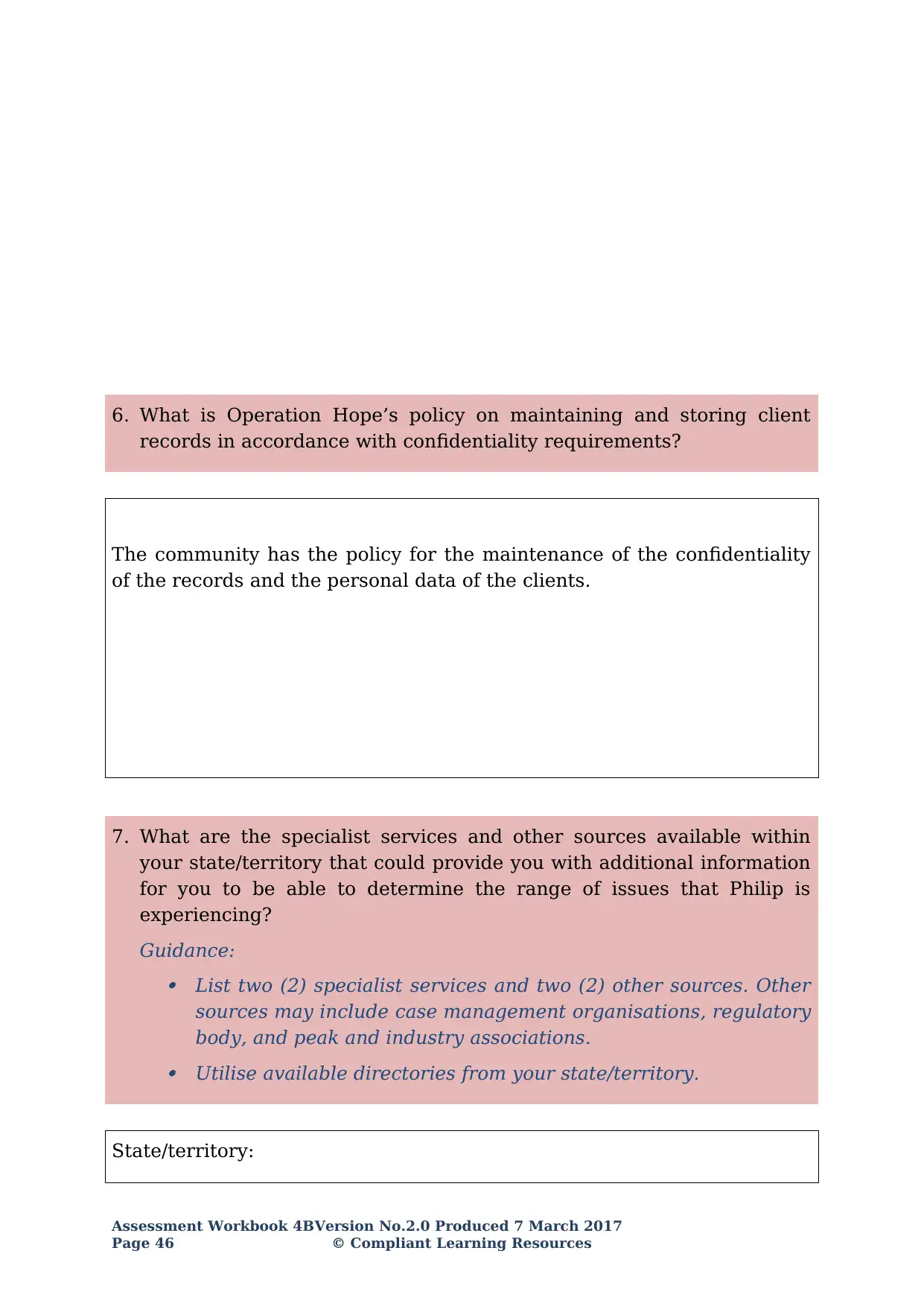
6. What is Operation Hope’s policy on maintaining and storing client
records in accordance with confidentiality requirements?
The community has the policy for the maintenance of the confidentiality
of the records and the personal data of the clients.
7. What are the specialist services and other sources available within
your state/territory that could provide you with additional information
for you to be able to determine the range of issues that Philip is
experiencing?
Guidance:
List two (2) specialist services and two (2) other sources. Other
sources may include case management organisations, regulatory
body, and peak and industry associations.
Utilise available directories from your state/territory.
State/territory:
Assessment Workbook 4BVersion No.2.0 Produced 7 March 2017
Page 46 © Compliant Learning Resources
records in accordance with confidentiality requirements?
The community has the policy for the maintenance of the confidentiality
of the records and the personal data of the clients.
7. What are the specialist services and other sources available within
your state/territory that could provide you with additional information
for you to be able to determine the range of issues that Philip is
experiencing?
Guidance:
List two (2) specialist services and two (2) other sources. Other
sources may include case management organisations, regulatory
body, and peak and industry associations.
Utilise available directories from your state/territory.
State/territory:
Assessment Workbook 4BVersion No.2.0 Produced 7 March 2017
Page 46 © Compliant Learning Resources
Secure Best Marks with AI Grader
Need help grading? Try our AI Grader for instant feedback on your assignments.
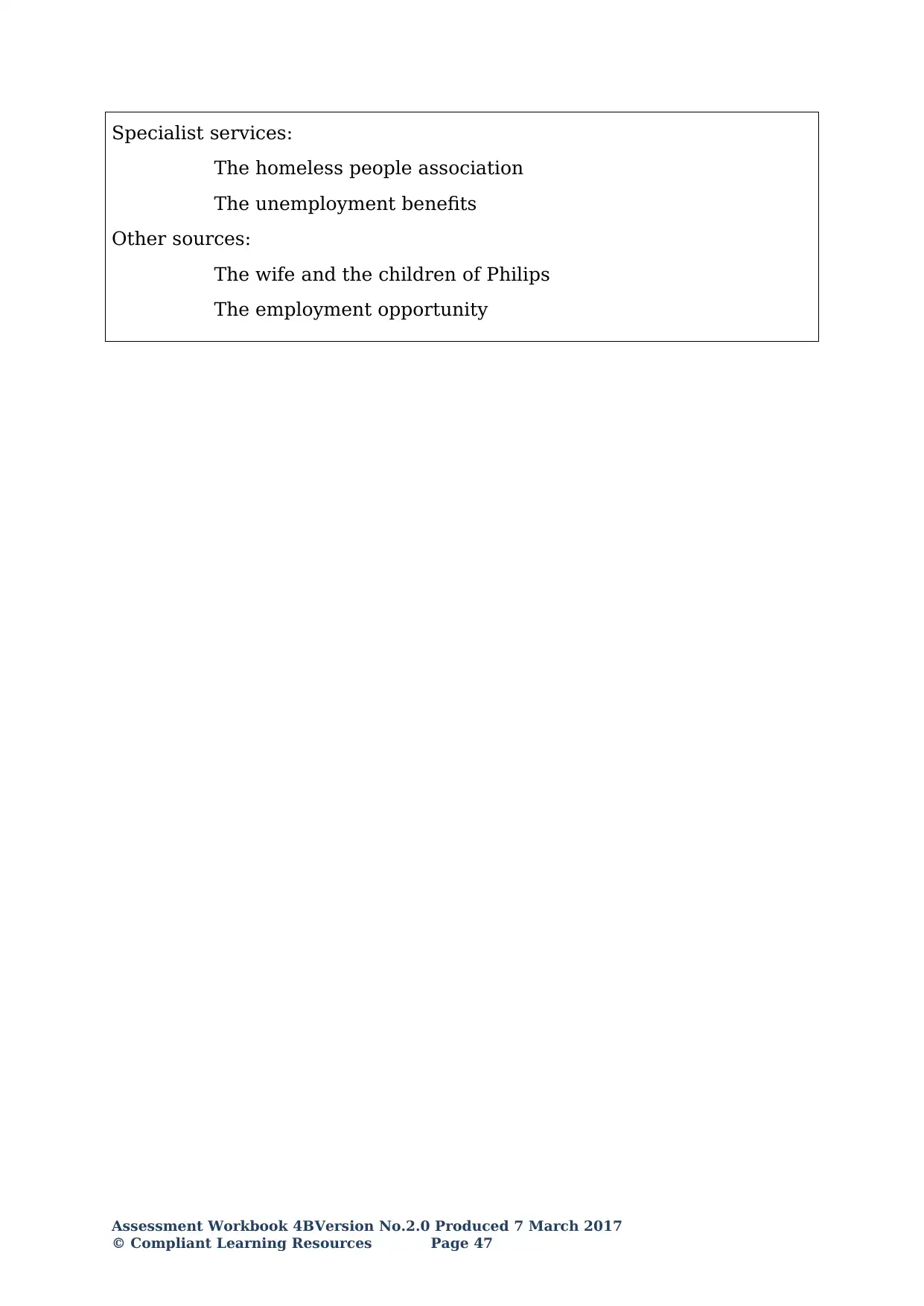
Specialist services:
The homeless people association
The unemployment benefits
Other sources:
The wife and the children of Philips
The employment opportunity
Assessment Workbook 4BVersion No.2.0 Produced 7 March 2017
© Compliant Learning Resources Page 47
The homeless people association
The unemployment benefits
Other sources:
The wife and the children of Philips
The employment opportunity
Assessment Workbook 4BVersion No.2.0 Produced 7 March 2017
© Compliant Learning Resources Page 47

Part 2: Planning
Task 1 – Develop an Appropriate Case Management Plan
This part of the assessment will require you to develop an appropriate
case management plan for Philip using the Case Management Plan
template below.
*Click on the icons above to open the template
Read the instructions carefully before proceeding.
Steps to take:
1. Before creating the case management plan, reflect on the outcomes
of the intake and assessment interview to be able to identify and
analyse the multiple and complex needs that you need to consider
in developing the case management plan.
2. Evaluate the needs of the client based on the information gathered
during intake and assessment. Prioritise the client’s needs based
on his responses in Task 3.
3. Once the needs are identified, research and compile information on
the availability and capacity of other services that can support the
client. Keep in mind that a specialist’s input is of particular
importance to support multiple and complex needs.
4. Develop the case management plan using the template provided:
4.1 List all known persons currently contributing to the
client’s care. This includes the individual, carer/advocate, key
worker/case manager/coordinator, specialists (e.g., GP,
health/community providers, substitute decision maker,
family members, volunteers or friends who provide
assistance). The following must also be in the case
management plan:
Full name of the participants involved in care
His/her role or kind of support he/she is giving the client
Assessment Workbook 4BVersion No.2.0 Produced 7 March 2017
Page 48 © Compliant Learning Resources
Task 1 – Develop an Appropriate Case Management Plan
This part of the assessment will require you to develop an appropriate
case management plan for Philip using the Case Management Plan
template below.
*Click on the icons above to open the template
Read the instructions carefully before proceeding.
Steps to take:
1. Before creating the case management plan, reflect on the outcomes
of the intake and assessment interview to be able to identify and
analyse the multiple and complex needs that you need to consider
in developing the case management plan.
2. Evaluate the needs of the client based on the information gathered
during intake and assessment. Prioritise the client’s needs based
on his responses in Task 3.
3. Once the needs are identified, research and compile information on
the availability and capacity of other services that can support the
client. Keep in mind that a specialist’s input is of particular
importance to support multiple and complex needs.
4. Develop the case management plan using the template provided:
4.1 List all known persons currently contributing to the
client’s care. This includes the individual, carer/advocate, key
worker/case manager/coordinator, specialists (e.g., GP,
health/community providers, substitute decision maker,
family members, volunteers or friends who provide
assistance). The following must also be in the case
management plan:
Full name of the participants involved in care
His/her role or kind of support he/she is giving the client
Assessment Workbook 4BVersion No.2.0 Produced 7 March 2017
Page 48 © Compliant Learning Resources
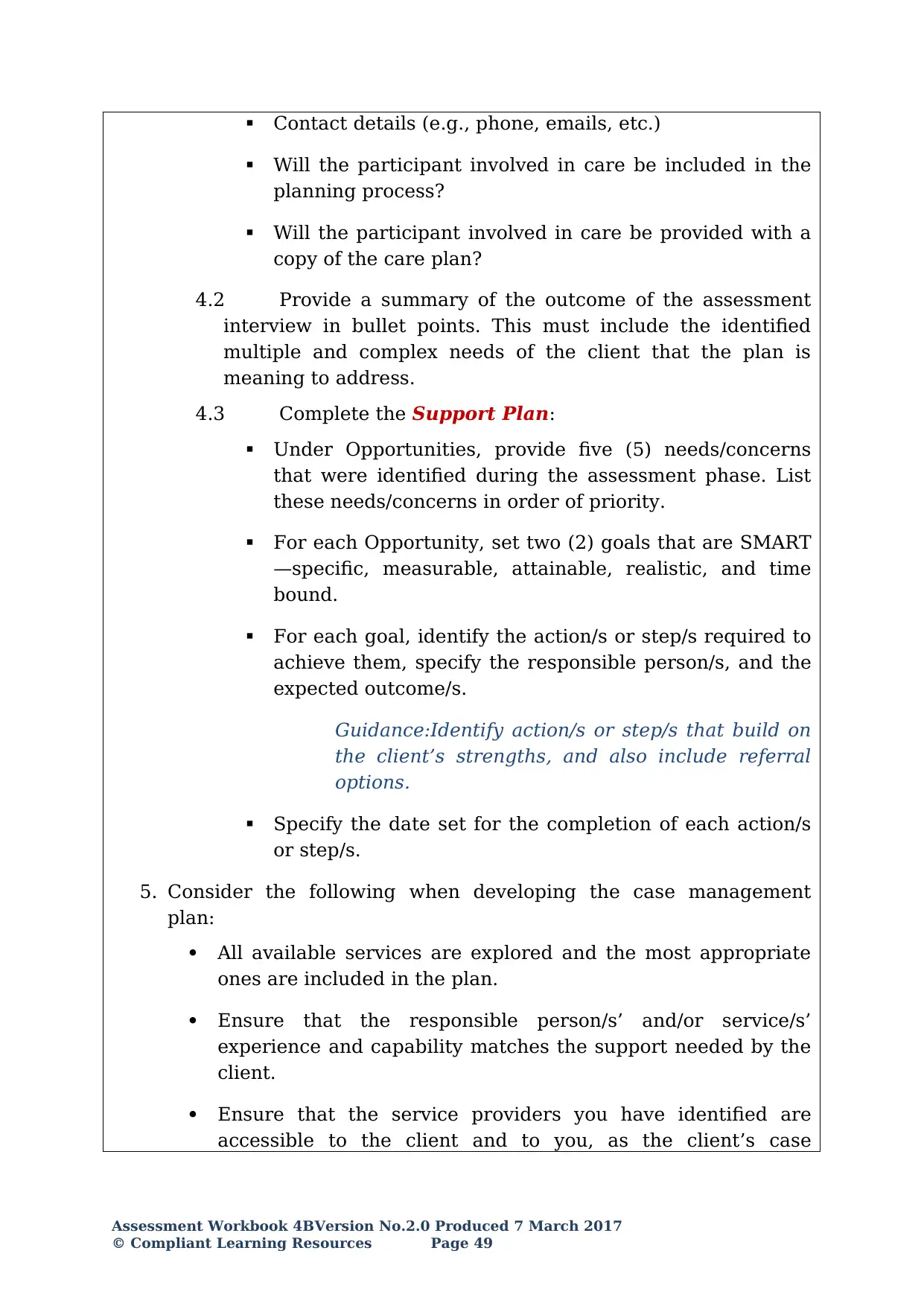
Contact details (e.g., phone, emails, etc.)
Will the participant involved in care be included in the
planning process?
Will the participant involved in care be provided with a
copy of the care plan?
4.2 Provide a summary of the outcome of the assessment
interview in bullet points. This must include the identified
multiple and complex needs of the client that the plan is
meaning to address.
4.3 Complete the Support Plan:
Under Opportunities, provide five (5) needs/concerns
that were identified during the assessment phase. List
these needs/concerns in order of priority.
For each Opportunity, set two (2) goals that are SMART
—specific, measurable, attainable, realistic, and time
bound.
For each goal, identify the action/s or step/s required to
achieve them, specify the responsible person/s, and the
expected outcome/s.
Guidance:Identify action/s or step/s that build on
the client’s strengths, and also include referral
options.
Specify the date set for the completion of each action/s
or step/s.
5. Consider the following when developing the case management
plan:
All available services are explored and the most appropriate
ones are included in the plan.
Ensure that the responsible person/s’ and/or service/s’
experience and capability matches the support needed by the
client.
Ensure that the service providers you have identified are
accessible to the client and to you, as the client’s case
Assessment Workbook 4BVersion No.2.0 Produced 7 March 2017
© Compliant Learning Resources Page 49
Will the participant involved in care be included in the
planning process?
Will the participant involved in care be provided with a
copy of the care plan?
4.2 Provide a summary of the outcome of the assessment
interview in bullet points. This must include the identified
multiple and complex needs of the client that the plan is
meaning to address.
4.3 Complete the Support Plan:
Under Opportunities, provide five (5) needs/concerns
that were identified during the assessment phase. List
these needs/concerns in order of priority.
For each Opportunity, set two (2) goals that are SMART
—specific, measurable, attainable, realistic, and time
bound.
For each goal, identify the action/s or step/s required to
achieve them, specify the responsible person/s, and the
expected outcome/s.
Guidance:Identify action/s or step/s that build on
the client’s strengths, and also include referral
options.
Specify the date set for the completion of each action/s
or step/s.
5. Consider the following when developing the case management
plan:
All available services are explored and the most appropriate
ones are included in the plan.
Ensure that the responsible person/s’ and/or service/s’
experience and capability matches the support needed by the
client.
Ensure that the service providers you have identified are
accessible to the client and to you, as the client’s case
Assessment Workbook 4BVersion No.2.0 Produced 7 March 2017
© Compliant Learning Resources Page 49
Paraphrase This Document
Need a fresh take? Get an instant paraphrase of this document with our AI Paraphraser
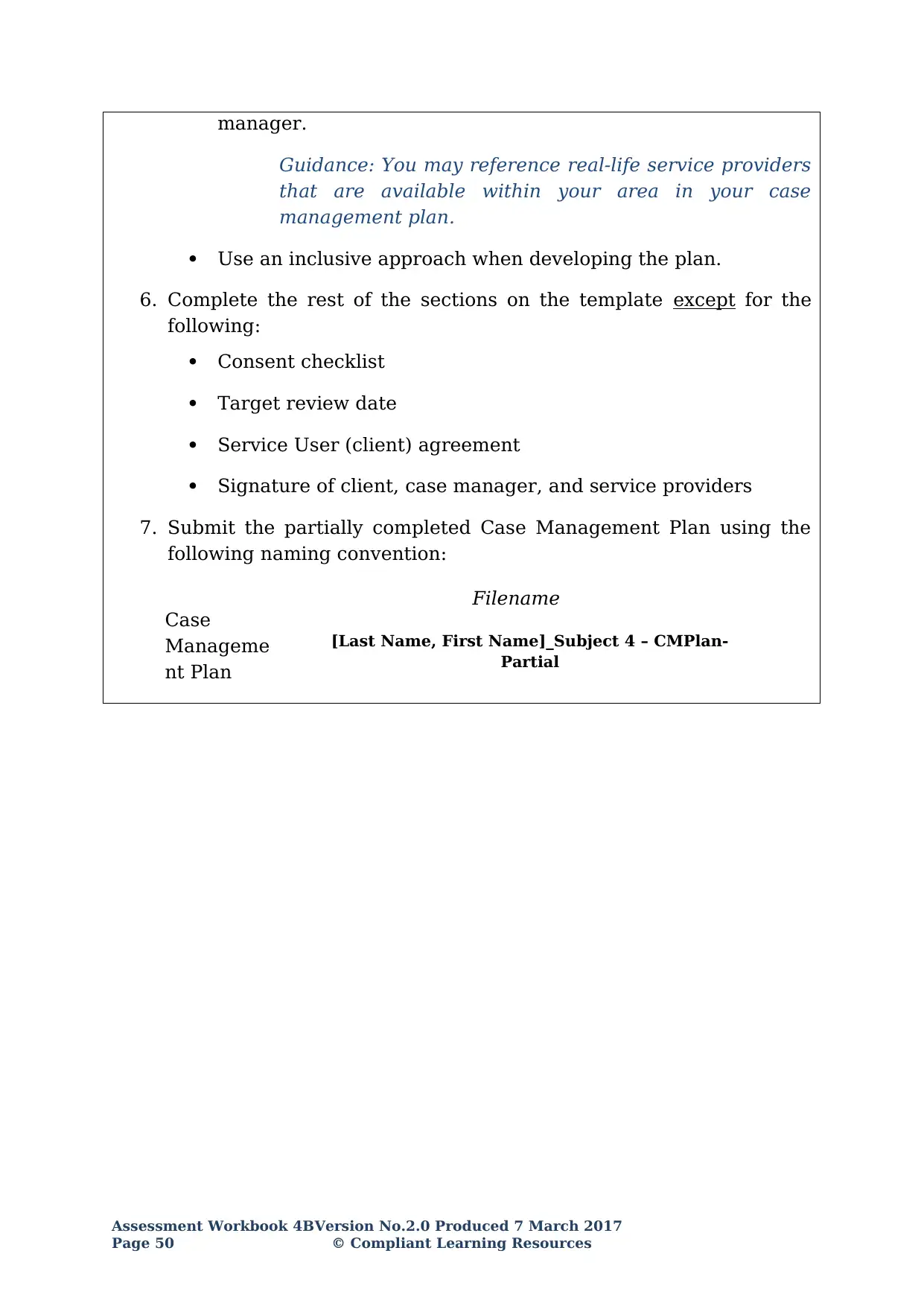
manager.
Guidance: You may reference real-life service providers
that are available within your area in your case
management plan.
Use an inclusive approach when developing the plan.
6. Complete the rest of the sections on the template except for the
following:
Consent checklist
Target review date
Service User (client) agreement
Signature of client, case manager, and service providers
7. Submit the partially completed Case Management Plan using the
following naming convention:
Filename
Case
Manageme
nt Plan
[Last Name, First Name]_Subject 4 – CMPlan-
Partial
Assessment Workbook 4BVersion No.2.0 Produced 7 March 2017
Page 50 © Compliant Learning Resources
Guidance: You may reference real-life service providers
that are available within your area in your case
management plan.
Use an inclusive approach when developing the plan.
6. Complete the rest of the sections on the template except for the
following:
Consent checklist
Target review date
Service User (client) agreement
Signature of client, case manager, and service providers
7. Submit the partially completed Case Management Plan using the
following naming convention:
Filename
Case
Manageme
nt Plan
[Last Name, First Name]_Subject 4 – CMPlan-
Partial
Assessment Workbook 4BVersion No.2.0 Produced 7 March 2017
Page 50 © Compliant Learning Resources

Task 2 – Collaborate with Client and Key Stakeholders
Before closing the assessment interview,
you informed Philip about the next steps—
that a case management plan will be
developed, and that a case conference and
meeting will be held. You explained to him
that in order for you to work with him better
and provide him with new opportunities, it is
best to work with other people who may be
able to provide him with additional and specialist support. You noticed
that he seemed wary about this new information.
You:Before I can start preparing for the case conference and meeting,
I need to make sure that it is okay with you that we will be speaking
with other people and service providers. May I know your thoughts on
this?
Philip: I am okay with the meeting. You said that we will be speaking
with other people that I might need to have contact with. Will you also
be inviting my wife?
You:Ideally, we should invite everyone who may be able to help and
assist you. Do you want me to arrange for your wife’s attendance in the
meeting?
Philip:Can we not invite her for now? Can we invite her when I’m all
sober and fixed?
You: Yes, we certainly could do that. I’ll take note of that. Is there
anything else you want to ask or tell me?
Philip: What are we supposed to talk about in the meeting?
You:In a case conference, we might talk about anything, including
those things that might be stopping you from doing what you need to
do, like transport or looking for work, or troubles with family.
Philip:Should I attend the meeting?
You:Yes. I recommend for you to be there.
Philip: Okay. If ideas will be shared, what about my privacy and how
will you keep things confidential?
You:Before we start the meeting, everyone in attendance will have to
agree to maintain confidentiality and not disclose any information
Assessment Workbook 4BVersion No.2.0 Produced 7 March 2017
© Compliant Learning Resources Page 51
Before closing the assessment interview,
you informed Philip about the next steps—
that a case management plan will be
developed, and that a case conference and
meeting will be held. You explained to him
that in order for you to work with him better
and provide him with new opportunities, it is
best to work with other people who may be
able to provide him with additional and specialist support. You noticed
that he seemed wary about this new information.
You:Before I can start preparing for the case conference and meeting,
I need to make sure that it is okay with you that we will be speaking
with other people and service providers. May I know your thoughts on
this?
Philip: I am okay with the meeting. You said that we will be speaking
with other people that I might need to have contact with. Will you also
be inviting my wife?
You:Ideally, we should invite everyone who may be able to help and
assist you. Do you want me to arrange for your wife’s attendance in the
meeting?
Philip:Can we not invite her for now? Can we invite her when I’m all
sober and fixed?
You: Yes, we certainly could do that. I’ll take note of that. Is there
anything else you want to ask or tell me?
Philip: What are we supposed to talk about in the meeting?
You:In a case conference, we might talk about anything, including
those things that might be stopping you from doing what you need to
do, like transport or looking for work, or troubles with family.
Philip:Should I attend the meeting?
You:Yes. I recommend for you to be there.
Philip: Okay. If ideas will be shared, what about my privacy and how
will you keep things confidential?
You:Before we start the meeting, everyone in attendance will have to
agree to maintain confidentiality and not disclose any information
Assessment Workbook 4BVersion No.2.0 Produced 7 March 2017
© Compliant Learning Resources Page 51
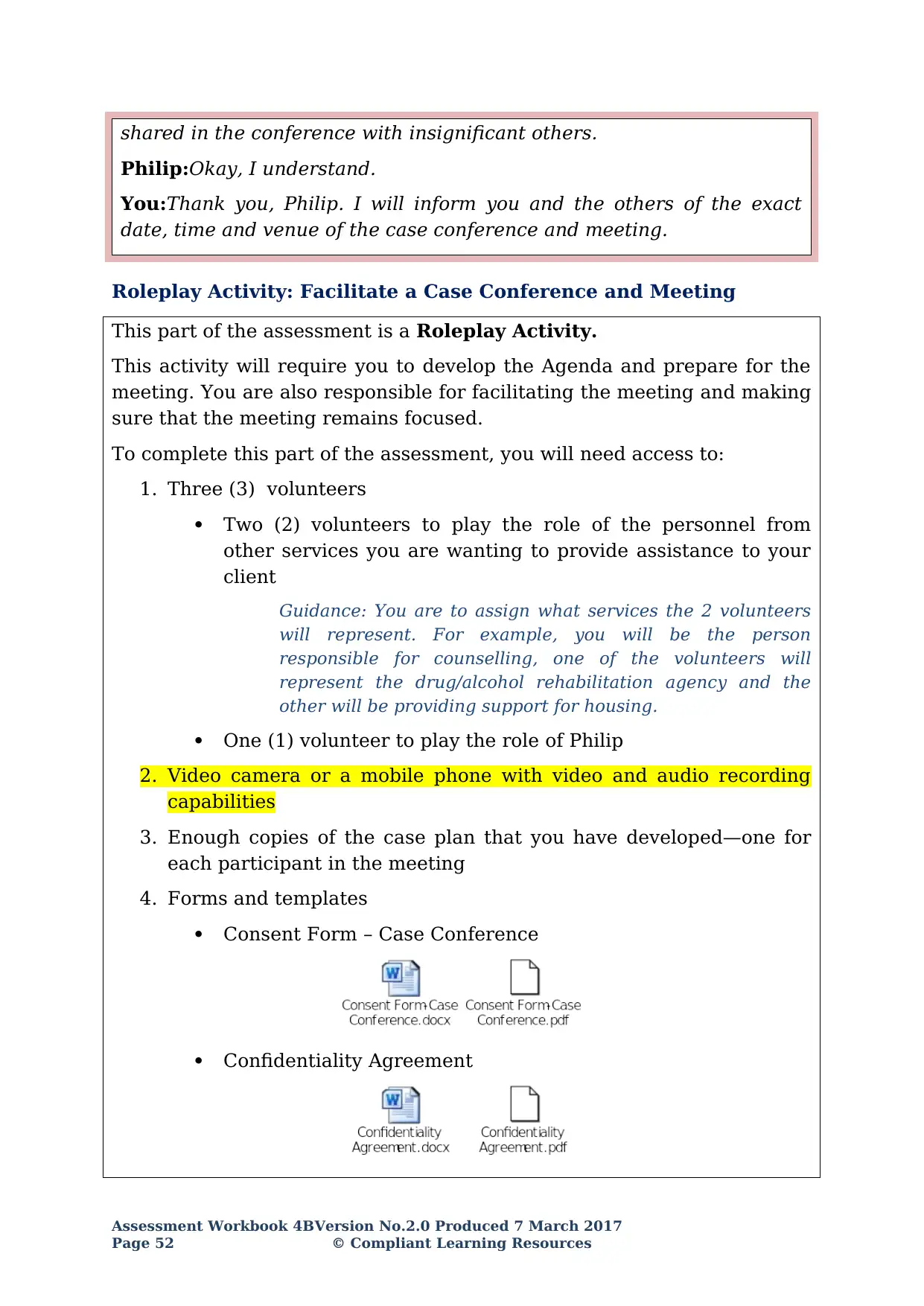
shared in the conference with insignificant others.
Philip:Okay, I understand.
You:Thank you, Philip. I will inform you and the others of the exact
date, time and venue of the case conference and meeting.
Roleplay Activity: Facilitate a Case Conference and Meeting
This part of the assessment is a Roleplay Activity.
This activity will require you to develop the Agenda and prepare for the
meeting. You are also responsible for facilitating the meeting and making
sure that the meeting remains focused.
To complete this part of the assessment, you will need access to:
1. Three (3) volunteers
Two (2) volunteers to play the role of the personnel from
other services you are wanting to provide assistance to your
client
Guidance: You are to assign what services the 2 volunteers
will represent. For example, you will be the person
responsible for counselling, one of the volunteers will
represent the drug/alcohol rehabilitation agency and the
other will be providing support for housing.
One (1) volunteer to play the role of Philip
2. Video camera or a mobile phone with video and audio recording
capabilities
3. Enough copies of the case plan that you have developed—one for
each participant in the meeting
4. Forms and templates
Consent Form – Case Conference
Confidentiality Agreement
Assessment Workbook 4BVersion No.2.0 Produced 7 March 2017
Page 52 © Compliant Learning Resources
Philip:Okay, I understand.
You:Thank you, Philip. I will inform you and the others of the exact
date, time and venue of the case conference and meeting.
Roleplay Activity: Facilitate a Case Conference and Meeting
This part of the assessment is a Roleplay Activity.
This activity will require you to develop the Agenda and prepare for the
meeting. You are also responsible for facilitating the meeting and making
sure that the meeting remains focused.
To complete this part of the assessment, you will need access to:
1. Three (3) volunteers
Two (2) volunteers to play the role of the personnel from
other services you are wanting to provide assistance to your
client
Guidance: You are to assign what services the 2 volunteers
will represent. For example, you will be the person
responsible for counselling, one of the volunteers will
represent the drug/alcohol rehabilitation agency and the
other will be providing support for housing.
One (1) volunteer to play the role of Philip
2. Video camera or a mobile phone with video and audio recording
capabilities
3. Enough copies of the case plan that you have developed—one for
each participant in the meeting
4. Forms and templates
Consent Form – Case Conference
Confidentiality Agreement
Assessment Workbook 4BVersion No.2.0 Produced 7 March 2017
Page 52 © Compliant Learning Resources
Secure Best Marks with AI Grader
Need help grading? Try our AI Grader for instant feedback on your assignments.
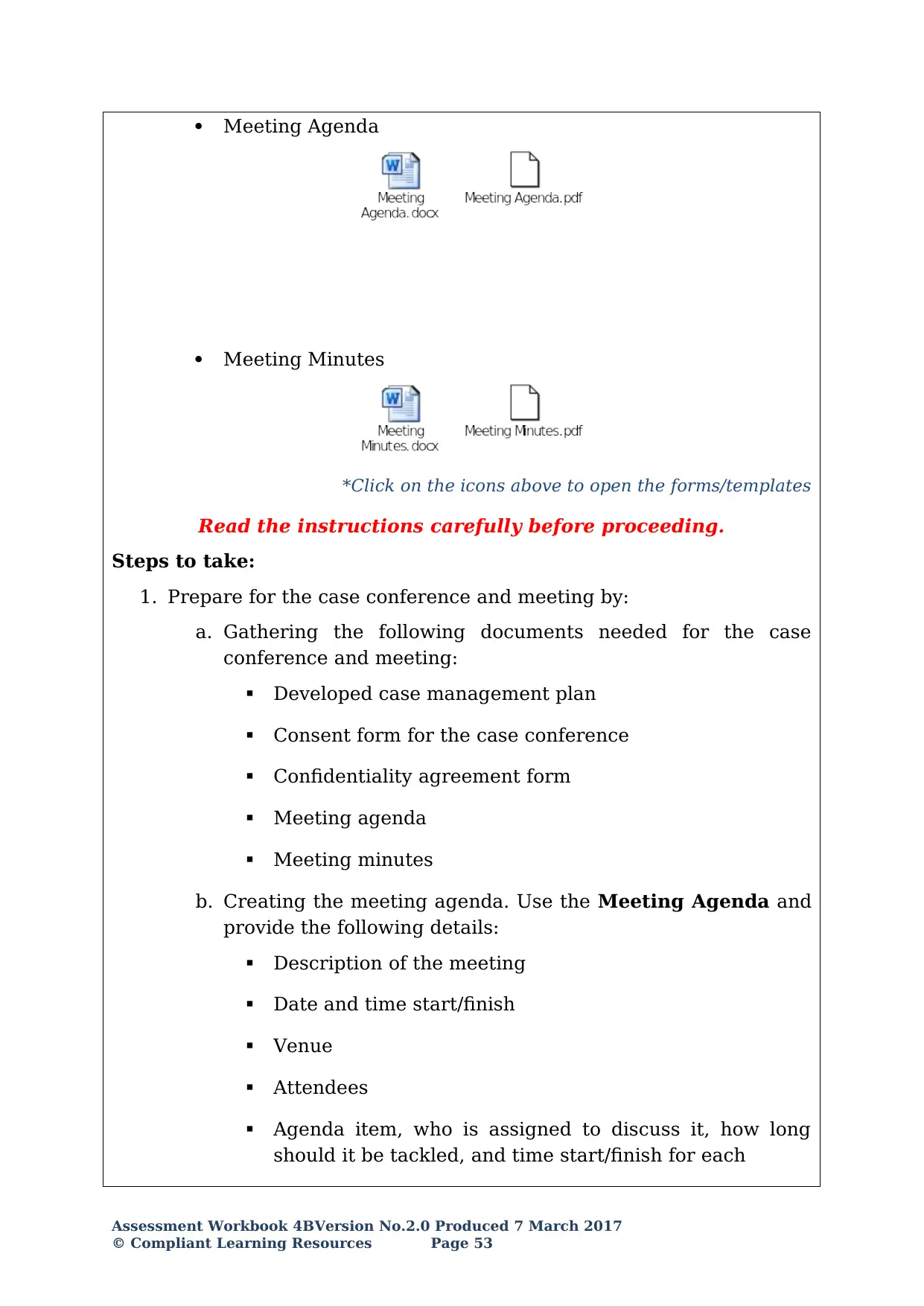
Meeting Agenda
Meeting Minutes
*Click on the icons above to open the forms/templates
Read the instructions carefully before proceeding.
Steps to take:
1. Prepare for the case conference and meeting by:
a. Gathering the following documents needed for the case
conference and meeting:
Developed case management plan
Consent form for the case conference
Confidentiality agreement form
Meeting agenda
Meeting minutes
b. Creating the meeting agenda. Use the Meeting Agenda and
provide the following details:
Description of the meeting
Date and time start/finish
Venue
Attendees
Agenda item, who is assigned to discuss it, how long
should it be tackled, and time start/finish for each
Assessment Workbook 4BVersion No.2.0 Produced 7 March 2017
© Compliant Learning Resources Page 53
Meeting Minutes
*Click on the icons above to open the forms/templates
Read the instructions carefully before proceeding.
Steps to take:
1. Prepare for the case conference and meeting by:
a. Gathering the following documents needed for the case
conference and meeting:
Developed case management plan
Consent form for the case conference
Confidentiality agreement form
Meeting agenda
Meeting minutes
b. Creating the meeting agenda. Use the Meeting Agenda and
provide the following details:
Description of the meeting
Date and time start/finish
Venue
Attendees
Agenda item, who is assigned to discuss it, how long
should it be tackled, and time start/finish for each
Assessment Workbook 4BVersion No.2.0 Produced 7 March 2017
© Compliant Learning Resources Page 53

c. Explaining what should transpire in the case conference and
meeting with all the volunteers.
2. Proceed with the case conference and meeting. During the first
part of the meeting, you must be able to:
a. Initiate a round of introductions and provide the
purpose/aims of the meeting.
b. Clarify the allotted time for the meeting, and state that you
will be facilitating and taking the minutes. Ensure all the
attendees that a copy of the minutes will be sent to all
relevant service providers involved in the case.
c. Obtain the client’s consent for the meeting by providing a
recap of the process, purpose, expected outcomes, level of
input required, and the likely tone and context of the
meeting.Ask the client to fill out the Consent Form
afterwards.
d. Present the Confidentiality Agreement to all in attendance.
Everyone must date and sign it, including you and the client.
e. Distribute the Agenda and the client’s Case Management
Plan (from Task 1).
3. Discuss the Agenda and outline the case history with the help of
the client. Prompt him/her to provide additional information as
necessary.
4. Facilitate the meeting proper. Restate that the main objective of
the meeting is to discuss how everyone in attendance will work
together, supply support to assist the client, and make an
agreement to monitor the client’s progress toward achieving the
set outcomes.
If the discussion focus shifts from the main objective of the
meeting, your role as facilitator is to remind the group of the
current task in hand and the required outcome.
5. Cover the following during the meeting:
Roles, responsibilities and boundaries of workers/ service
providers/ organisations are defined
Needs, rights and responsibilities of the client, client’s family
(if applicable), community, and service providers are
identified and agreed upon
Assessment Workbook 4BVersion No.2.0 Produced 7 March 2017
Page 54 © Compliant Learning Resources
meeting with all the volunteers.
2. Proceed with the case conference and meeting. During the first
part of the meeting, you must be able to:
a. Initiate a round of introductions and provide the
purpose/aims of the meeting.
b. Clarify the allotted time for the meeting, and state that you
will be facilitating and taking the minutes. Ensure all the
attendees that a copy of the minutes will be sent to all
relevant service providers involved in the case.
c. Obtain the client’s consent for the meeting by providing a
recap of the process, purpose, expected outcomes, level of
input required, and the likely tone and context of the
meeting.Ask the client to fill out the Consent Form
afterwards.
d. Present the Confidentiality Agreement to all in attendance.
Everyone must date and sign it, including you and the client.
e. Distribute the Agenda and the client’s Case Management
Plan (from Task 1).
3. Discuss the Agenda and outline the case history with the help of
the client. Prompt him/her to provide additional information as
necessary.
4. Facilitate the meeting proper. Restate that the main objective of
the meeting is to discuss how everyone in attendance will work
together, supply support to assist the client, and make an
agreement to monitor the client’s progress toward achieving the
set outcomes.
If the discussion focus shifts from the main objective of the
meeting, your role as facilitator is to remind the group of the
current task in hand and the required outcome.
5. Cover the following during the meeting:
Roles, responsibilities and boundaries of workers/ service
providers/ organisations are defined
Needs, rights and responsibilities of the client, client’s family
(if applicable), community, and service providers are
identified and agreed upon
Assessment Workbook 4BVersion No.2.0 Produced 7 March 2017
Page 54 © Compliant Learning Resources
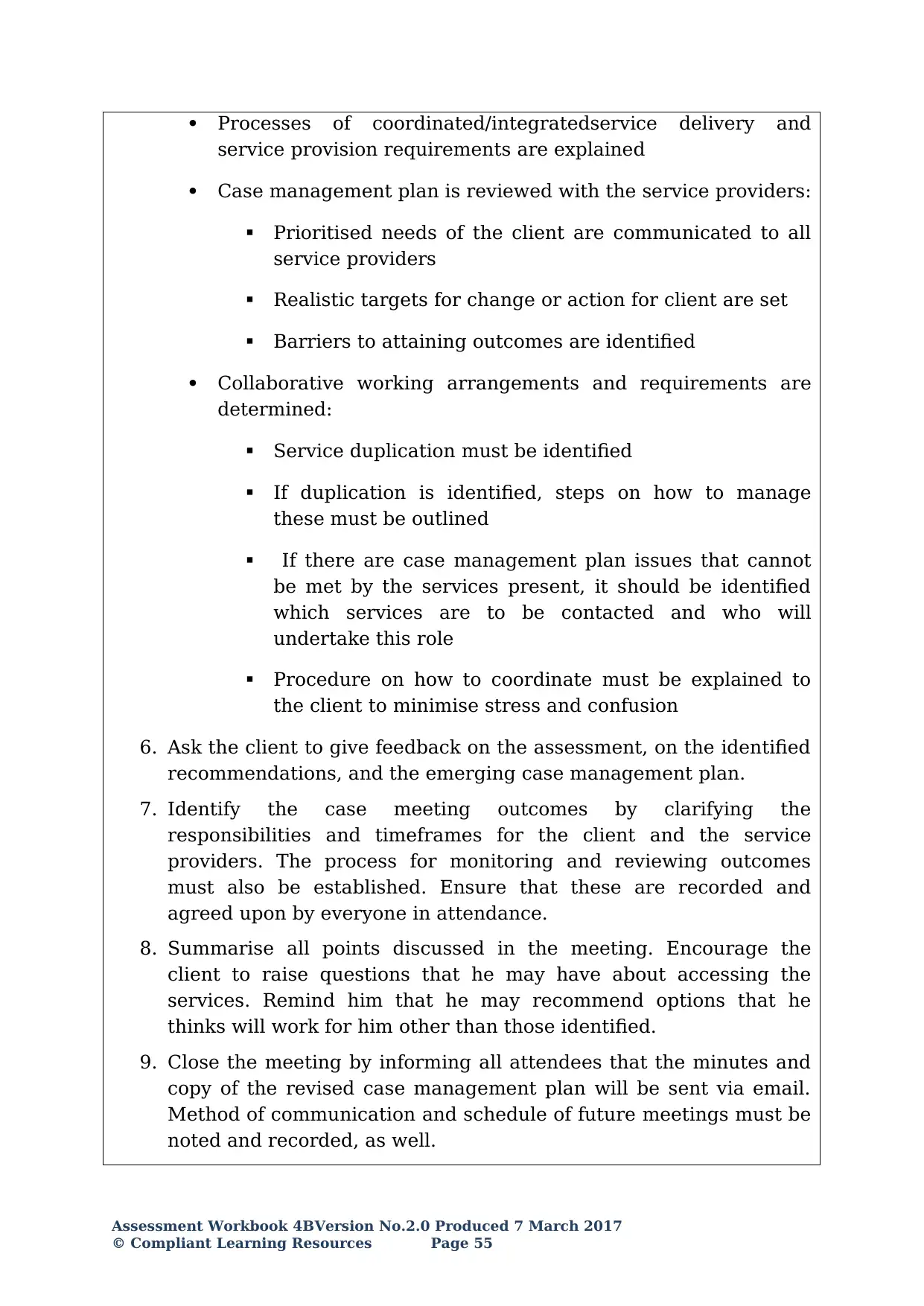
Processes of coordinated/integratedservice delivery and
service provision requirements are explained
Case management plan is reviewed with the service providers:
Prioritised needs of the client are communicated to all
service providers
Realistic targets for change or action for client are set
Barriers to attaining outcomes are identified
Collaborative working arrangements and requirements are
determined:
Service duplication must be identified
If duplication is identified, steps on how to manage
these must be outlined
If there are case management plan issues that cannot
be met by the services present, it should be identified
which services are to be contacted and who will
undertake this role
Procedure on how to coordinate must be explained to
the client to minimise stress and confusion
6. Ask the client to give feedback on the assessment, on the identified
recommendations, and the emerging case management plan.
7. Identify the case meeting outcomes by clarifying the
responsibilities and timeframes for the client and the service
providers. The process for monitoring and reviewing outcomes
must also be established. Ensure that these are recorded and
agreed upon by everyone in attendance.
8. Summarise all points discussed in the meeting. Encourage the
client to raise questions that he may have about accessing the
services. Remind him that he may recommend options that he
thinks will work for him other than those identified.
9. Close the meeting by informing all attendees that the minutes and
copy of the revised case management plan will be sent via email.
Method of communication and schedule of future meetings must be
noted and recorded, as well.
Assessment Workbook 4BVersion No.2.0 Produced 7 March 2017
© Compliant Learning Resources Page 55
service provision requirements are explained
Case management plan is reviewed with the service providers:
Prioritised needs of the client are communicated to all
service providers
Realistic targets for change or action for client are set
Barriers to attaining outcomes are identified
Collaborative working arrangements and requirements are
determined:
Service duplication must be identified
If duplication is identified, steps on how to manage
these must be outlined
If there are case management plan issues that cannot
be met by the services present, it should be identified
which services are to be contacted and who will
undertake this role
Procedure on how to coordinate must be explained to
the client to minimise stress and confusion
6. Ask the client to give feedback on the assessment, on the identified
recommendations, and the emerging case management plan.
7. Identify the case meeting outcomes by clarifying the
responsibilities and timeframes for the client and the service
providers. The process for monitoring and reviewing outcomes
must also be established. Ensure that these are recorded and
agreed upon by everyone in attendance.
8. Summarise all points discussed in the meeting. Encourage the
client to raise questions that he may have about accessing the
services. Remind him that he may recommend options that he
thinks will work for him other than those identified.
9. Close the meeting by informing all attendees that the minutes and
copy of the revised case management plan will be sent via email.
Method of communication and schedule of future meetings must be
noted and recorded, as well.
Assessment Workbook 4BVersion No.2.0 Produced 7 March 2017
© Compliant Learning Resources Page 55
Paraphrase This Document
Need a fresh take? Get an instant paraphrase of this document with our AI Paraphraser
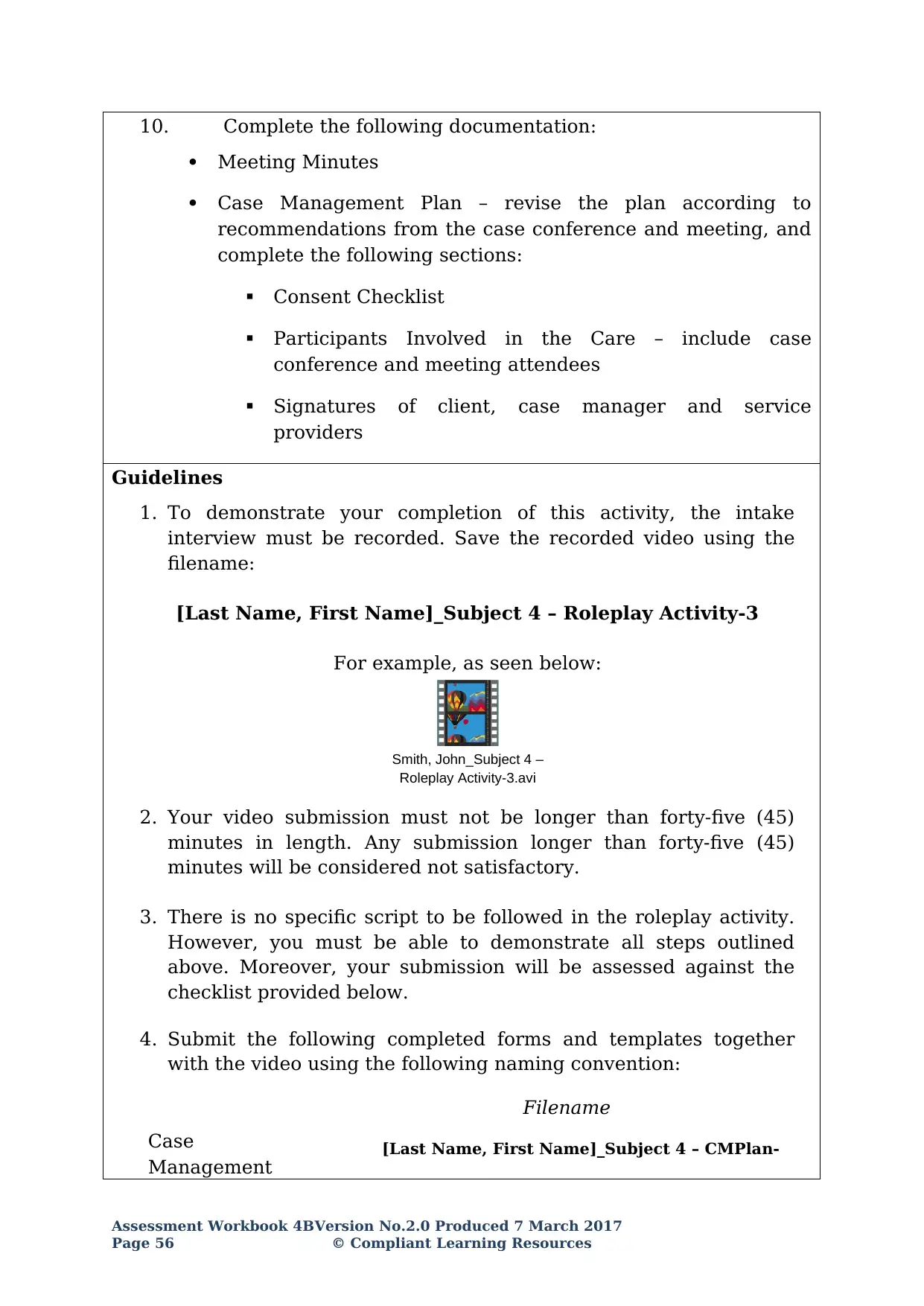
10. Complete the following documentation:
Meeting Minutes
Case Management Plan – revise the plan according to
recommendations from the case conference and meeting, and
complete the following sections:
Consent Checklist
Participants Involved in the Care – include case
conference and meeting attendees
Signatures of client, case manager and service
providers
Guidelines
1. To demonstrate your completion of this activity, the intake
interview must be recorded. Save the recorded video using the
filename:
[Last Name, First Name]_Subject 4 – Roleplay Activity-3
For example, as seen below:
Smith, John_Subject 4 –
Roleplay Activity-3.avi
2. Your video submission must not be longer than forty-five (45)
minutes in length. Any submission longer than forty-five (45)
minutes will be considered not satisfactory.
3. There is no specific script to be followed in the roleplay activity.
However, you must be able to demonstrate all steps outlined
above. Moreover, your submission will be assessed against the
checklist provided below.
4. Submit the following completed forms and templates together
with the video using the following naming convention:
Filename
Case
Management
[Last Name, First Name]_Subject 4 – CMPlan-
Assessment Workbook 4BVersion No.2.0 Produced 7 March 2017
Page 56 © Compliant Learning Resources
Meeting Minutes
Case Management Plan – revise the plan according to
recommendations from the case conference and meeting, and
complete the following sections:
Consent Checklist
Participants Involved in the Care – include case
conference and meeting attendees
Signatures of client, case manager and service
providers
Guidelines
1. To demonstrate your completion of this activity, the intake
interview must be recorded. Save the recorded video using the
filename:
[Last Name, First Name]_Subject 4 – Roleplay Activity-3
For example, as seen below:
Smith, John_Subject 4 –
Roleplay Activity-3.avi
2. Your video submission must not be longer than forty-five (45)
minutes in length. Any submission longer than forty-five (45)
minutes will be considered not satisfactory.
3. There is no specific script to be followed in the roleplay activity.
However, you must be able to demonstrate all steps outlined
above. Moreover, your submission will be assessed against the
checklist provided below.
4. Submit the following completed forms and templates together
with the video using the following naming convention:
Filename
Case
Management
[Last Name, First Name]_Subject 4 – CMPlan-
Assessment Workbook 4BVersion No.2.0 Produced 7 March 2017
Page 56 © Compliant Learning Resources
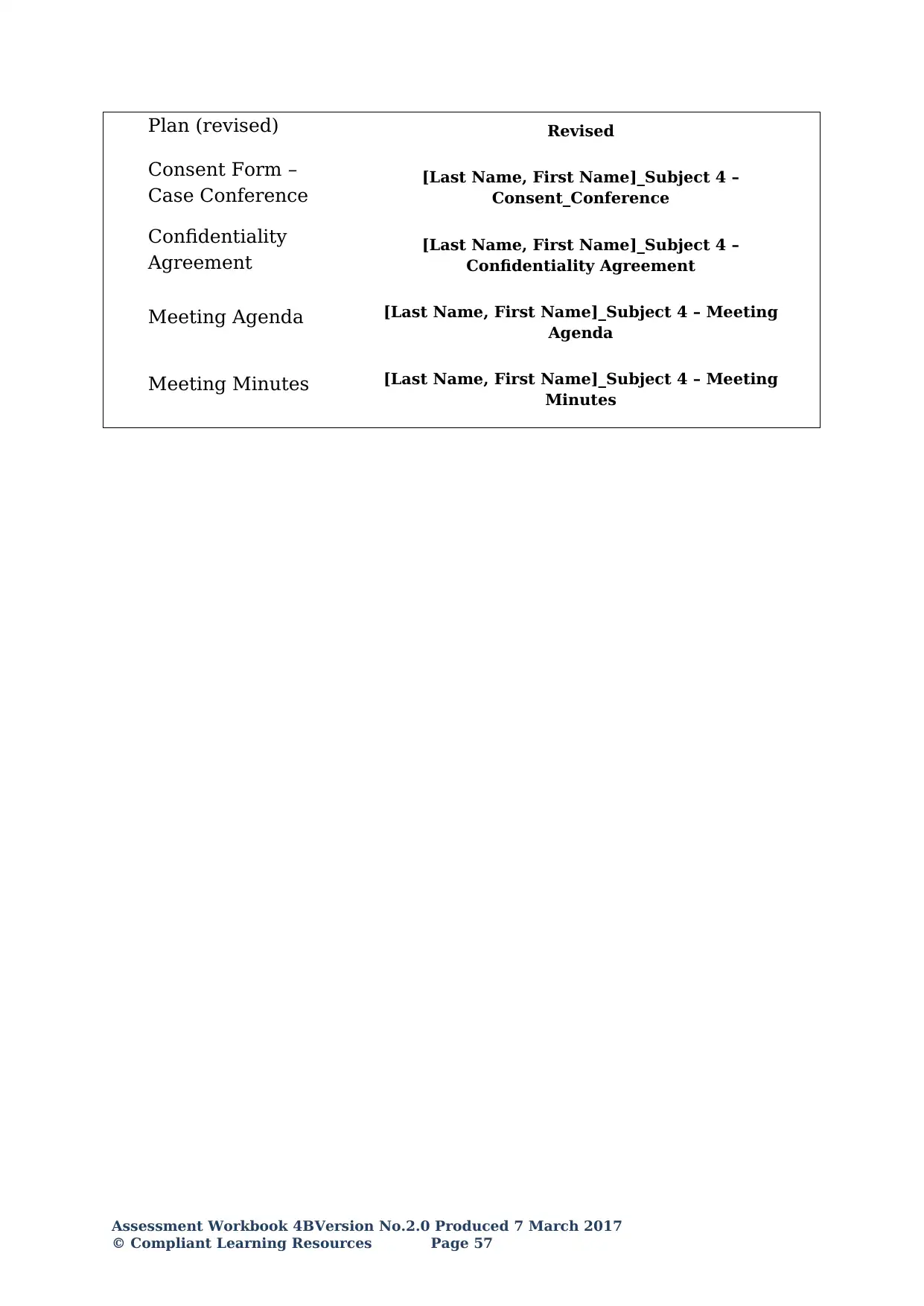
Plan (revised) Revised
Consent Form –
Case Conference
[Last Name, First Name]_Subject 4 –
Consent_Conference
Confidentiality
Agreement
[Last Name, First Name]_Subject 4 –
Confidentiality Agreement
Meeting Agenda [Last Name, First Name]_Subject 4 – Meeting
Agenda
Meeting Minutes [Last Name, First Name]_Subject 4 – Meeting
Minutes
Assessment Workbook 4BVersion No.2.0 Produced 7 March 2017
© Compliant Learning Resources Page 57
Consent Form –
Case Conference
[Last Name, First Name]_Subject 4 –
Consent_Conference
Confidentiality
Agreement
[Last Name, First Name]_Subject 4 –
Confidentiality Agreement
Meeting Agenda [Last Name, First Name]_Subject 4 – Meeting
Agenda
Meeting Minutes [Last Name, First Name]_Subject 4 – Meeting
Minutes
Assessment Workbook 4BVersion No.2.0 Produced 7 March 2017
© Compliant Learning Resources Page 57
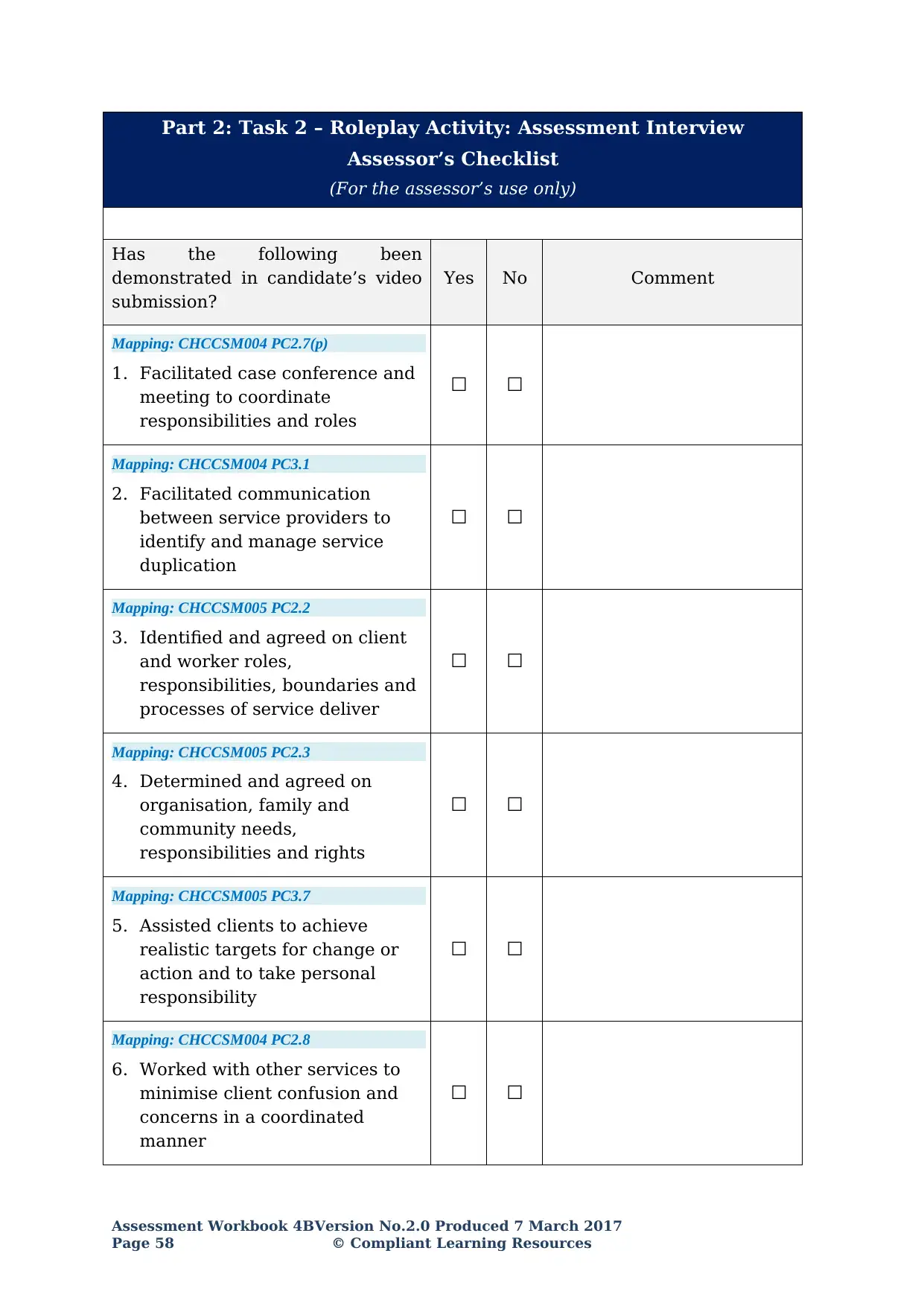
Part 2: Task 2 – Roleplay Activity: Assessment Interview
Assessor’s Checklist
(For the assessor’s use only)
Has the following been
demonstrated in candidate’s video
submission?
Yes No Comment
Mapping: CHCCSM004 PC2.7(p)
1. Facilitated case conference and
meeting to coordinate
responsibilities and roles
☐ ☐
Mapping: CHCCSM004 PC3.1
2. Facilitated communication
between service providers to
identify and manage service
duplication
☐ ☐
Mapping: CHCCSM005 PC2.2
3. Identified and agreed on client
and worker roles,
responsibilities, boundaries and
processes of service deliver
☐ ☐
Mapping: CHCCSM005 PC2.3
4. Determined and agreed on
organisation, family and
community needs,
responsibilities and rights
☐ ☐
Mapping: CHCCSM005 PC3.7
5. Assisted clients to achieve
realistic targets for change or
action and to take personal
responsibility
☐ ☐
Mapping: CHCCSM004 PC2.8
6. Worked with other services to
minimise client confusion and
concerns in a coordinated
manner
☐ ☐
Assessment Workbook 4BVersion No.2.0 Produced 7 March 2017
Page 58 © Compliant Learning Resources
Assessor’s Checklist
(For the assessor’s use only)
Has the following been
demonstrated in candidate’s video
submission?
Yes No Comment
Mapping: CHCCSM004 PC2.7(p)
1. Facilitated case conference and
meeting to coordinate
responsibilities and roles
☐ ☐
Mapping: CHCCSM004 PC3.1
2. Facilitated communication
between service providers to
identify and manage service
duplication
☐ ☐
Mapping: CHCCSM005 PC2.2
3. Identified and agreed on client
and worker roles,
responsibilities, boundaries and
processes of service deliver
☐ ☐
Mapping: CHCCSM005 PC2.3
4. Determined and agreed on
organisation, family and
community needs,
responsibilities and rights
☐ ☐
Mapping: CHCCSM005 PC3.7
5. Assisted clients to achieve
realistic targets for change or
action and to take personal
responsibility
☐ ☐
Mapping: CHCCSM004 PC2.8
6. Worked with other services to
minimise client confusion and
concerns in a coordinated
manner
☐ ☐
Assessment Workbook 4BVersion No.2.0 Produced 7 March 2017
Page 58 © Compliant Learning Resources
Secure Best Marks with AI Grader
Need help grading? Try our AI Grader for instant feedback on your assignments.

Mapping: CHCCSM004 PC2.6
7. Worked with the client to
prioritise needs and
communicate these with service
providers
☐ ☐
Mapping: CHCCSM004 PC2.5
8. Worked with the client and
other services to identify
barriers to attaining outcomes
☐ ☐
Mapping: CHCCCS004 PC2.1
9. Worked within scope of own
role and seek assistance from
colleagues and experts as
required
☐ ☐
Mapping: CHCCCS004 PC5.1, CHCCSM004
PC3.3
10.Sought feedback about
assessment processes from the
person and other networks
☐ ☐
Mapping: CHCCSM004 PC1.1
11.Worked with the client and
other services to determine the
service provision requirements
☐ ☐
Mapping: CHCCSM004 PC1.2
12.Negotiated collaborative
working arrangements for all
services involved
☐ ☐
Mapping: CHCCSM004 PC1.4
13.Worked with the services to
agree coordination
requirements and boundaries
☐ ☐
Mapping: CHCCCS004 PC3.3
14.Provided the person with
service information and support
their decision making process
☐ ☐
Assessment Workbook 4BVersion No.2.0 Produced 7 March 2017
© Compliant Learning Resources Page 59
7. Worked with the client to
prioritise needs and
communicate these with service
providers
☐ ☐
Mapping: CHCCSM004 PC2.5
8. Worked with the client and
other services to identify
barriers to attaining outcomes
☐ ☐
Mapping: CHCCCS004 PC2.1
9. Worked within scope of own
role and seek assistance from
colleagues and experts as
required
☐ ☐
Mapping: CHCCCS004 PC5.1, CHCCSM004
PC3.3
10.Sought feedback about
assessment processes from the
person and other networks
☐ ☐
Mapping: CHCCSM004 PC1.1
11.Worked with the client and
other services to determine the
service provision requirements
☐ ☐
Mapping: CHCCSM004 PC1.2
12.Negotiated collaborative
working arrangements for all
services involved
☐ ☐
Mapping: CHCCSM004 PC1.4
13.Worked with the services to
agree coordination
requirements and boundaries
☐ ☐
Mapping: CHCCCS004 PC3.3
14.Provided the person with
service information and support
their decision making process
☐ ☐
Assessment Workbook 4BVersion No.2.0 Produced 7 March 2017
© Compliant Learning Resources Page 59
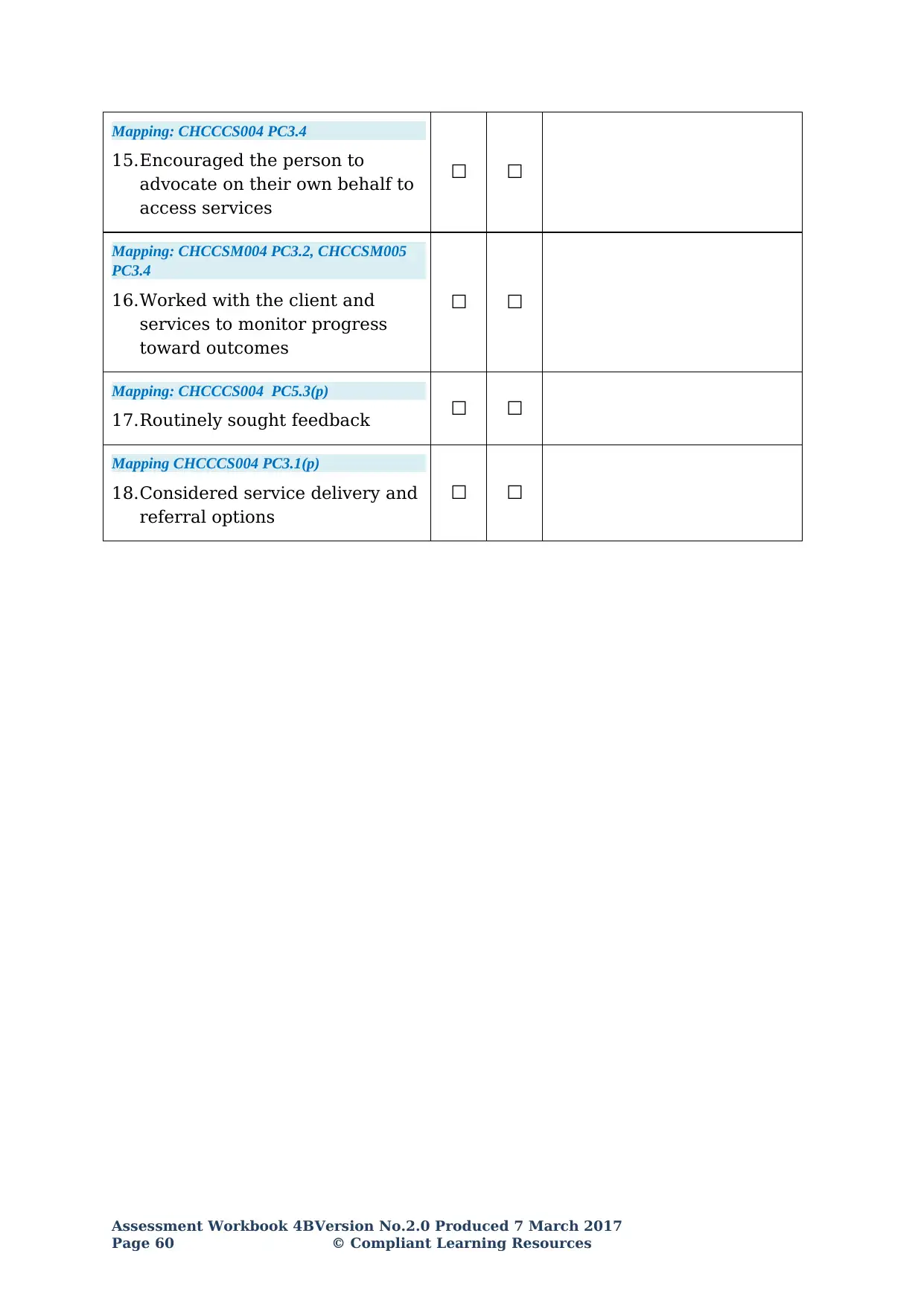
Mapping: CHCCCS004 PC3.4
15.Encouraged the person to
advocate on their own behalf to
access services
☐ ☐
Mapping: CHCCSM004 PC3.2, CHCCSM005
PC3.4
16.Worked with the client and
services to monitor progress
toward outcomes
☐ ☐
Mapping: CHCCCS004 PC5.3(p)
17.Routinely sought feedback ☐ ☐
Mapping CHCCCS004 PC3.1(p)
18.Considered service delivery and
referral options
☐ ☐
Assessment Workbook 4BVersion No.2.0 Produced 7 March 2017
Page 60 © Compliant Learning Resources
15.Encouraged the person to
advocate on their own behalf to
access services
☐ ☐
Mapping: CHCCSM004 PC3.2, CHCCSM005
PC3.4
16.Worked with the client and
services to monitor progress
toward outcomes
☐ ☐
Mapping: CHCCCS004 PC5.3(p)
17.Routinely sought feedback ☐ ☐
Mapping CHCCCS004 PC3.1(p)
18.Considered service delivery and
referral options
☐ ☐
Assessment Workbook 4BVersion No.2.0 Produced 7 March 2017
Page 60 © Compliant Learning Resources

Part 3: Monitoring and Review
A week after the case conference and meeting, you scheduled to meet up
with Philip to review his progress. Prior to the meeting, you rang the
drug/alcohol rehabilitation centre to check how Philip’s doing. The
coordinator informed you that Philip showed up for the scheduled
assessment and was able to talk to one of the centre’s counsellors. Philip
informed the counsellor that he read about Ozcare, also a recovery
centre, in a newspaper and is interested to transfer to their program.
On the day of the meeting, you observed that Philip is now cleanly
shaven and is wearing a clean set of clothes.
You:Hi, Philip. Thank you for coming in today.
Philip:No worries. What are we going to talk about today?
You:We are going to review your case plan and progress. Before we
start, I’d like to know how you’re doing and how’s it been since last
week.
Philip:I think I’m much better now. The emergency accommodation
provides showers and hot meals. They also gave me new clothes.
You: That’s wonderful. How do you feel about that?
Philip:The place is great and the people are really helpful but the
rehab centre is quite far from the shelter. I still have to take a bus and I
am saving some money from my Centrelink payments.I actually have
some money in the bank now.
You:I see. I phoned the rehab centre and the coordinator said that you
were able to complete the assessment and interview with the
counsellor. How was the interview?
Philip:It was okay, the counsellor was nice. I told him about Ozcare. I
said I saw it in the newspaper the other day and it’s much closer and I
don’t have to take the bus. She said I can suggest it to you and see
what you think.
You:All good, Philip. I’ll look into Ozcare and see if you are eligible to
transfer to their program. You said earlier that you are saving up some
money from your Centrelink payment. Is that correct?
Philip:Ah, yes. I actually want to look for work but I really don’t know
where to start.
You:That’s okay, Philip. We can also help you with that. We can help
Assessment Workbook 4BVersion No.2.0 Produced 7 March 2017
© Compliant Learning Resources Page 61
A week after the case conference and meeting, you scheduled to meet up
with Philip to review his progress. Prior to the meeting, you rang the
drug/alcohol rehabilitation centre to check how Philip’s doing. The
coordinator informed you that Philip showed up for the scheduled
assessment and was able to talk to one of the centre’s counsellors. Philip
informed the counsellor that he read about Ozcare, also a recovery
centre, in a newspaper and is interested to transfer to their program.
On the day of the meeting, you observed that Philip is now cleanly
shaven and is wearing a clean set of clothes.
You:Hi, Philip. Thank you for coming in today.
Philip:No worries. What are we going to talk about today?
You:We are going to review your case plan and progress. Before we
start, I’d like to know how you’re doing and how’s it been since last
week.
Philip:I think I’m much better now. The emergency accommodation
provides showers and hot meals. They also gave me new clothes.
You: That’s wonderful. How do you feel about that?
Philip:The place is great and the people are really helpful but the
rehab centre is quite far from the shelter. I still have to take a bus and I
am saving some money from my Centrelink payments.I actually have
some money in the bank now.
You:I see. I phoned the rehab centre and the coordinator said that you
were able to complete the assessment and interview with the
counsellor. How was the interview?
Philip:It was okay, the counsellor was nice. I told him about Ozcare. I
said I saw it in the newspaper the other day and it’s much closer and I
don’t have to take the bus. She said I can suggest it to you and see
what you think.
You:All good, Philip. I’ll look into Ozcare and see if you are eligible to
transfer to their program. You said earlier that you are saving up some
money from your Centrelink payment. Is that correct?
Philip:Ah, yes. I actually want to look for work but I really don’t know
where to start.
You:That’s okay, Philip. We can also help you with that. We can help
Assessment Workbook 4BVersion No.2.0 Produced 7 March 2017
© Compliant Learning Resources Page 61
Paraphrase This Document
Need a fresh take? Get an instant paraphrase of this document with our AI Paraphraser
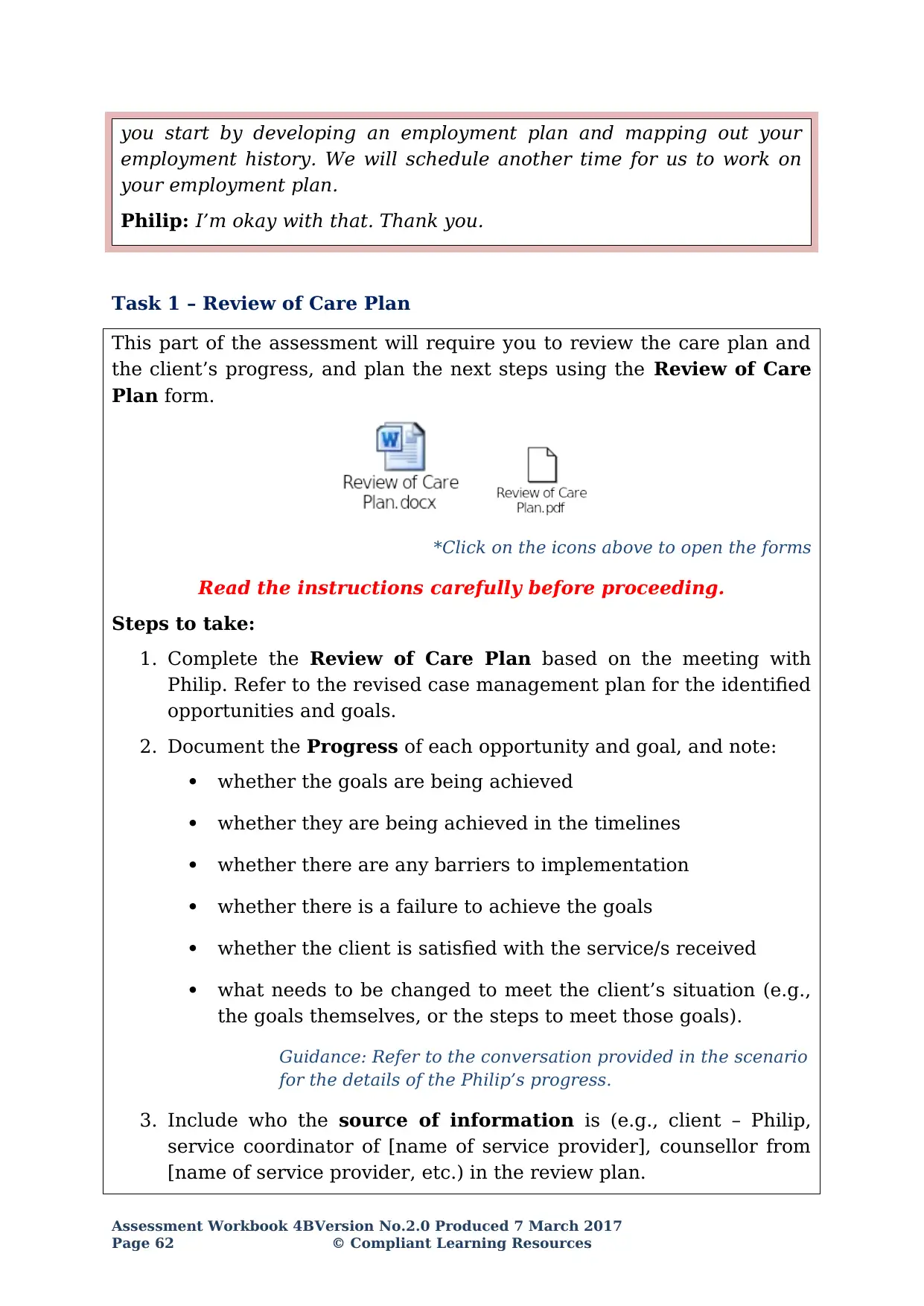
you start by developing an employment plan and mapping out your
employment history. We will schedule another time for us to work on
your employment plan.
Philip: I’m okay with that. Thank you.
Task 1 – Review of Care Plan
This part of the assessment will require you to review the care plan and
the client’s progress, and plan the next steps using the Review of Care
Plan form.
*Click on the icons above to open the forms
Read the instructions carefully before proceeding.
Steps to take:
1. Complete the Review of Care Plan based on the meeting with
Philip. Refer to the revised case management plan for the identified
opportunities and goals.
2. Document the Progress of each opportunity and goal, and note:
whether the goals are being achieved
whether they are being achieved in the timelines
whether there are any barriers to implementation
whether there is a failure to achieve the goals
whether the client is satisfied with the service/s received
what needs to be changed to meet the client’s situation (e.g.,
the goals themselves, or the steps to meet those goals).
Guidance: Refer to the conversation provided in the scenario
for the details of the Philip’s progress.
3. Include who the source of information is (e.g., client – Philip,
service coordinator of [name of service provider], counsellor from
[name of service provider, etc.) in the review plan.
Assessment Workbook 4BVersion No.2.0 Produced 7 March 2017
Page 62 © Compliant Learning Resources
employment history. We will schedule another time for us to work on
your employment plan.
Philip: I’m okay with that. Thank you.
Task 1 – Review of Care Plan
This part of the assessment will require you to review the care plan and
the client’s progress, and plan the next steps using the Review of Care
Plan form.
*Click on the icons above to open the forms
Read the instructions carefully before proceeding.
Steps to take:
1. Complete the Review of Care Plan based on the meeting with
Philip. Refer to the revised case management plan for the identified
opportunities and goals.
2. Document the Progress of each opportunity and goal, and note:
whether the goals are being achieved
whether they are being achieved in the timelines
whether there are any barriers to implementation
whether there is a failure to achieve the goals
whether the client is satisfied with the service/s received
what needs to be changed to meet the client’s situation (e.g.,
the goals themselves, or the steps to meet those goals).
Guidance: Refer to the conversation provided in the scenario
for the details of the Philip’s progress.
3. Include who the source of information is (e.g., client – Philip,
service coordinator of [name of service provider], counsellor from
[name of service provider, etc.) in the review plan.
Assessment Workbook 4BVersion No.2.0 Produced 7 March 2017
Page 62 © Compliant Learning Resources
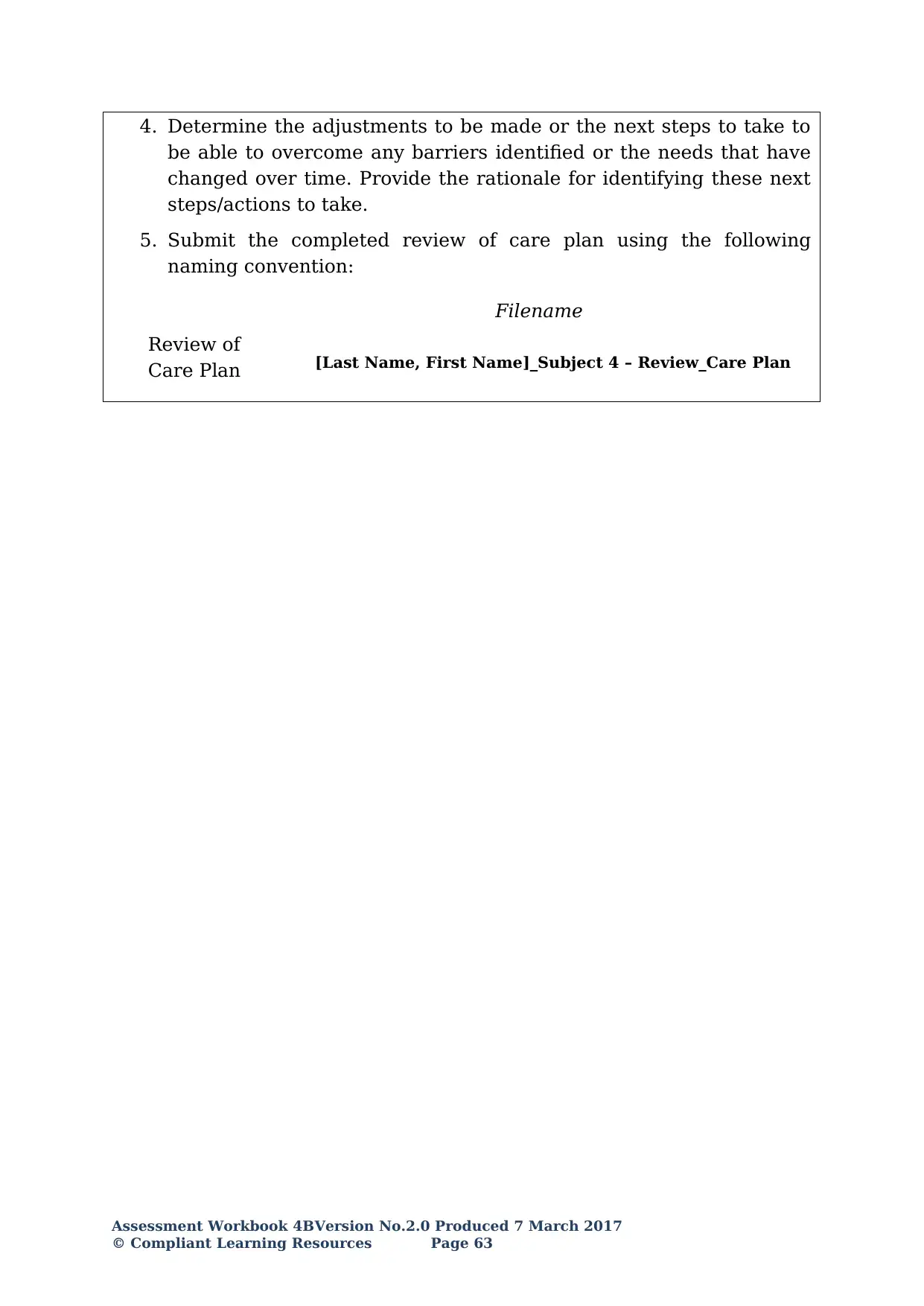
4. Determine the adjustments to be made or the next steps to take to
be able to overcome any barriers identified or the needs that have
changed over time. Provide the rationale for identifying these next
steps/actions to take.
5. Submit the completed review of care plan using the following
naming convention:
Filename
Review of
Care Plan [Last Name, First Name]_Subject 4 – Review_Care Plan
Assessment Workbook 4BVersion No.2.0 Produced 7 March 2017
© Compliant Learning Resources Page 63
be able to overcome any barriers identified or the needs that have
changed over time. Provide the rationale for identifying these next
steps/actions to take.
5. Submit the completed review of care plan using the following
naming convention:
Filename
Review of
Care Plan [Last Name, First Name]_Subject 4 – Review_Care Plan
Assessment Workbook 4BVersion No.2.0 Produced 7 March 2017
© Compliant Learning Resources Page 63
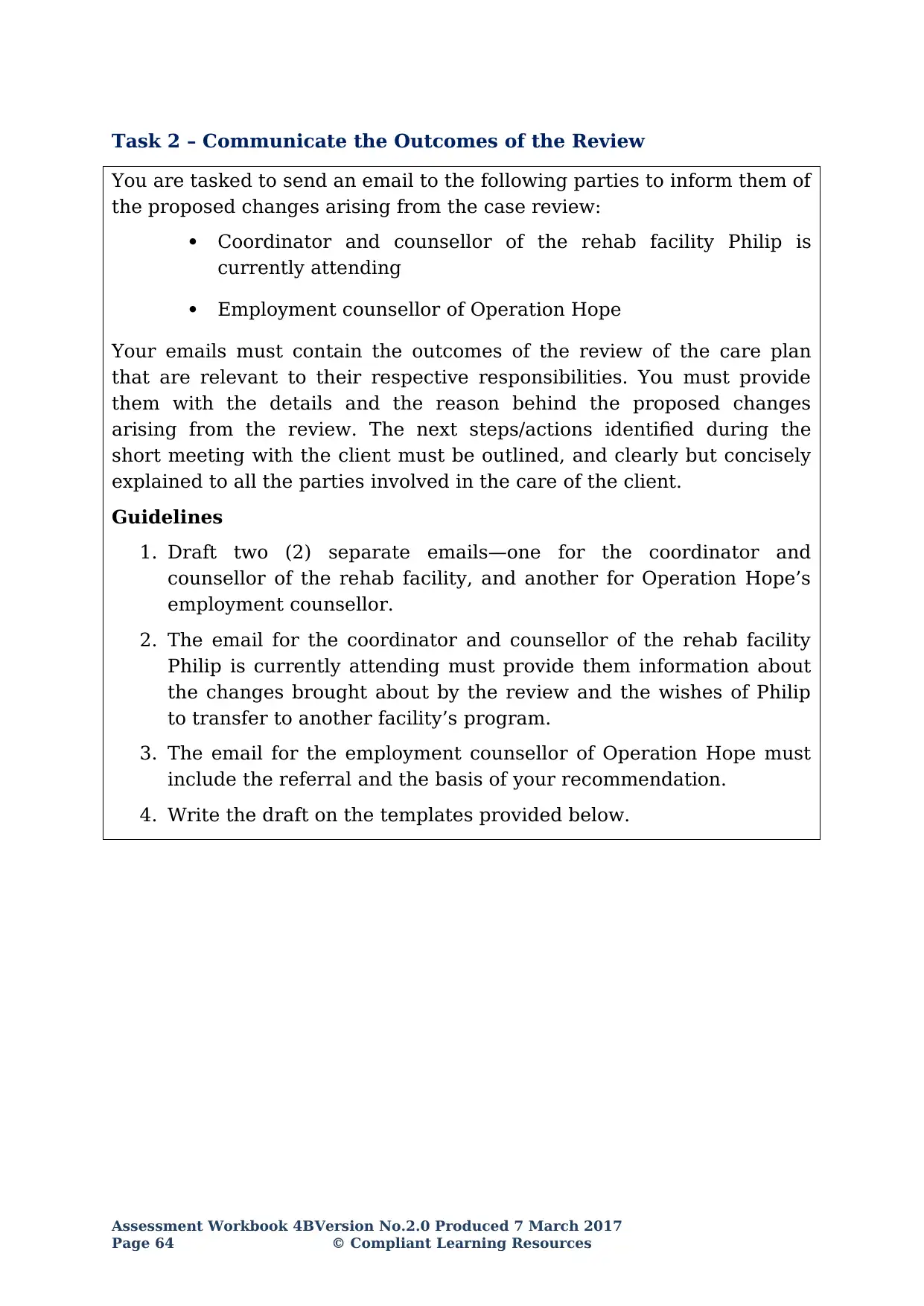
Task 2 – Communicate the Outcomes of the Review
You are tasked to send an email to the following parties to inform them of
the proposed changes arising from the case review:
Coordinator and counsellor of the rehab facility Philip is
currently attending
Employment counsellor of Operation Hope
Your emails must contain the outcomes of the review of the care plan
that are relevant to their respective responsibilities. You must provide
them with the details and the reason behind the proposed changes
arising from the review. The next steps/actions identified during the
short meeting with the client must be outlined, and clearly but concisely
explained to all the parties involved in the care of the client.
Guidelines
1. Draft two (2) separate emails—one for the coordinator and
counsellor of the rehab facility, and another for Operation Hope’s
employment counsellor.
2. The email for the coordinator and counsellor of the rehab facility
Philip is currently attending must provide them information about
the changes brought about by the review and the wishes of Philip
to transfer to another facility’s program.
3. The email for the employment counsellor of Operation Hope must
include the referral and the basis of your recommendation.
4. Write the draft on the templates provided below.
Assessment Workbook 4BVersion No.2.0 Produced 7 March 2017
Page 64 © Compliant Learning Resources
You are tasked to send an email to the following parties to inform them of
the proposed changes arising from the case review:
Coordinator and counsellor of the rehab facility Philip is
currently attending
Employment counsellor of Operation Hope
Your emails must contain the outcomes of the review of the care plan
that are relevant to their respective responsibilities. You must provide
them with the details and the reason behind the proposed changes
arising from the review. The next steps/actions identified during the
short meeting with the client must be outlined, and clearly but concisely
explained to all the parties involved in the care of the client.
Guidelines
1. Draft two (2) separate emails—one for the coordinator and
counsellor of the rehab facility, and another for Operation Hope’s
employment counsellor.
2. The email for the coordinator and counsellor of the rehab facility
Philip is currently attending must provide them information about
the changes brought about by the review and the wishes of Philip
to transfer to another facility’s program.
3. The email for the employment counsellor of Operation Hope must
include the referral and the basis of your recommendation.
4. Write the draft on the templates provided below.
Assessment Workbook 4BVersion No.2.0 Produced 7 March 2017
Page 64 © Compliant Learning Resources
Secure Best Marks with AI Grader
Need help grading? Try our AI Grader for instant feedback on your assignments.

To:
(include name/s
and email
address/es)
Coordinator and counsellor of the rehab
facility
Subject:
(write an
appropriate
subject)
Changes for the Philip case
Message:
Dear Sir,
It is to notify that the case of Philip will undergo some of the
minor changes as per the current interview and the
conference in the community organization of Operation
Hope. It is to notify that Philips will now be transferred to
another community services, ozcare one of the recovery
centre so that he can participate in their program. Please
ensure the changes there after. Furthermore it is to notify
that since he is unemployed, and getting payed from the
Centrelink payments, it is important for him to save money.
Thank you
Assessment Workbook 4BVersion No.2.0 Produced 7 March 2017
© Compliant Learning Resources Page 65
(include name/s
and email
address/es)
Coordinator and counsellor of the rehab
facility
Subject:
(write an
appropriate
subject)
Changes for the Philip case
Message:
Dear Sir,
It is to notify that the case of Philip will undergo some of the
minor changes as per the current interview and the
conference in the community organization of Operation
Hope. It is to notify that Philips will now be transferred to
another community services, ozcare one of the recovery
centre so that he can participate in their program. Please
ensure the changes there after. Furthermore it is to notify
that since he is unemployed, and getting payed from the
Centrelink payments, it is important for him to save money.
Thank you
Assessment Workbook 4BVersion No.2.0 Produced 7 March 2017
© Compliant Learning Resources Page 65
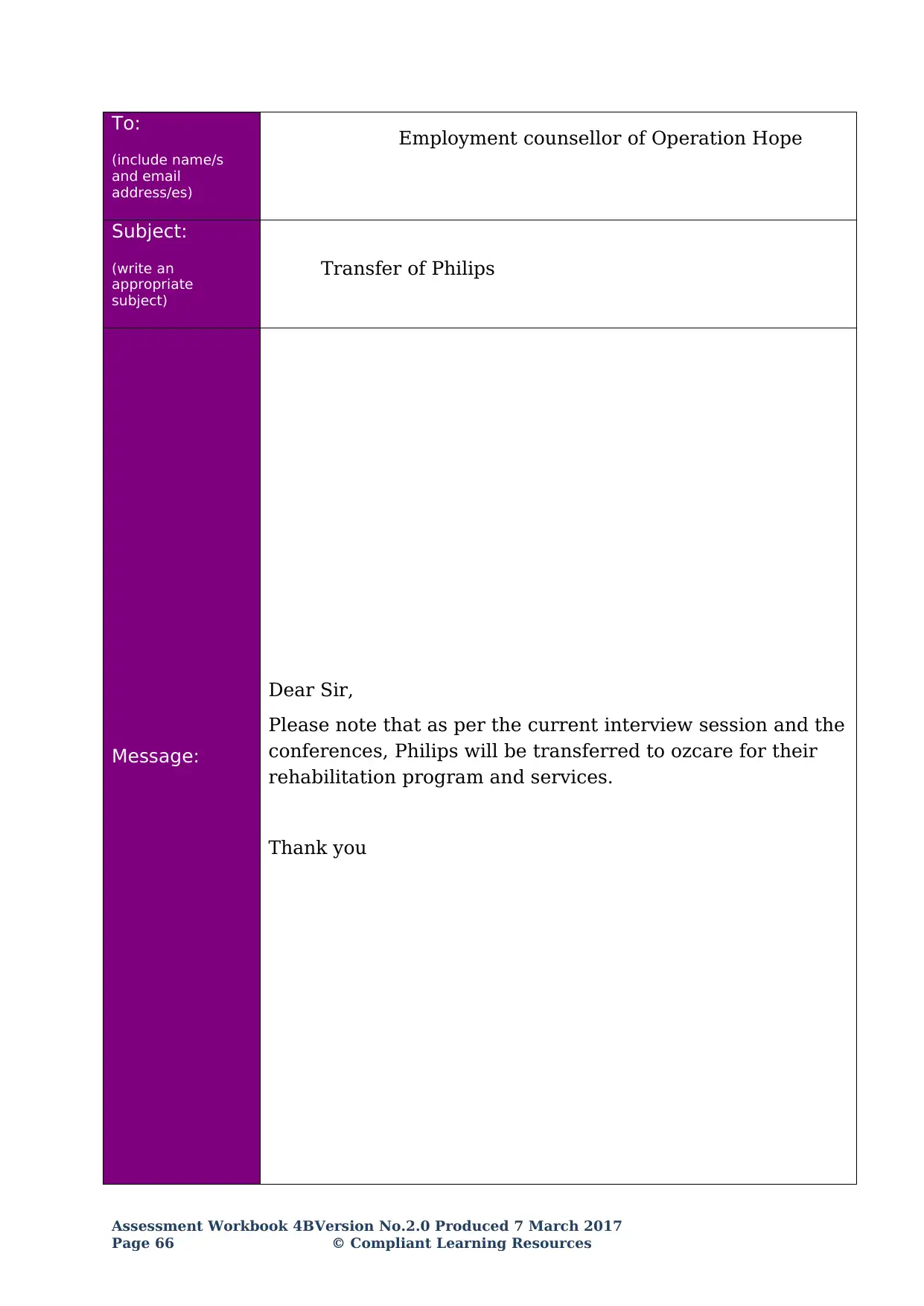
To:
(include name/s
and email
address/es)
Employment counsellor of Operation Hope
Subject:
(write an
appropriate
subject)
Transfer of Philips
Message:
Dear Sir,
Please note that as per the current interview session and the
conferences, Philips will be transferred to ozcare for their
rehabilitation program and services.
Thank you
Assessment Workbook 4BVersion No.2.0 Produced 7 March 2017
Page 66 © Compliant Learning Resources
(include name/s
and email
address/es)
Employment counsellor of Operation Hope
Subject:
(write an
appropriate
subject)
Transfer of Philips
Message:
Dear Sir,
Please note that as per the current interview session and the
conferences, Philips will be transferred to ozcare for their
rehabilitation program and services.
Thank you
Assessment Workbook 4BVersion No.2.0 Produced 7 March 2017
Page 66 © Compliant Learning Resources

Assessment Workbook 4BVersion No.2.0 Produced 7 March 2017
© Compliant Learning Resources Page 67
© Compliant Learning Resources Page 67
Paraphrase This Document
Need a fresh take? Get an instant paraphrase of this document with our AI Paraphraser

Part 4: Case Closure and Exit
Philip was able to transfer to Ozcare’s live-in detox program and after a
week, he dropped by your office to inform you that he will be exiting
Operation Hope’s program. He said that he needs more than a week to
fully recover from his alcohol dependency and that Ozcare offered a
structured program that will help him be free of alcohol. Philip told you
that he is very grateful for all the help and that he was satisfied with how
you assisted him and coordinated his care.
You started preparing for the case closure and Philip’s exit by reviewing
his case and the service’s exit policy and procedure.
(Click on the icon above to open Operation Hope’s policies and procedures)
Assessment Workbook 4BVersion No.2.0 Produced 7 March 2017
Page 68 © Compliant Learning Resources
Philip was able to transfer to Ozcare’s live-in detox program and after a
week, he dropped by your office to inform you that he will be exiting
Operation Hope’s program. He said that he needs more than a week to
fully recover from his alcohol dependency and that Ozcare offered a
structured program that will help him be free of alcohol. Philip told you
that he is very grateful for all the help and that he was satisfied with how
you assisted him and coordinated his care.
You started preparing for the case closure and Philip’s exit by reviewing
his case and the service’s exit policy and procedure.
(Click on the icon above to open Operation Hope’s policies and procedures)
Assessment Workbook 4BVersion No.2.0 Produced 7 March 2017
Page 68 © Compliant Learning Resources
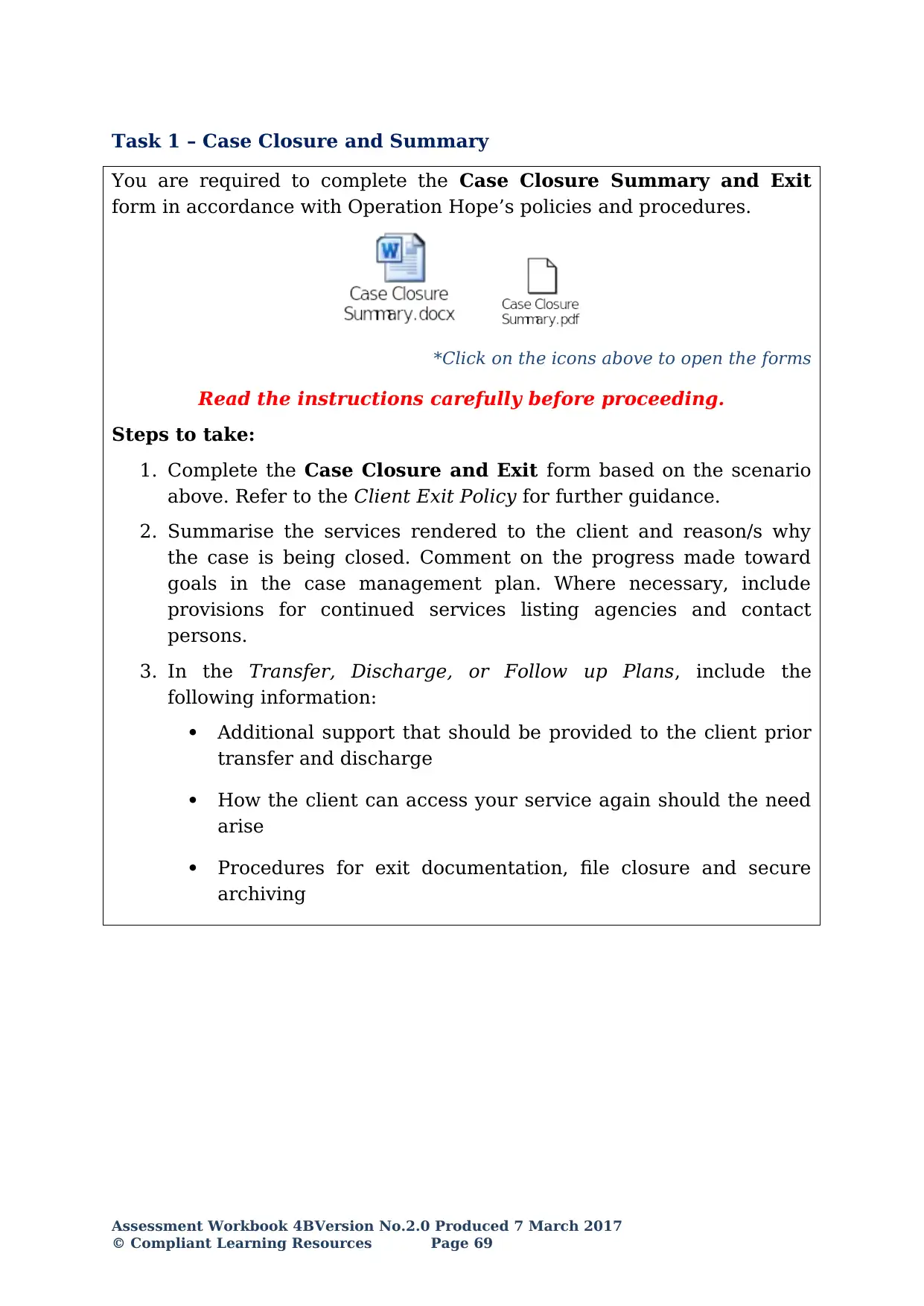
Task 1 – Case Closure and Summary
You are required to complete the Case Closure Summary and Exit
form in accordance with Operation Hope’s policies and procedures.
*Click on the icons above to open the forms
Read the instructions carefully before proceeding.
Steps to take:
1. Complete the Case Closure and Exit form based on the scenario
above. Refer to the Client Exit Policy for further guidance.
2. Summarise the services rendered to the client and reason/s why
the case is being closed. Comment on the progress made toward
goals in the case management plan. Where necessary, include
provisions for continued services listing agencies and contact
persons.
3. In the Transfer, Discharge, or Follow up Plans, include the
following information:
Additional support that should be provided to the client prior
transfer and discharge
How the client can access your service again should the need
arise
Procedures for exit documentation, file closure and secure
archiving
Assessment Workbook 4BVersion No.2.0 Produced 7 March 2017
© Compliant Learning Resources Page 69
You are required to complete the Case Closure Summary and Exit
form in accordance with Operation Hope’s policies and procedures.
*Click on the icons above to open the forms
Read the instructions carefully before proceeding.
Steps to take:
1. Complete the Case Closure and Exit form based on the scenario
above. Refer to the Client Exit Policy for further guidance.
2. Summarise the services rendered to the client and reason/s why
the case is being closed. Comment on the progress made toward
goals in the case management plan. Where necessary, include
provisions for continued services listing agencies and contact
persons.
3. In the Transfer, Discharge, or Follow up Plans, include the
following information:
Additional support that should be provided to the client prior
transfer and discharge
How the client can access your service again should the need
arise
Procedures for exit documentation, file closure and secure
archiving
Assessment Workbook 4BVersion No.2.0 Produced 7 March 2017
© Compliant Learning Resources Page 69
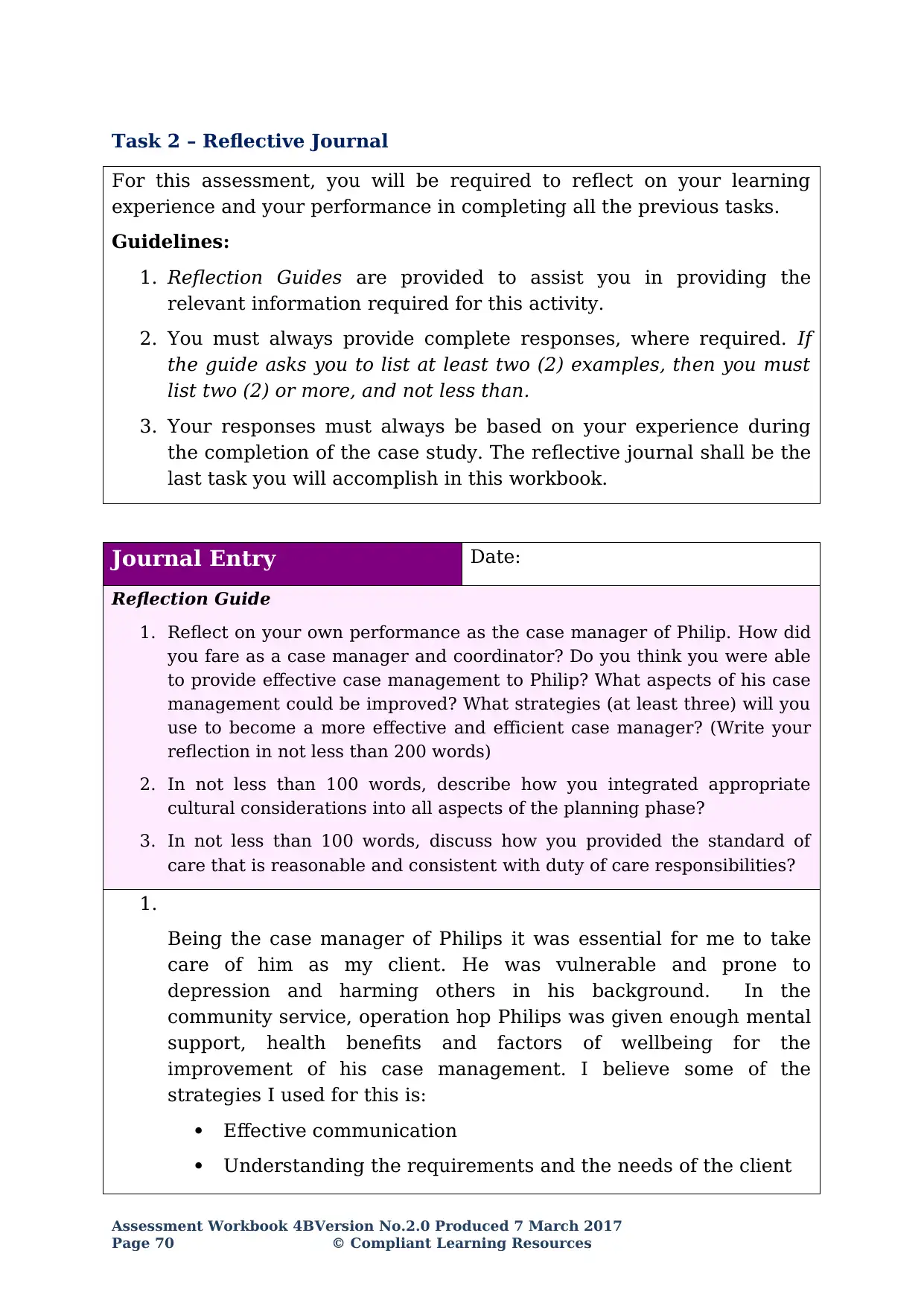
Task 2 – Reflective Journal
For this assessment, you will be required to reflect on your learning
experience and your performance in completing all the previous tasks.
Guidelines:
1. Reflection Guides are provided to assist you in providing the
relevant information required for this activity.
2. You must always provide complete responses, where required. If
the guide asks you to list at least two (2) examples, then you must
list two (2) or more, and not less than.
3. Your responses must always be based on your experience during
the completion of the case study. The reflective journal shall be the
last task you will accomplish in this workbook.
Journal Entry Date:
Reflection Guide
1. Reflect on your own performance as the case manager of Philip. How did
you fare as a case manager and coordinator? Do you think you were able
to provide effective case management to Philip? What aspects of his case
management could be improved? What strategies (at least three) will you
use to become a more effective and efficient case manager? (Write your
reflection in not less than 200 words)
2. In not less than 100 words, describe how you integrated appropriate
cultural considerations into all aspects of the planning phase?
3. In not less than 100 words, discuss how you provided the standard of
care that is reasonable and consistent with duty of care responsibilities?
1.
Being the case manager of Philips it was essential for me to take
care of him as my client. He was vulnerable and prone to
depression and harming others in his background. In the
community service, operation hop Philips was given enough mental
support, health benefits and factors of wellbeing for the
improvement of his case management. I believe some of the
strategies I used for this is:
Effective communication
Understanding the requirements and the needs of the client
Assessment Workbook 4BVersion No.2.0 Produced 7 March 2017
Page 70 © Compliant Learning Resources
For this assessment, you will be required to reflect on your learning
experience and your performance in completing all the previous tasks.
Guidelines:
1. Reflection Guides are provided to assist you in providing the
relevant information required for this activity.
2. You must always provide complete responses, where required. If
the guide asks you to list at least two (2) examples, then you must
list two (2) or more, and not less than.
3. Your responses must always be based on your experience during
the completion of the case study. The reflective journal shall be the
last task you will accomplish in this workbook.
Journal Entry Date:
Reflection Guide
1. Reflect on your own performance as the case manager of Philip. How did
you fare as a case manager and coordinator? Do you think you were able
to provide effective case management to Philip? What aspects of his case
management could be improved? What strategies (at least three) will you
use to become a more effective and efficient case manager? (Write your
reflection in not less than 200 words)
2. In not less than 100 words, describe how you integrated appropriate
cultural considerations into all aspects of the planning phase?
3. In not less than 100 words, discuss how you provided the standard of
care that is reasonable and consistent with duty of care responsibilities?
1.
Being the case manager of Philips it was essential for me to take
care of him as my client. He was vulnerable and prone to
depression and harming others in his background. In the
community service, operation hop Philips was given enough mental
support, health benefits and factors of wellbeing for the
improvement of his case management. I believe some of the
strategies I used for this is:
Effective communication
Understanding the requirements and the needs of the client
Assessment Workbook 4BVersion No.2.0 Produced 7 March 2017
Page 70 © Compliant Learning Resources
Secure Best Marks with AI Grader
Need help grading? Try our AI Grader for instant feedback on your assignments.

Helping him to regenerate and boost up self esteem
These have developed the case to become more effective and efficient. I
have tried my level best to help Philips overcome his depression and join
his regular normal life.i furthermore referred him to ozcare, one of the
rehabilitation service so that he gets out of his drunken abilities. The
case management just got improved by the effective measures and the
recommendations.
2.
Appropriate cultural communication was furthermore taken in
consideration while forming the case of Philips. Some of the
cultural consideration I maintained in the following case included
ethnicity and country regarding the birth, the preferred language
and knowledge, the level of literacy, preferences of the interpreter,
the experience relation to the migration status and the health, the
belief regarding the illness and the health, the understanding of the
system of the health and more.
3.
Standard care with the consistent duty of the responsibilities in
case of Philips included instances of
Emotional support
Financial support
Healing of physical and the mental pain
Mapping of the employment opportunities
Reconciliation with the family and the friends especially with
wife and children
Boost of self confidence and hope for a future life
Removal of the habit of drinking and smoking which
furthermore hampers the way towards the wellbeing
Assessment Workbook 4BVersion No.2.0 Produced 7 March 2017
© Compliant Learning Resources Page 71
These have developed the case to become more effective and efficient. I
have tried my level best to help Philips overcome his depression and join
his regular normal life.i furthermore referred him to ozcare, one of the
rehabilitation service so that he gets out of his drunken abilities. The
case management just got improved by the effective measures and the
recommendations.
2.
Appropriate cultural communication was furthermore taken in
consideration while forming the case of Philips. Some of the
cultural consideration I maintained in the following case included
ethnicity and country regarding the birth, the preferred language
and knowledge, the level of literacy, preferences of the interpreter,
the experience relation to the migration status and the health, the
belief regarding the illness and the health, the understanding of the
system of the health and more.
3.
Standard care with the consistent duty of the responsibilities in
case of Philips included instances of
Emotional support
Financial support
Healing of physical and the mental pain
Mapping of the employment opportunities
Reconciliation with the family and the friends especially with
wife and children
Boost of self confidence and hope for a future life
Removal of the habit of drinking and smoking which
furthermore hampers the way towards the wellbeing
Assessment Workbook 4BVersion No.2.0 Produced 7 March 2017
© Compliant Learning Resources Page 71
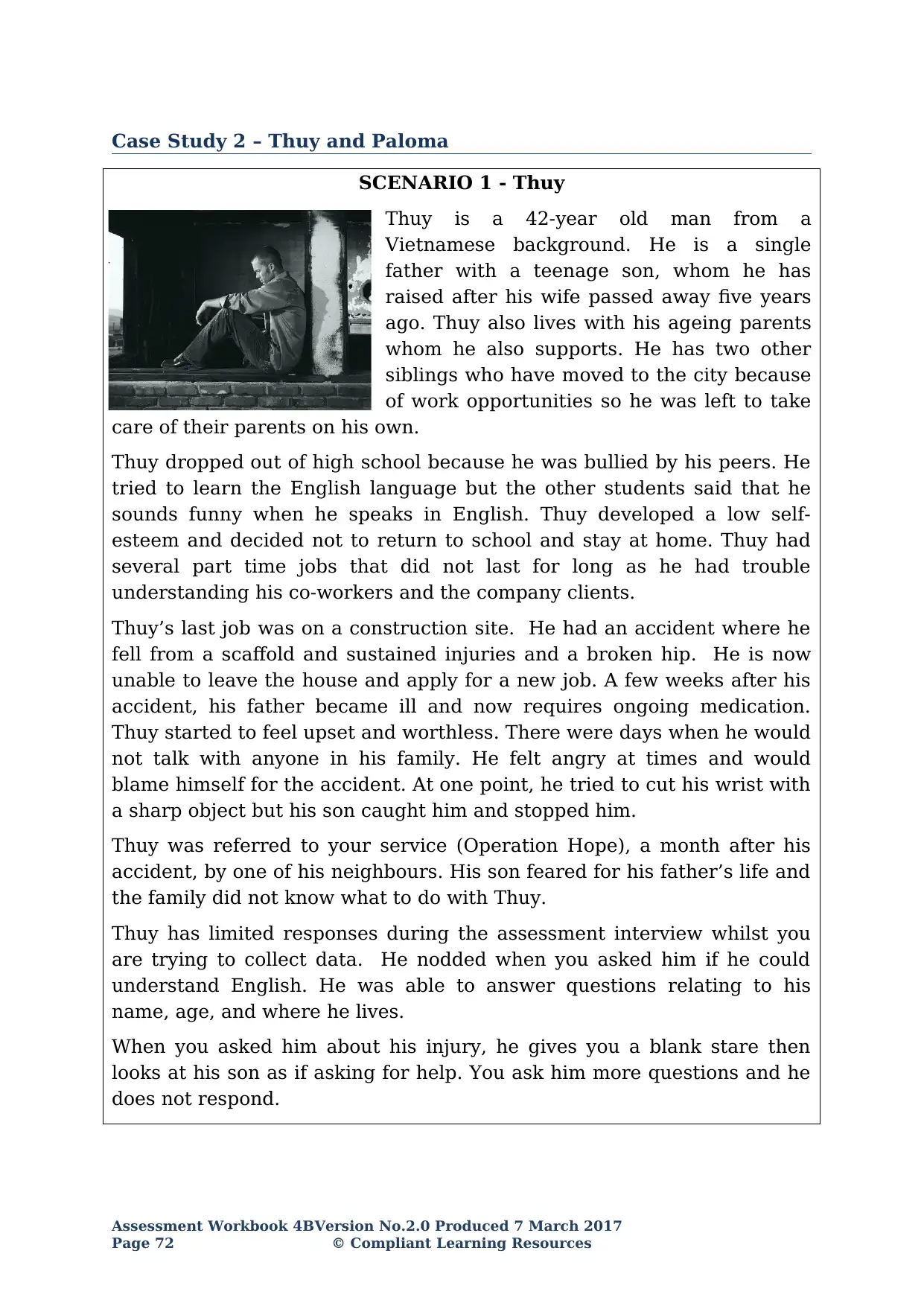
Case Study 2 – Thuy and Paloma
SCENARIO 1 - Thuy
Thuy is a 42-year old man from a
Vietnamese background. He is a single
father with a teenage son, whom he has
raised after his wife passed away five years
ago. Thuy also lives with his ageing parents
whom he also supports. He has two other
siblings who have moved to the city because
of work opportunities so he was left to take
care of their parents on his own.
Thuy dropped out of high school because he was bullied by his peers. He
tried to learn the English language but the other students said that he
sounds funny when he speaks in English. Thuy developed a low self-
esteem and decided not to return to school and stay at home. Thuy had
several part time jobs that did not last for long as he had trouble
understanding his co-workers and the company clients.
Thuy’s last job was on a construction site. He had an accident where he
fell from a scaffold and sustained injuries and a broken hip. He is now
unable to leave the house and apply for a new job. A few weeks after his
accident, his father became ill and now requires ongoing medication.
Thuy started to feel upset and worthless. There were days when he would
not talk with anyone in his family. He felt angry at times and would
blame himself for the accident. At one point, he tried to cut his wrist with
a sharp object but his son caught him and stopped him.
Thuy was referred to your service (Operation Hope), a month after his
accident, by one of his neighbours. His son feared for his father’s life and
the family did not know what to do with Thuy.
Thuy has limited responses during the assessment interview whilst you
are trying to collect data. He nodded when you asked him if he could
understand English. He was able to answer questions relating to his
name, age, and where he lives.
When you asked him about his injury, he gives you a blank stare then
looks at his son as if asking for help. You ask him more questions and he
does not respond.
Assessment Workbook 4BVersion No.2.0 Produced 7 March 2017
Page 72 © Compliant Learning Resources
SCENARIO 1 - Thuy
Thuy is a 42-year old man from a
Vietnamese background. He is a single
father with a teenage son, whom he has
raised after his wife passed away five years
ago. Thuy also lives with his ageing parents
whom he also supports. He has two other
siblings who have moved to the city because
of work opportunities so he was left to take
care of their parents on his own.
Thuy dropped out of high school because he was bullied by his peers. He
tried to learn the English language but the other students said that he
sounds funny when he speaks in English. Thuy developed a low self-
esteem and decided not to return to school and stay at home. Thuy had
several part time jobs that did not last for long as he had trouble
understanding his co-workers and the company clients.
Thuy’s last job was on a construction site. He had an accident where he
fell from a scaffold and sustained injuries and a broken hip. He is now
unable to leave the house and apply for a new job. A few weeks after his
accident, his father became ill and now requires ongoing medication.
Thuy started to feel upset and worthless. There were days when he would
not talk with anyone in his family. He felt angry at times and would
blame himself for the accident. At one point, he tried to cut his wrist with
a sharp object but his son caught him and stopped him.
Thuy was referred to your service (Operation Hope), a month after his
accident, by one of his neighbours. His son feared for his father’s life and
the family did not know what to do with Thuy.
Thuy has limited responses during the assessment interview whilst you
are trying to collect data. He nodded when you asked him if he could
understand English. He was able to answer questions relating to his
name, age, and where he lives.
When you asked him about his injury, he gives you a blank stare then
looks at his son as if asking for help. You ask him more questions and he
does not respond.
Assessment Workbook 4BVersion No.2.0 Produced 7 March 2017
Page 72 © Compliant Learning Resources
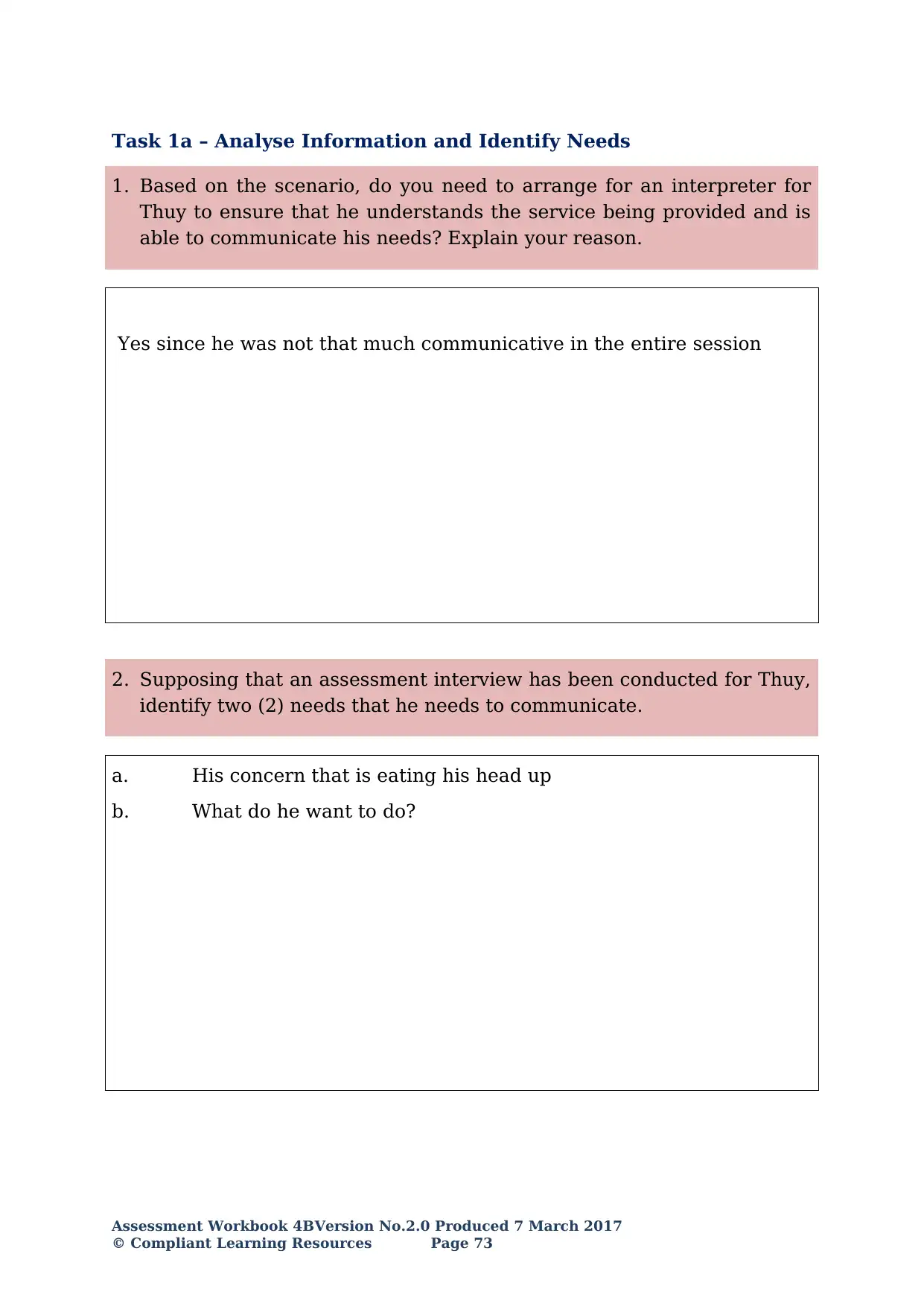
Task 1a – Analyse Information and Identify Needs
1. Based on the scenario, do you need to arrange for an interpreter for
Thuy to ensure that he understands the service being provided and is
able to communicate his needs? Explain your reason.
Yes since he was not that much communicative in the entire session
2. Supposing that an assessment interview has been conducted for Thuy,
identify two (2) needs that he needs to communicate.
a. His concern that is eating his head up
b. What do he want to do?
Assessment Workbook 4BVersion No.2.0 Produced 7 March 2017
© Compliant Learning Resources Page 73
1. Based on the scenario, do you need to arrange for an interpreter for
Thuy to ensure that he understands the service being provided and is
able to communicate his needs? Explain your reason.
Yes since he was not that much communicative in the entire session
2. Supposing that an assessment interview has been conducted for Thuy,
identify two (2) needs that he needs to communicate.
a. His concern that is eating his head up
b. What do he want to do?
Assessment Workbook 4BVersion No.2.0 Produced 7 March 2017
© Compliant Learning Resources Page 73
Paraphrase This Document
Need a fresh take? Get an instant paraphrase of this document with our AI Paraphraser

3. List two (2) ways on how you can identify Thuy’s spoken language.
Guidance: For this assessment, you are only informed that Thuy’s family
came from Vietnam.
a. With the help of his son
b. Understand through his written diary or making a comfortable
zone for him to speak
You informed Thuy that you will be arranging an interpreter for him in
order to proceed with his assessment interview. Thuy shook his head and
you repeated that instruction about arranging an interpreter. He shook
his head and waved his hand. You reckoned that he understood the word
‘interpreter’ but he refused to have one.
4. Explain the action you should do when a client refuses to use an
interpreter.
Help the client to explain his issues
Understand his pain giving him assurance that everything will be fine
Assessment Workbook 4BVersion No.2.0 Produced 7 March 2017
Page 74 © Compliant Learning Resources
Guidance: For this assessment, you are only informed that Thuy’s family
came from Vietnam.
a. With the help of his son
b. Understand through his written diary or making a comfortable
zone for him to speak
You informed Thuy that you will be arranging an interpreter for him in
order to proceed with his assessment interview. Thuy shook his head and
you repeated that instruction about arranging an interpreter. He shook
his head and waved his hand. You reckoned that he understood the word
‘interpreter’ but he refused to have one.
4. Explain the action you should do when a client refuses to use an
interpreter.
Help the client to explain his issues
Understand his pain giving him assurance that everything will be fine
Assessment Workbook 4BVersion No.2.0 Produced 7 March 2017
Page 74 © Compliant Learning Resources

Assessment Workbook 4BVersion No.2.0 Produced 7 March 2017
© Compliant Learning Resources Page 75
© Compliant Learning Resources Page 75
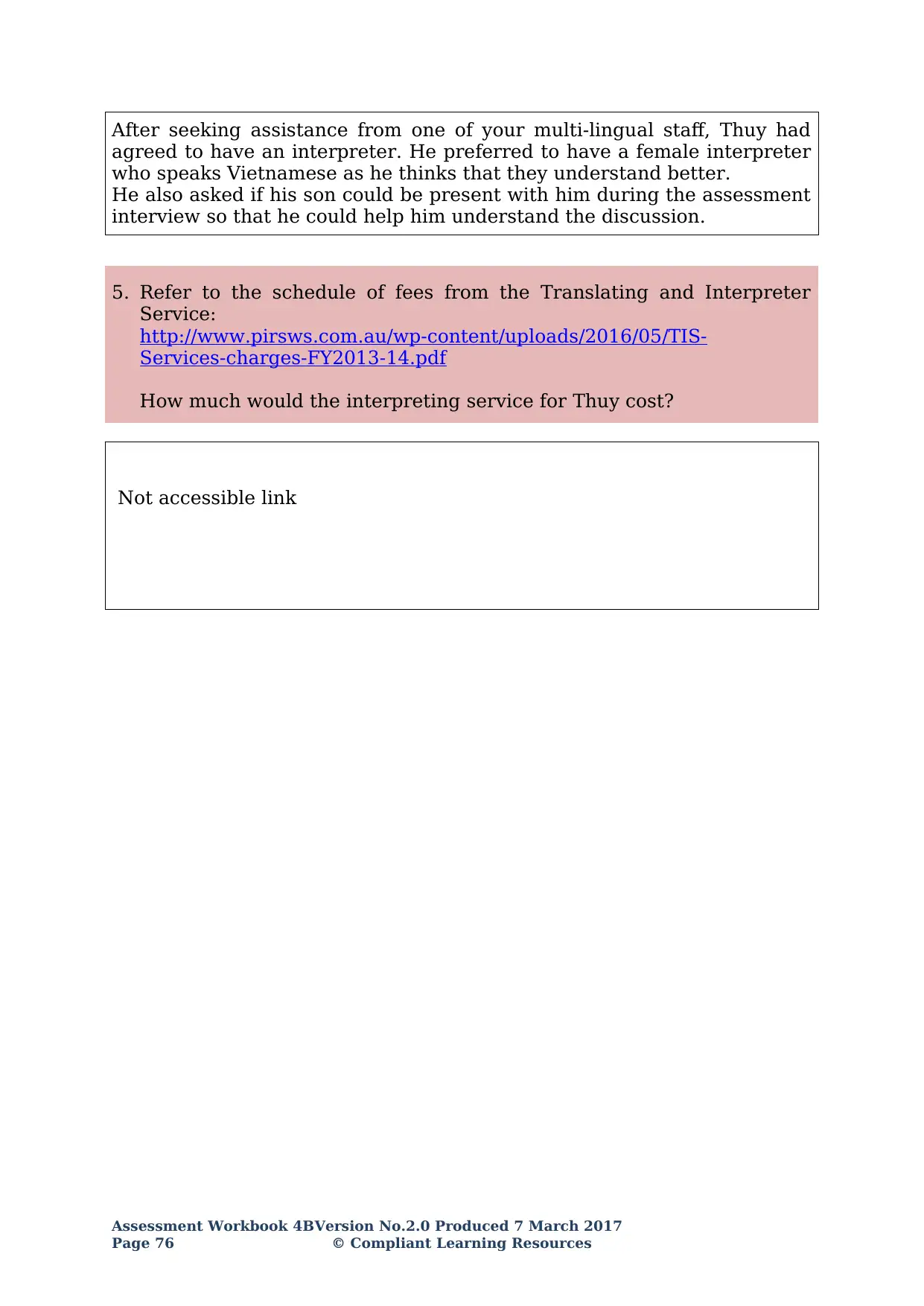
After seeking assistance from one of your multi-lingual staff, Thuy had
agreed to have an interpreter. He preferred to have a female interpreter
who speaks Vietnamese as he thinks that they understand better.
He also asked if his son could be present with him during the assessment
interview so that he could help him understand the discussion.
5. Refer to the schedule of fees from the Translating and Interpreter
Service:
http://www.pirsws.com.au/wp-content/uploads/2016/05/TIS-
Services-charges-FY2013-14.pdf
How much would the interpreting service for Thuy cost?
Not accessible link
Assessment Workbook 4BVersion No.2.0 Produced 7 March 2017
Page 76 © Compliant Learning Resources
agreed to have an interpreter. He preferred to have a female interpreter
who speaks Vietnamese as he thinks that they understand better.
He also asked if his son could be present with him during the assessment
interview so that he could help him understand the discussion.
5. Refer to the schedule of fees from the Translating and Interpreter
Service:
http://www.pirsws.com.au/wp-content/uploads/2016/05/TIS-
Services-charges-FY2013-14.pdf
How much would the interpreting service for Thuy cost?
Not accessible link
Assessment Workbook 4BVersion No.2.0 Produced 7 March 2017
Page 76 © Compliant Learning Resources
Secure Best Marks with AI Grader
Need help grading? Try our AI Grader for instant feedback on your assignments.
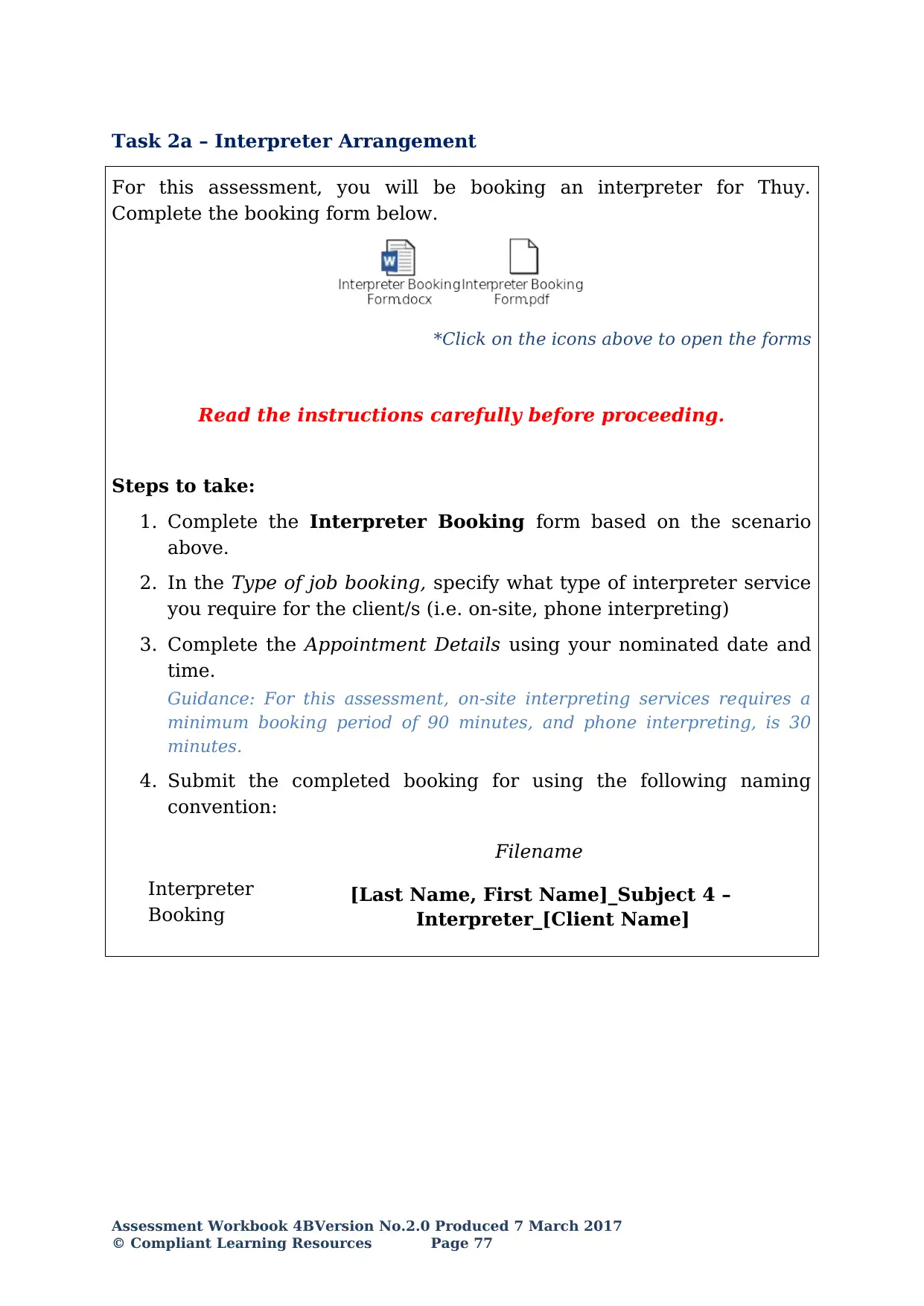
Task 2a – Interpreter Arrangement
For this assessment, you will be booking an interpreter for Thuy.
Complete the booking form below.
*Click on the icons above to open the forms
Read the instructions carefully before proceeding.
Steps to take:
1. Complete the Interpreter Booking form based on the scenario
above.
2. In the Type of job booking, specify what type of interpreter service
you require for the client/s (i.e. on-site, phone interpreting)
3. Complete the Appointment Details using your nominated date and
time.
Guidance: For this assessment, on-site interpreting services requires a
minimum booking period of 90 minutes, and phone interpreting, is 30
minutes.
4. Submit the completed booking for using the following naming
convention:
Filename
Interpreter
Booking
[Last Name, First Name]_Subject 4 –
Interpreter_[Client Name]
Assessment Workbook 4BVersion No.2.0 Produced 7 March 2017
© Compliant Learning Resources Page 77
For this assessment, you will be booking an interpreter for Thuy.
Complete the booking form below.
*Click on the icons above to open the forms
Read the instructions carefully before proceeding.
Steps to take:
1. Complete the Interpreter Booking form based on the scenario
above.
2. In the Type of job booking, specify what type of interpreter service
you require for the client/s (i.e. on-site, phone interpreting)
3. Complete the Appointment Details using your nominated date and
time.
Guidance: For this assessment, on-site interpreting services requires a
minimum booking period of 90 minutes, and phone interpreting, is 30
minutes.
4. Submit the completed booking for using the following naming
convention:
Filename
Interpreter
Booking
[Last Name, First Name]_Subject 4 –
Interpreter_[Client Name]
Assessment Workbook 4BVersion No.2.0 Produced 7 March 2017
© Compliant Learning Resources Page 77
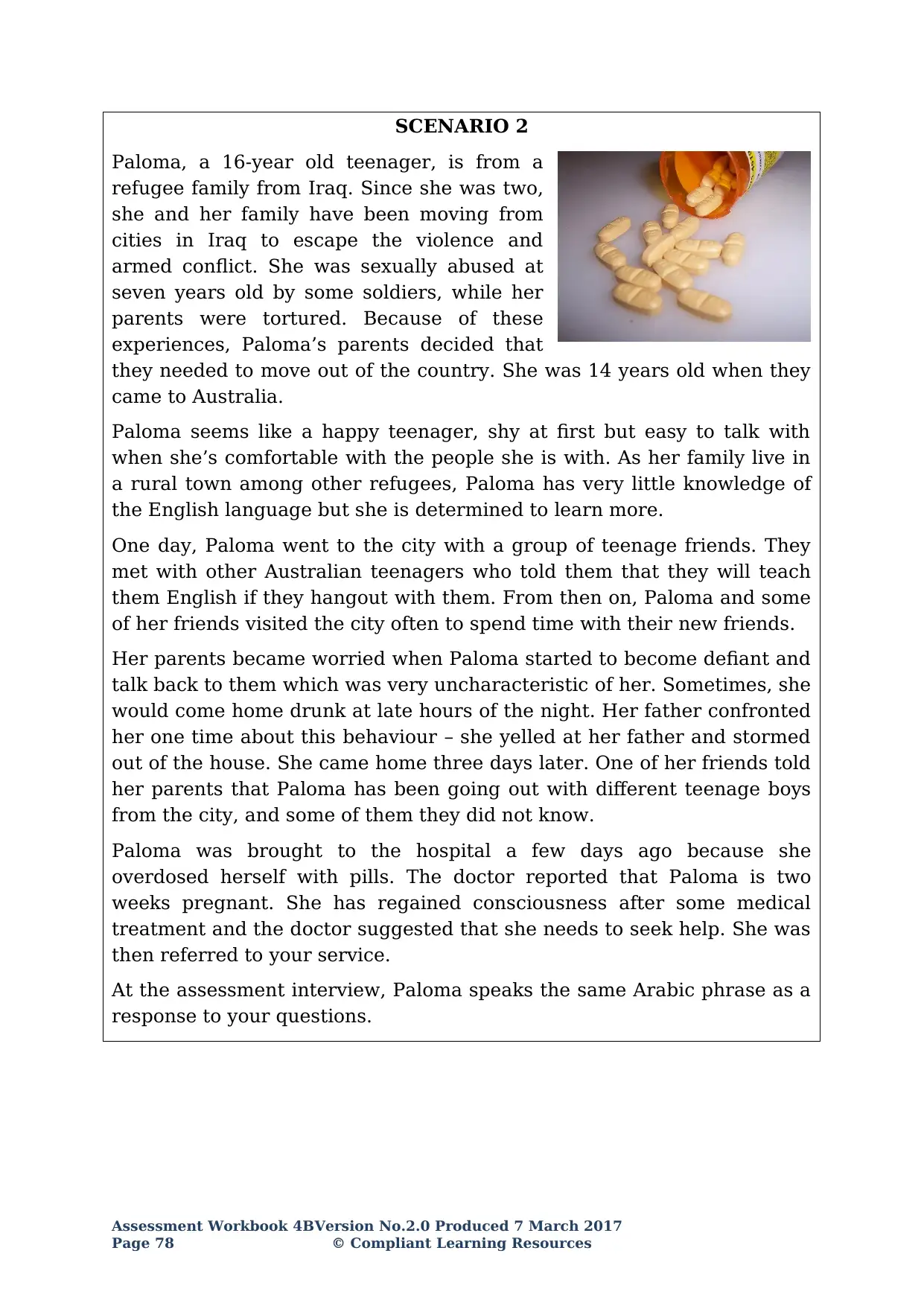
SCENARIO 2
Paloma, a 16-year old teenager, is from a
refugee family from Iraq. Since she was two,
she and her family have been moving from
cities in Iraq to escape the violence and
armed conflict. She was sexually abused at
seven years old by some soldiers, while her
parents were tortured. Because of these
experiences, Paloma’s parents decided that
they needed to move out of the country. She was 14 years old when they
came to Australia.
Paloma seems like a happy teenager, shy at first but easy to talk with
when she’s comfortable with the people she is with. As her family live in
a rural town among other refugees, Paloma has very little knowledge of
the English language but she is determined to learn more.
One day, Paloma went to the city with a group of teenage friends. They
met with other Australian teenagers who told them that they will teach
them English if they hangout with them. From then on, Paloma and some
of her friends visited the city often to spend time with their new friends.
Her parents became worried when Paloma started to become defiant and
talk back to them which was very uncharacteristic of her. Sometimes, she
would come home drunk at late hours of the night. Her father confronted
her one time about this behaviour – she yelled at her father and stormed
out of the house. She came home three days later. One of her friends told
her parents that Paloma has been going out with different teenage boys
from the city, and some of them they did not know.
Paloma was brought to the hospital a few days ago because she
overdosed herself with pills. The doctor reported that Paloma is two
weeks pregnant. She has regained consciousness after some medical
treatment and the doctor suggested that she needs to seek help. She was
then referred to your service.
At the assessment interview, Paloma speaks the same Arabic phrase as a
response to your questions.
Assessment Workbook 4BVersion No.2.0 Produced 7 March 2017
Page 78 © Compliant Learning Resources
Paloma, a 16-year old teenager, is from a
refugee family from Iraq. Since she was two,
she and her family have been moving from
cities in Iraq to escape the violence and
armed conflict. She was sexually abused at
seven years old by some soldiers, while her
parents were tortured. Because of these
experiences, Paloma’s parents decided that
they needed to move out of the country. She was 14 years old when they
came to Australia.
Paloma seems like a happy teenager, shy at first but easy to talk with
when she’s comfortable with the people she is with. As her family live in
a rural town among other refugees, Paloma has very little knowledge of
the English language but she is determined to learn more.
One day, Paloma went to the city with a group of teenage friends. They
met with other Australian teenagers who told them that they will teach
them English if they hangout with them. From then on, Paloma and some
of her friends visited the city often to spend time with their new friends.
Her parents became worried when Paloma started to become defiant and
talk back to them which was very uncharacteristic of her. Sometimes, she
would come home drunk at late hours of the night. Her father confronted
her one time about this behaviour – she yelled at her father and stormed
out of the house. She came home three days later. One of her friends told
her parents that Paloma has been going out with different teenage boys
from the city, and some of them they did not know.
Paloma was brought to the hospital a few days ago because she
overdosed herself with pills. The doctor reported that Paloma is two
weeks pregnant. She has regained consciousness after some medical
treatment and the doctor suggested that she needs to seek help. She was
then referred to your service.
At the assessment interview, Paloma speaks the same Arabic phrase as a
response to your questions.
Assessment Workbook 4BVersion No.2.0 Produced 7 March 2017
Page 78 © Compliant Learning Resources

Task 1b – Analyse Information and Identify Needs
1. Based on the scenario, do you need to arrange for an interpreter for
Paloma? Explain your reason.
Yes, I need to arrange one interpreter
2. Supposing that an assessment interview has been conducted for
Paloma, identify two (2) needs that she needs to communicate.
Mapping: CHCCSM004 PC2.4(p)
a. What actually happened to her in the three days she was missing
b. Why did she overdosed herself with pills?
Assessment Workbook 4BVersion No.2.0 Produced 7 March 2017
© Compliant Learning Resources Page 79
1. Based on the scenario, do you need to arrange for an interpreter for
Paloma? Explain your reason.
Yes, I need to arrange one interpreter
2. Supposing that an assessment interview has been conducted for
Paloma, identify two (2) needs that she needs to communicate.
Mapping: CHCCSM004 PC2.4(p)
a. What actually happened to her in the three days she was missing
b. Why did she overdosed herself with pills?
Assessment Workbook 4BVersion No.2.0 Produced 7 March 2017
© Compliant Learning Resources Page 79
Paraphrase This Document
Need a fresh take? Get an instant paraphrase of this document with our AI Paraphraser
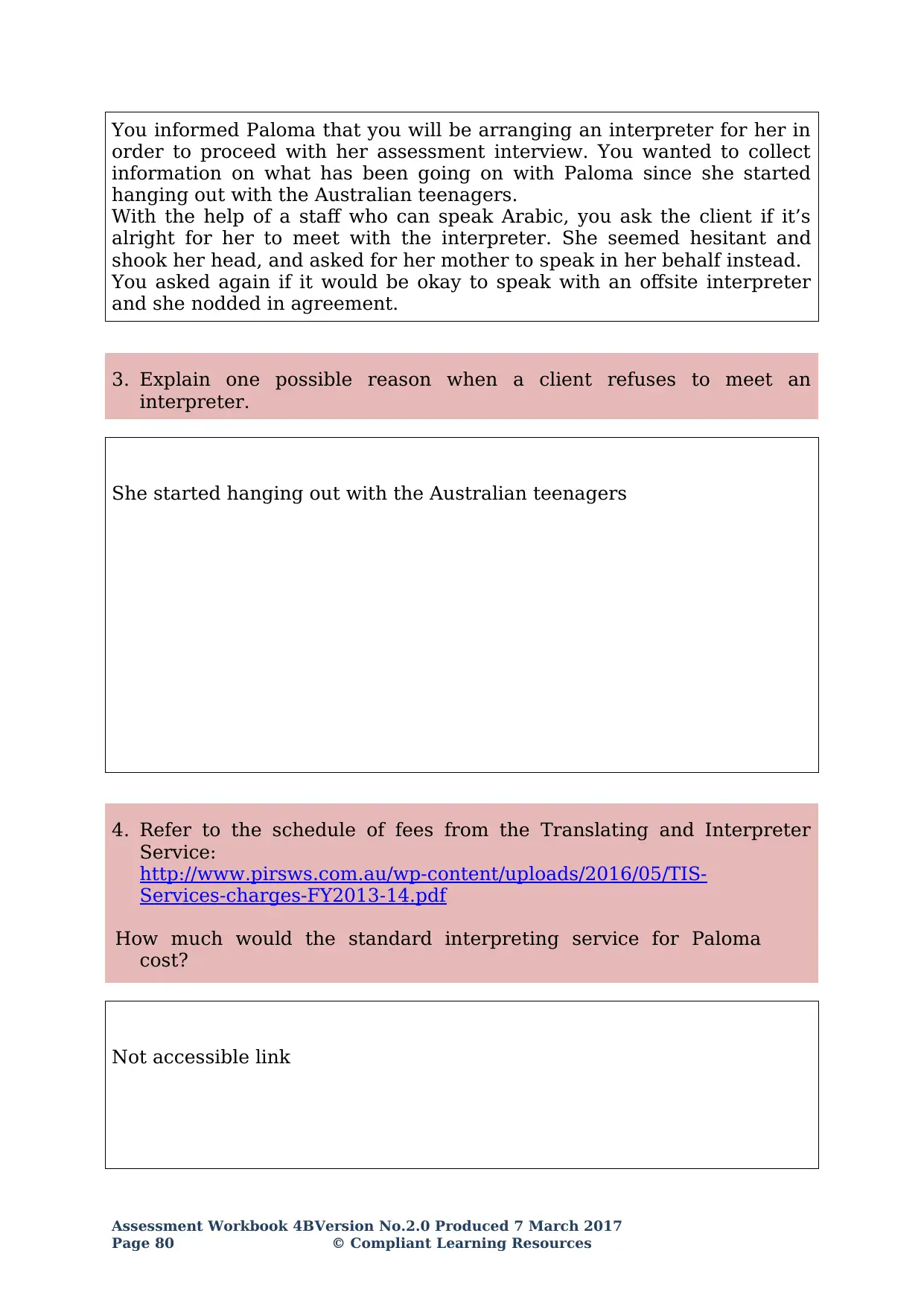
You informed Paloma that you will be arranging an interpreter for her in
order to proceed with her assessment interview. You wanted to collect
information on what has been going on with Paloma since she started
hanging out with the Australian teenagers.
With the help of a staff who can speak Arabic, you ask the client if it’s
alright for her to meet with the interpreter. She seemed hesitant and
shook her head, and asked for her mother to speak in her behalf instead.
You asked again if it would be okay to speak with an offsite interpreter
and she nodded in agreement.
3. Explain one possible reason when a client refuses to meet an
interpreter.
She started hanging out with the Australian teenagers
4. Refer to the schedule of fees from the Translating and Interpreter
Service:
http://www.pirsws.com.au/wp-content/uploads/2016/05/TIS-
Services-charges-FY2013-14.pdf
How much would the standard interpreting service for Paloma
cost?
Not accessible link
Assessment Workbook 4BVersion No.2.0 Produced 7 March 2017
Page 80 © Compliant Learning Resources
order to proceed with her assessment interview. You wanted to collect
information on what has been going on with Paloma since she started
hanging out with the Australian teenagers.
With the help of a staff who can speak Arabic, you ask the client if it’s
alright for her to meet with the interpreter. She seemed hesitant and
shook her head, and asked for her mother to speak in her behalf instead.
You asked again if it would be okay to speak with an offsite interpreter
and she nodded in agreement.
3. Explain one possible reason when a client refuses to meet an
interpreter.
She started hanging out with the Australian teenagers
4. Refer to the schedule of fees from the Translating and Interpreter
Service:
http://www.pirsws.com.au/wp-content/uploads/2016/05/TIS-
Services-charges-FY2013-14.pdf
How much would the standard interpreting service for Paloma
cost?
Not accessible link
Assessment Workbook 4BVersion No.2.0 Produced 7 March 2017
Page 80 © Compliant Learning Resources
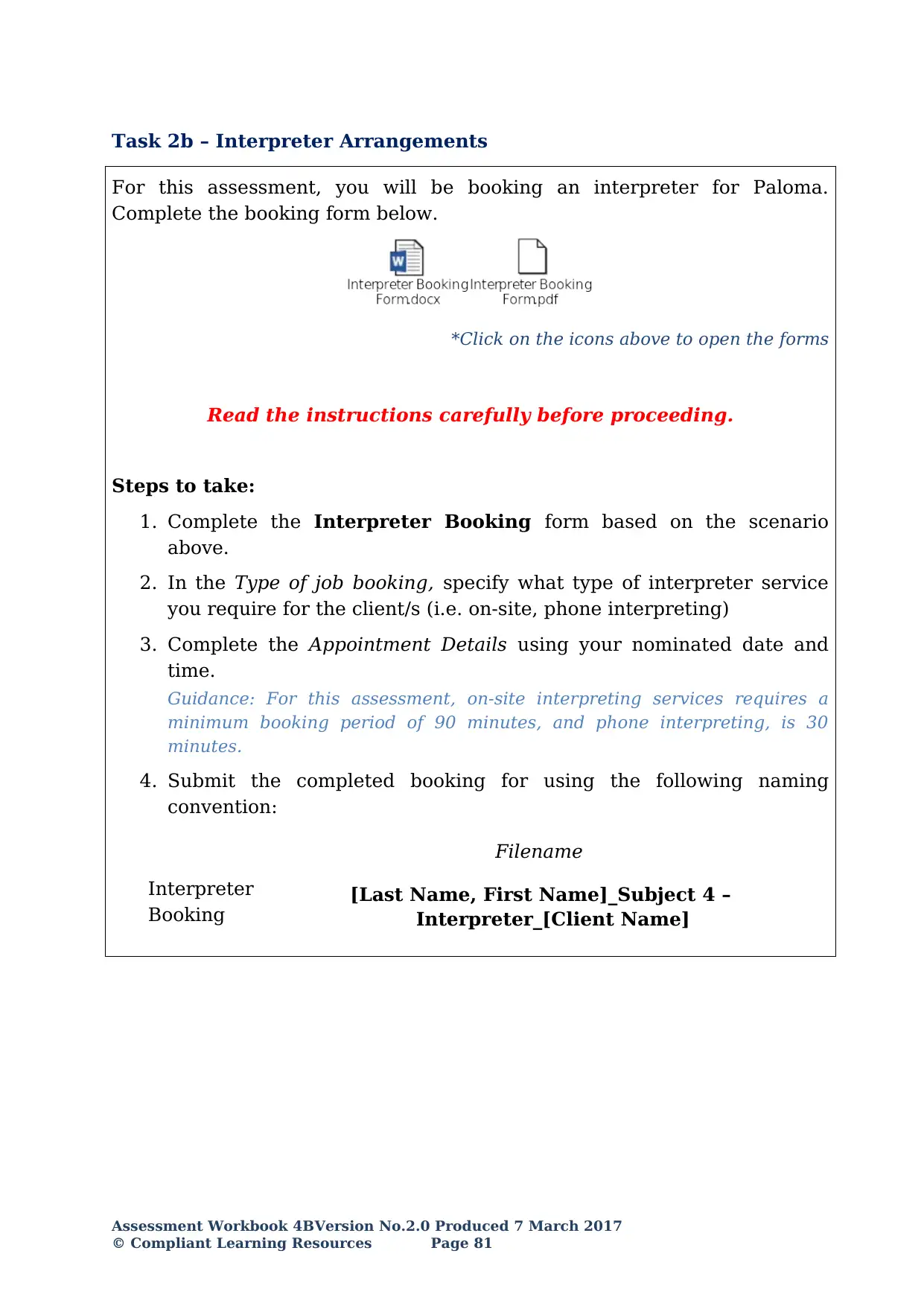
Task 2b – Interpreter Arrangements
For this assessment, you will be booking an interpreter for Paloma.
Complete the booking form below.
*Click on the icons above to open the forms
Read the instructions carefully before proceeding.
Steps to take:
1. Complete the Interpreter Booking form based on the scenario
above.
2. In the Type of job booking, specify what type of interpreter service
you require for the client/s (i.e. on-site, phone interpreting)
3. Complete the Appointment Details using your nominated date and
time.
Guidance: For this assessment, on-site interpreting services requires a
minimum booking period of 90 minutes, and phone interpreting, is 30
minutes.
4. Submit the completed booking for using the following naming
convention:
Filename
Interpreter
Booking
[Last Name, First Name]_Subject 4 –
Interpreter_[Client Name]
Assessment Workbook 4BVersion No.2.0 Produced 7 March 2017
© Compliant Learning Resources Page 81
For this assessment, you will be booking an interpreter for Paloma.
Complete the booking form below.
*Click on the icons above to open the forms
Read the instructions carefully before proceeding.
Steps to take:
1. Complete the Interpreter Booking form based on the scenario
above.
2. In the Type of job booking, specify what type of interpreter service
you require for the client/s (i.e. on-site, phone interpreting)
3. Complete the Appointment Details using your nominated date and
time.
Guidance: For this assessment, on-site interpreting services requires a
minimum booking period of 90 minutes, and phone interpreting, is 30
minutes.
4. Submit the completed booking for using the following naming
convention:
Filename
Interpreter
Booking
[Last Name, First Name]_Subject 4 –
Interpreter_[Client Name]
Assessment Workbook 4BVersion No.2.0 Produced 7 March 2017
© Compliant Learning Resources Page 81
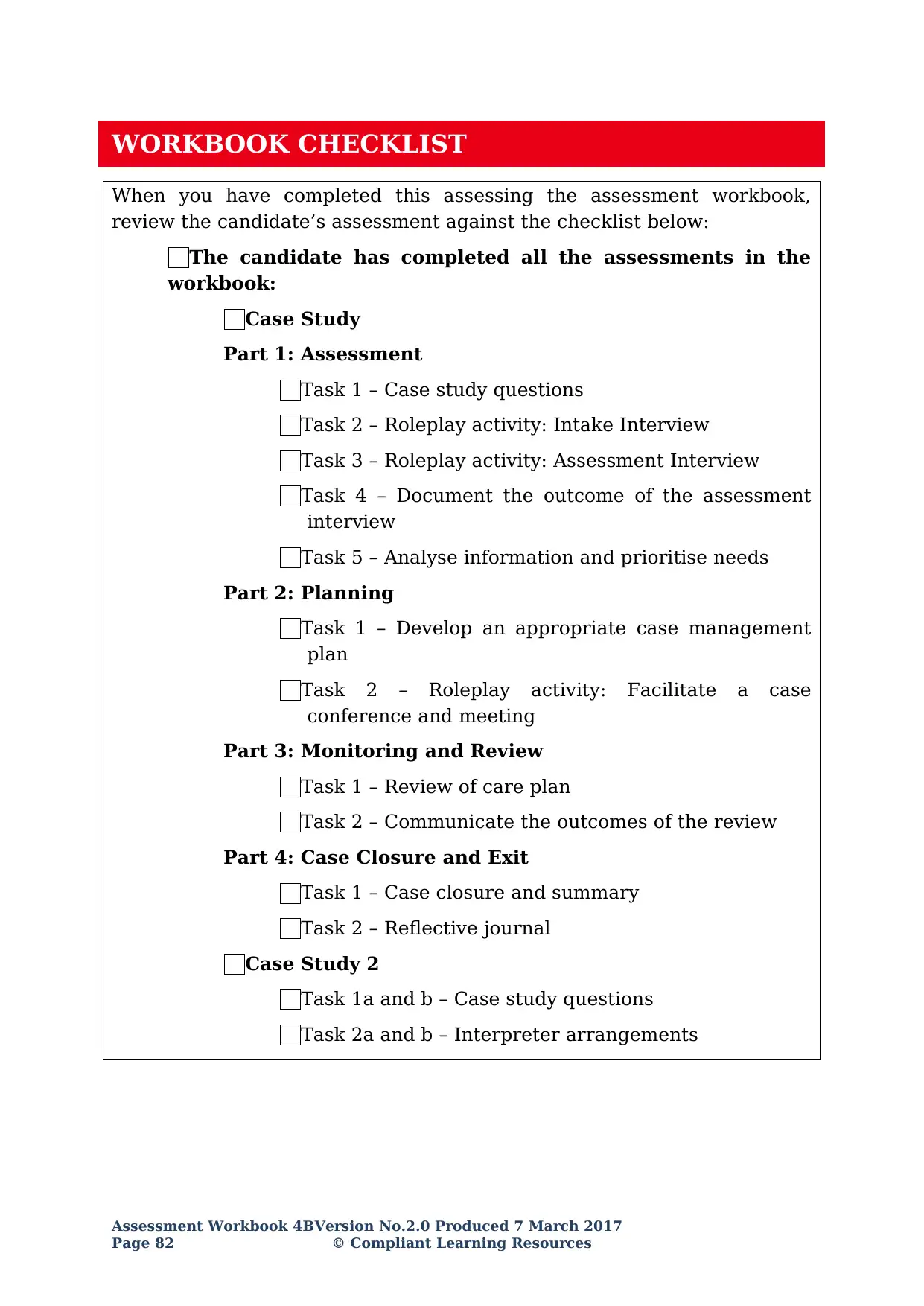
WORKBOOK CHECKLIST
When you have completed this assessing the assessment workbook,
review the candidate’s assessment against the checklist below:
The candidate has completed all the assessments in the
workbook:
Case Study
Part 1: Assessment
Task 1 – Case study questions
Task 2 – Roleplay activity: Intake Interview
Task 3 – Roleplay activity: Assessment Interview
Task 4 – Document the outcome of the assessment
interview
Task 5 – Analyse information and prioritise needs
Part 2: Planning
Task 1 – Develop an appropriate case management
plan
Task 2 – Roleplay activity: Facilitate a case
conference and meeting
Part 3: Monitoring and Review
Task 1 – Review of care plan
Task 2 – Communicate the outcomes of the review
Part 4: Case Closure and Exit
Task 1 – Case closure and summary
Task 2 – Reflective journal
Case Study 2
Task 1a and b – Case study questions
Task 2a and b – Interpreter arrangements
Assessment Workbook 4BVersion No.2.0 Produced 7 March 2017
Page 82 © Compliant Learning Resources
When you have completed this assessing the assessment workbook,
review the candidate’s assessment against the checklist below:
The candidate has completed all the assessments in the
workbook:
Case Study
Part 1: Assessment
Task 1 – Case study questions
Task 2 – Roleplay activity: Intake Interview
Task 3 – Roleplay activity: Assessment Interview
Task 4 – Document the outcome of the assessment
interview
Task 5 – Analyse information and prioritise needs
Part 2: Planning
Task 1 – Develop an appropriate case management
plan
Task 2 – Roleplay activity: Facilitate a case
conference and meeting
Part 3: Monitoring and Review
Task 1 – Review of care plan
Task 2 – Communicate the outcomes of the review
Part 4: Case Closure and Exit
Task 1 – Case closure and summary
Task 2 – Reflective journal
Case Study 2
Task 1a and b – Case study questions
Task 2a and b – Interpreter arrangements
Assessment Workbook 4BVersion No.2.0 Produced 7 March 2017
Page 82 © Compliant Learning Resources
Secure Best Marks with AI Grader
Need help grading? Try our AI Grader for instant feedback on your assignments.

IMPORTANT REMINDER
Candidates must achieve a satisfactory result to ALL assessment tasks
to be awarded COMPETENT for the units relevant to this cluster.
To award the candidate competent in the units relevant to this subject,
the candidate must successfully complete all the requirements listed
above according to the prescribed benchmarks.
Assessment Workbook 4BVersion No.2.0 Produced 7 March 2017
© Compliant Learning Resources Page 83
Candidates must achieve a satisfactory result to ALL assessment tasks
to be awarded COMPETENT for the units relevant to this cluster.
To award the candidate competent in the units relevant to this subject,
the candidate must successfully complete all the requirements listed
above according to the prescribed benchmarks.
Assessment Workbook 4BVersion No.2.0 Produced 7 March 2017
© Compliant Learning Resources Page 83
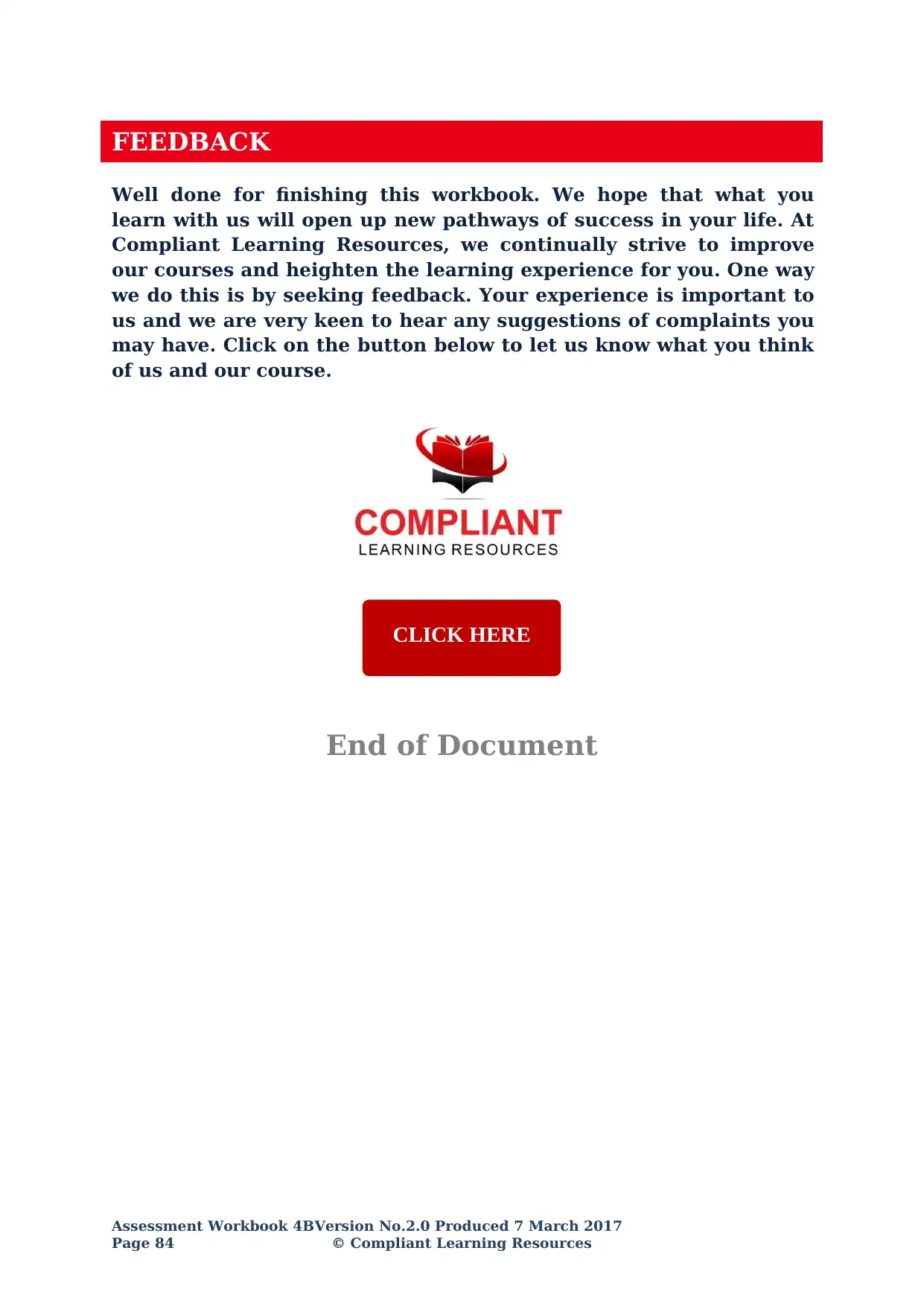
FEEDBACK
Well done for finishing this workbook. We hope that what you
learn with us will open up new pathways of success in your life. At
Compliant Learning Resources, we continually strive to improve
our courses and heighten the learning experience for you. One way
we do this is by seeking feedback. Your experience is important to
us and we are very keen to hear any suggestions of complaints you
may have. Click on the button below to let us know what you think
of us and our course.
End of Document
Assessment Workbook 4BVersion No.2.0 Produced 7 March 2017
Page 84 © Compliant Learning Resources
CLICK HERE
Well done for finishing this workbook. We hope that what you
learn with us will open up new pathways of success in your life. At
Compliant Learning Resources, we continually strive to improve
our courses and heighten the learning experience for you. One way
we do this is by seeking feedback. Your experience is important to
us and we are very keen to hear any suggestions of complaints you
may have. Click on the button below to let us know what you think
of us and our course.
End of Document
Assessment Workbook 4BVersion No.2.0 Produced 7 March 2017
Page 84 © Compliant Learning Resources
CLICK HERE
1 out of 84
Related Documents
Your All-in-One AI-Powered Toolkit for Academic Success.
+13062052269
info@desklib.com
Available 24*7 on WhatsApp / Email
![[object Object]](/_next/static/media/star-bottom.7253800d.svg)
Unlock your academic potential
© 2024 | Zucol Services PVT LTD | All rights reserved.





